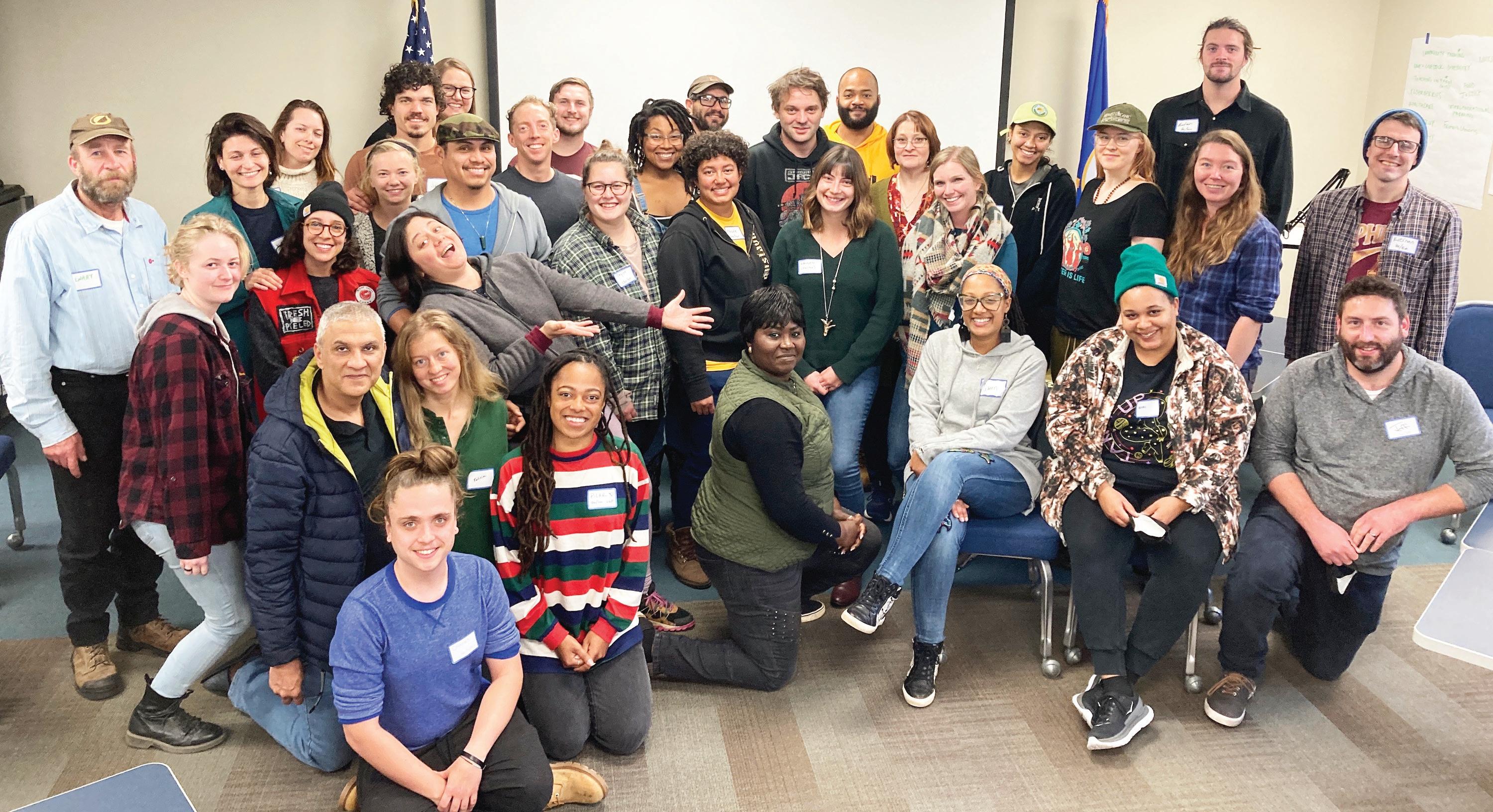
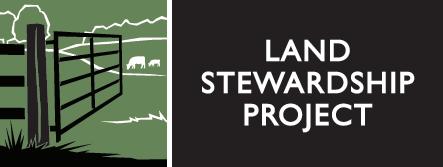
Volume 41 landstewardshipproject.org Number 1, 2023 The Land Stewardship Letter 41 Years of Keeping the Land & People Together A day in the life of a Farm Beginnings class (page 21). u —40 Stories for 40 Years— —New LSP Leadership— —MN Legislative Wrap-up— —Going Beyond Food Rock Stars— — Creating Climate Resilience— —Soil Health’s Pay Dirt Payoff— —Grain By Grain—
Photo by Nick Olson
The Land Stewardship Letter is published by the Land Stewardship Project, a private, nonprofit organization. The Land Stewardship Project’s mission is to foster an ethic of stewardship for farmland, to promote sustainable agriculture, and to develop healthy communities. Members of the Land Stewardship Project receive this publication as a benefit. Annual membership dues are $35.
All inquiries pertaining to the Land Stewardship Letter should be addressed to the editor, Brian DeVore, 4917 Nokomis Avenue South, Minneapolis, MN 55417; phone: 612-816-9342; e-mail: bdevore@landstewardshipproject.org.
BOARD OF DIRECTORS
Deborah Allan, Laurie Driessen, Laura Frerichs, Jon Jovaag, Jody Lenz, Dan McGrath, Les Macare, Sara Morrison, Darrel Mosel, Beth Slocum, Kristin Tombers, Paula Williams
STAFF
Southeastern Minnesota
180 E. Main St., P.O. Box 130, Lewiston, MN 55952; phone: 507-523-3366; fax: 2729;
e-mail: aromano@landstewardshipproject.org
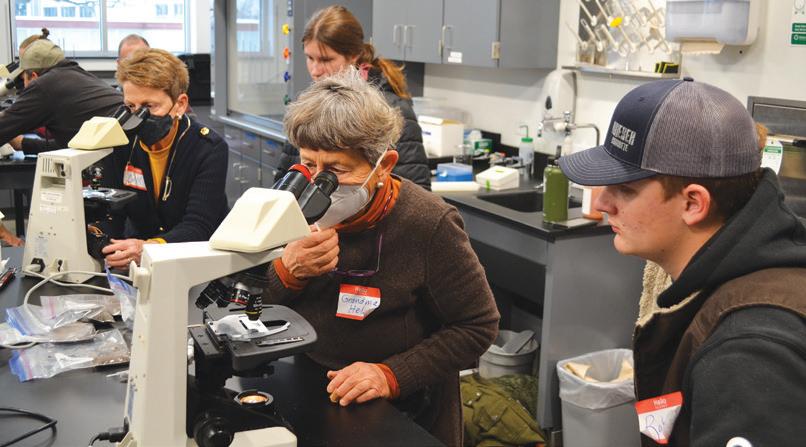
Annelie Livingston-Anderson, Maura Curry, Martin Moore, Alex Romano, Karen Stettler
Western Minnesota
117 South 1st Street, Montevideo, MN 56265; phone: 320-269-2105; fax: 2190;
e-mail: rmoore@landstewardshipproject.org
Amy Bacigalupo, Scott DeMuth, Pilar Ingram, Robin Moore, Nick Olson, Matthew Sheets
Twin Cities
821 East 35th St., Suite 200 Minneapolis, MN 55407; phone: 612-722-6377; fax: 6474; e-mail: info@landstewardshipproject.org
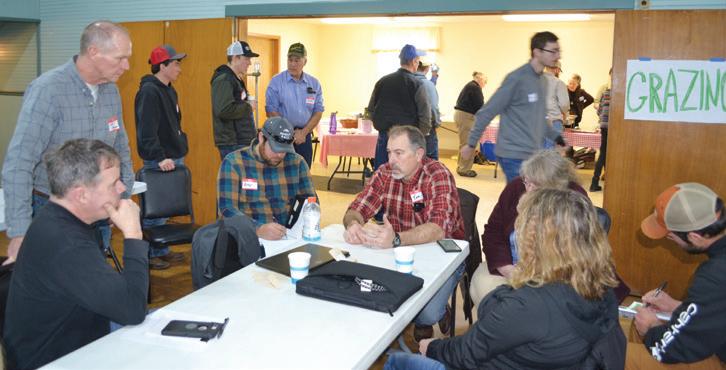
Olivia Blanchflower, Sean Carroll, Brian DeVore, Scott Elkins, Natalia Espina Talamilla, Sarah Goldman, Josh Journey-Heinz, Amanda Koehler, Elizabeth Makarewicz, Emily Minge, Timothy Kenney, Clara Sanders, Megan Smith, Charles Spencer
Stewardship Roots…3
• 40 Stories for 40 Years
Myth Buster…4
• Using the Courts to Short-Circuit Public Participation
LSP News…5
• New Leadership at LSP
• LSP Staff Update
• Get Current with LIVE-WIRE
• Need an LSP Speaker?
Policy & Organizing…7
• Minn. State Legislative Wrap-up
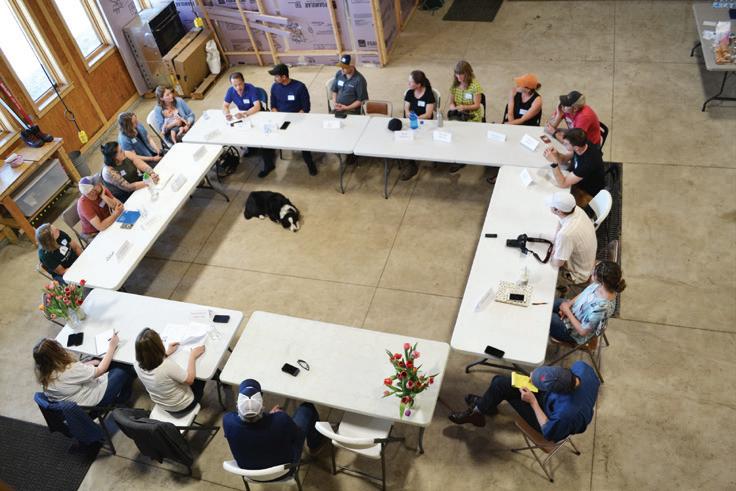
• Rural Healthcare Wins
• Land Stewardship Action Fund
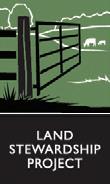

• Return of the Family Farm Breakfast
• Thanks to the Breakfast Suppliers
• 2023 Farm Bill
• Young Farmers & Climate Change
Community Food Systems…14
• Beyond the Charisma
• Why Food Webs Matter
Soil Health…16
• Pay Dirt: 6 Economic Lessons
• Soil Health by the Numbers
• Ear Dirt podcasts
• Join the Soil Builders’ Network
Climate Resilience…19
• It’s Not You — It’s the Climate
Farm Beginnings…21
• A Sneak Peek at a FB Class
• Applications Being Accepted for 2023-2024 Course
• Farm Beginnings Profiles:
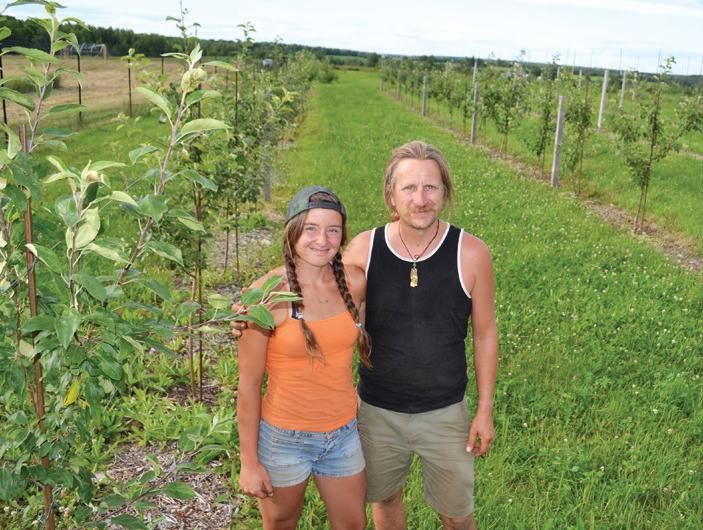
-Thinking Like a Tree
-A Home Away From Home
-Talking Through Tough Choices
• Seeking Farmers-Seeking Land Clearinghouse
Membership Update…34
• Kimmerer Keynote
• Membership Questions?
• Book Honors Joe Morse
• In Memory & in Honor
Stewardship Calendar…36
• Twin Cities Cookout, Pasture Walks, Farm Beginnings Classes
Stewardship Shop…36
• Caps, Bumper Stickers, Barn Signs
Reviews…31
• Milked
• Grain By Grain
• Ground Glass
This LSL printed by Johnson Printers, Rochester, Minn. Volume 41—Number 1, 2023 The
Letter Contents 2 No. 1, 2023 The Land Stewardship Letter
the Land & People Together
Land Stewardship
Keeping
Stewardship Roots
40 Stories for 40 Years
LSP Book Spotlights the Power of People Speaking Up, Speaking Out
From its inception in 1982, the Land Stewardship Project has been rooted in the idea that if we are to create the kind of farm and food system that benefits the land and community, people need to be heard. And one way for them to be heard is by sharing their own stories about why the land, water, and soil, along with their neighbors, are so important. Since the organization was founded by two former journalists — Ron Kroese and Victor Ray — perhaps it’s not surprising that storytelling plays a key role in this organization’s efforts to “promote the best and fight the worst.”
From the Book...
“There were so many powerful days. I met so many people that I consider friends throughout the United States. I just love you guys. I just felt like we’re all family, you know. You were there and I could call. It probably saved me from going insane.”
— Julie Jansen
It hasn’t always been easy to make those voices heard — they threaten to be drowned out by the well-funded cacophony generated by Big Ag and its allies in government. But LSP’s history is full of examples of our organizers helping members tell their stories in local township meetings, through the media, and in state and federal legislative committee hearings. Our members also make themselves heard whenever they host a field day, ask a question at a workshop or community meeting, or share a cup of coffee at the kitchen table.
Because of the key role storytelling plays
in this organization’s history, in 2022 we chose to collect a few of these tales to mark our 40th year of working to keep the land and people together. Some of these stories come out of organizing campaigns, others are simply “aha moments” people had as a result of a meeting, participation in a cohort, or informal interaction they had with other LSP members.
The stories included in Making Change from the Ground Up: 40 Stories for 40 Years of Land Stewardship Project are in no way meant to represent a comprehensive history of LSP. They are simply 40 snapshots from 40 years of work. However, we hope that reading these stories provides people with a sense of how and why LSP does what it does. We also hope that they help inspire 40 more years of working for positive change in our farm and food system — work that will certainly generate even more powerful stories. p
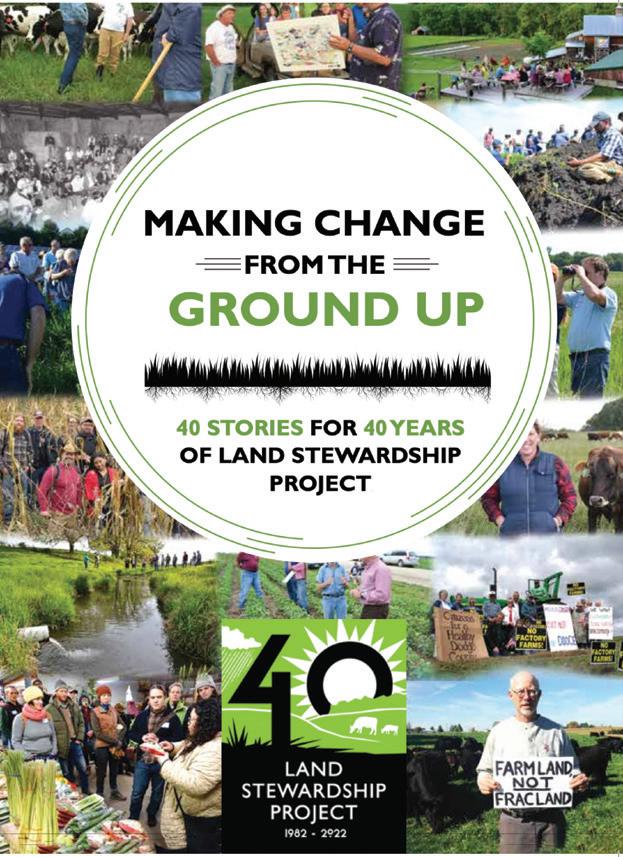
“I’ve seen how LSP, instead of telling people, helped people and continues to help people hear their own voices and listen to each other. I think that’s one of the essential things that’s overlooked, and it takes time. It takes time to listen to each other.”
— Bonita Underbakke
What we do matters, and there will always be a ripple effect. I would like to thank LSP for their leadership influence because their ripple effect is truly endless.
— Tom Cotter
“I remember we had an LSP meeting on frac sand mining, and an organizer said, ‘Raise your hand if you think this is something Land Stewardship should be involved in.’ And I remember raising both my arms.”
Order Your Copy Today
Ma king C hange from the Ground Up: 40 Stories for 40 Years of Land Stewardship Project can be ordered at landstewardshipproject.org/shop or by calling 612-722-6377. The price is $40, plus shipping and handling.
—
— Barb Nelson
The Land Stewardship Letter 3 No. 1, 2023
“When LSP members spoke out against injustice, it stirred decades of impacts.”
— Ken Meter
“I commend Land Stewardship over-and-over again for being that voice and helping most of us get over being a bunch of scaredy-cats and thinking it’s not going to matter.”
Marge Warthesen
Myth Buster Box
An Ongoing Series on Ag Myths & Ways of Deflating Them
➔ Myth: Lawsuits Are Always About Winning
➔ Fact:
Legendary football coach Vince Lombardi was fond of saying, “Winning isn’t everything; it’s the only thing.” But when it comes to legal battles, “winning” is not always the ultimate goal. Or, more precisely, the definition of what we would traditionally think of as winning is turned on its head; sometimes, just making the other side lose is enough.
Take, for example, something called a SLAPP, which is an acronym for “strategic lawsuit against public participation.” When a SLAPP is filed, winning the suit is not the ultimate goal. Rather, it’s an attempt to tie the defendant in legal knots that are expensive, stressful, and, most importantly, intimidating. The goal is to simply exhaust the party being sued to the point that they drop out of public participation. And public participation is important when people are working to determine a positive future for their communities.
Filing lawsuits, even frivolous ones, is not cheap, and a SLAPP can drag on for years. Who has the financial resources to fund an open-ended legal attack? Big Business, that’s who. So it’s no surprise such enterprises are fond of using SLAPP litigation to silence their critics. SLAPP targets are almost always grassroots organizations, individual citizens, even local government bodies such as townships and counties — entities not known for having big legal war chests at their disposal.
Law experts say SLAPPs suppress freedom of speech, threaten to bankrupt individuals and grassroots organizations, and have a general chilling effect on people who want to have a say in what kind of economic activity takes place in their community. This includes people who may serve on a local planning and zoning board, as well as those who simply write a letter-to-the-editor or speak at a public meeting.
The multimillion-dollar suits can be camouflaged as being about “defamation,” “interference with business,” or “conspiracy.” Another characteristic of a SLAPP is the plaintiff’s demand for extensive “discovery” documents, even if they have little, or no, connection to the main lawsuit. The discovery phase of a legal battle can be extremely time consuming and expensive for
defendants, and distracts from the main work a grassroots group or local government body does in fulfilling its mission. “Short of a gun to the head, a greater threat to First Amendment expression can scarcely be imagined,” wrote New York Supreme Court Justice Nicholas Colabella in reference to SLAPPs.
SLAPPs & CAFOs
In the Midwest, owners and backers of large concentrated animal feeding operations (CAFOs) have turned to the SLAPP strategy to silence and intimidate people who speak out against the environmental and economic threats these facilities pose. The news site Grist recently documented several examples of local governing bodies being sued after they put in place ordinances regulating CAFOs. In Wisconsin, industry groups like Venture Dairy Cooperative and the Wisconsin Dairy Alliance (the latter group’s slogan: “Fighting for CAFOs Every Day”) have sent letters threatening lawsuits to communities that dared to pass ordinances or moratoriums. As a result, some local governments have backed off attempting to regulate large livestock facilities.
Minnesota’s communities have significant power to utilize local government to control harmful development. But that hasn’t deterred Big Ag from SLAPPing local residents, grassroots groups, and governing bodies. For example, southeastern Minnesota’s Winona County is in the midst of a yearslong legal battle that has all the makings of a SLAPP. For over 20 years, Winona County has had a policy in place to cap livestock farms at 1,500 animal units (about 1,071 milk cows) to protect the region’s vulnerable geography and to keep small and mid-sized farmers from being forced out by CAFOs. In 2018, Daley Farm requested a variance to the law that would allow it to expand its dairy herd to nearly four times the current limit. Winona County LSP members are concerned about the impact such an expansion could have on drinking water and the local community in general. People have made their voices heard by talking to their neighbors, writing letters-to-the-editor, and holding public rallies.
The Winona County Board of Adjustment carefully considered and denied Daley Farm’s request for a variance. Daley then took to the courts in an attempt to overrule the decision; the Minnesota Court of Appeals declined to
take up the case, and in 2022, the Board of Adjustment again denied the variance.
Frustrated in its attempts to sue Winona County’s government, Daley took a new legal tack. In October 2022, it filed a lawsuit that named individuals who were current and former County Board members, as well as former members of the Board of Adjustment, along with individual organizers who had worked for LSP and the organization itself. The lawsuit accused individuals and LSP as an organization of a “conspiracy” to deny Daley its due process rights and sought damages for supposed “lost profits” due to the expansion’s denial. In short, taking steps to protect one’s community is now considered a conspiracy, according to this legal argument.
Daley dropped this latest lawsuit in March of this year, two weeks before the District Court was to hear the case. In the meantime, significant time, money, and other resources have been spent fighting the lawsuit, and the farm’s owners have announced publicly that they may take it up again in the future.
Winona County residents, as well as LSP, are refusing to back down. They are maintaining that they have a right to speak up and work for their community’s future, even if their activities run counter to the desires of a special interest with powerful allies in industry and state government.
That’s important, because when people participate in self-censorship, it really doesn’t matter what the final legal judgement is — the damage is done. SLAPPs may not be about winning, but there’s no doubt they result in a loss for democracy.
More Information
• “The Big Chill: Are Public Participation Rights Being Slapp-Ed?,” Pace Environmental Law Review, digitalcommons.pace. edu/pelr.
• “A tiny Wisconsin town tried to stop pollution from factory farms. Then it got sued,” Grist , grist.org/accountability/ what-happens-when-citizens-try-regulatefactory-farms.
• More LSP Myth Busters: landstewardshipproject.org/myth-busters.
4 No. 1, 2023 The Land Stewardship Letter
LSP News
LSP Board Names New Executive Director
Agrassroots organizer with decades of experience empowering local communities around environmental and sustainability issues has been named the Land Stewardship Project’s new executive director, the organization’s board of directors announced in June. Scott Elkins, who took the helm at LSP June 20, is also leading the organization’s 501(c)(4) political leadership development partner, the Land Stewardship Action Fund (LSAF).
The child and grandchild of Texas cattle ranchers, Elkins brings to this position three decades of experience working on environmental and justice issues at the grassroots level. His new role represents a return to the organization — Elkins worked as an LSP organizer in the late 1990s, where he focused on helping communities protect farmland in the Twin Cities Metropolitan Area. For the past two decades, he has worked for the Sierra Club at the state and national level. Most recently, he served as the organization’s national director of volunteer and leader engagement. Previously, he served as the Sierra Club’s director of grassroots effectiveness and, before that, as the director of the Minnesota chapter.
“We are excited to have Scott on board at LSP; he brings years of experience organizing people around making their communities better places to live and work,” says Beth Slocum, who chairs LSP’s board of directors and farms near Welch in southeastern Minnesota. “His personal and professional background shows he deeply believes in our mission to promote stewardship of the land and the health of rural communities through regenerative, family farm-based agriculture. Scott truly is committed to the values and vision of our member-led organization, and we are eager to work with him to grow LSP’s powerful, positive impact in our rural communities and across the agricultural landscape.”
Elkins says he is passionate about empowering local people who are dedicated to creating sustainable, resilient communities. Too often when it comes to discussions about economic sustainability and environmental health, farming communities are written off as “sacrifice zones,” he says.
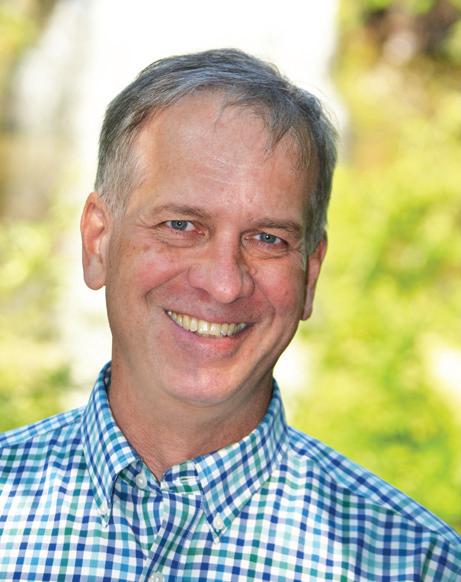
“LSP has always been a leader in amplifying the voices and stories of people in communities that are neglected and silenced.
I am excited to help lead its talented staff as we focus on building and supporting that critical area where farming, food, communities, and ecological health intersect.”
Elkins begins his leadership of LSP at a time when the 41-year-old organization is expanding its work in the areas of soil health, beginning farmer training, farm business transition, policy, and community food systems. LSP’s work in these areas had a significant impact on the recently adjourned session of the Minnesota Legislature. The organization’s members had unprecedented success advancing a set of policy proposals that support regenerative agriculture, soil
LSP’s Long Range Plan
The Land Stewardship Project has outlined its long range goals and how we will go about achieving them in Vision for the Future: 5 Year Plan 2019-2024. The plan is based on five core values:
➔ Stewardship is the value of living in right relationship with the land and all that is connected to it: the soil, the water, the air, the plants, microorganisms, animals, and our climate. It means giving to the land and receiving from it, and caring about the entire biotic community. Conservation-minded farmers who live on the land, farm it, and care for it are essential to stewardship of farmland.
➔ Justice means there is economic, racial, and gender equity for farmers, workers, and all those who are engaged in the food and agriculture system. It means the achievement of related rights like food sovereignty for all communities, and highquality healthcare for everyone.
health, community food systems, emerging farmers, rural communities, healthcare reform, and landscape sustainability (see page 7).
“I think LSP’s recent success pushing through policies that are fueled by its work shows that the constituency we represent carries a lot of value and integrity with policy makers,” says Elkins. “It goes to show LSP’s efforts to lift up the voices of farmers, rural residents, and anyone else who cares about the future of the land is needed now more than ever.”
Elkins takes the reins from Amy Brugh, who has served as LSP’s interim executive director since January, when Mike McMahon stepped down as the organization’s leader. McMahon is now an organizer with Addition, a national group that is working to spark grassroots efforts in areas underserved by organizing. During the past six months, Brugh bolstered LSP’s internal infrastructure and worked with the staff and board to usher in permanent leadership.
“Amy has done a phenomenal job providing the kind of stability our staff requires to do the critical work that needs done while setting LSP up well for permanent leadership,” says Slocum. “We greatly appreciate the good counsel and depth of experience she contributed to this transition period.”
Scott Elkins can be reached at selkins@ landstewardshipproject.org or 612-4006352. p

➔ Democracy means a society in which the people hold the power to govern, in which those people directly impacted by issues name solutions, set priorities, and win change. It means the health and wellbeing of people and the land are put before corporate profits.
➔ Health is the value of nourishing the beauty, function, and vitality of an ecosystem made up of people, landscapes, plants, animals, soil, and water. The health of the land is a gift that current generations are obligated to provide for future generations.
➔ Community is the value of understanding our interdependence and caring for the relationships that sustain each of us. Living in community we are more resilient, creative, resourceful, and powerful — we have greater ability to be the change we seek in the world.
A copy of the plan can be viewed and downloaded at landstewardshipproject. org/long-range-plan. For a paper copy, call 612-722-6377.
The Land Stewardship Letter No. 1, 2023 5
Scott Elkins
LSP News
LSP Staff Update
Shona Langseth has stepped off the Land Stewardship Project’s soil health team to join the Olmsted County, Minn., Soil and Water Conservation District as a soil conservation technician. Langseth joined LSP’s staff in 2016, and for the past eight years has helped build the organization’s Bridge to Soil Health initiative. During her tenure, among other things, Langseth helped create and grow the Soil Builders’ Network (see page 18), which now consists of hundreds of farmers and others in the region who regularly share information on profitable ways to support soil health practices. Most recently, she served as the overall director of LSP’s Soil Health Department and coordinated the Johnson-Su Bioreactor research project (landstewardshipproject.org/soil-health/microbiologysoil-health).
Barb SognFrank recently departed LSP’s staff after working the past two years in its Soil Health Department. Sogn-Frank had previously worked as an LSP policy organizer.
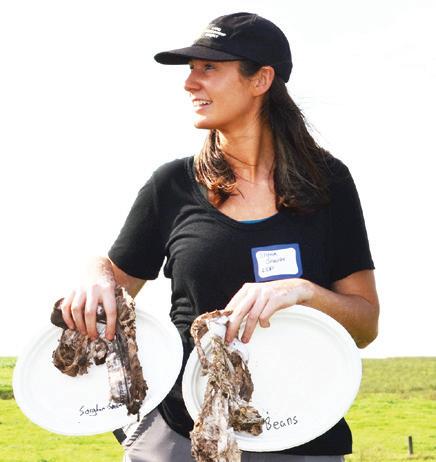
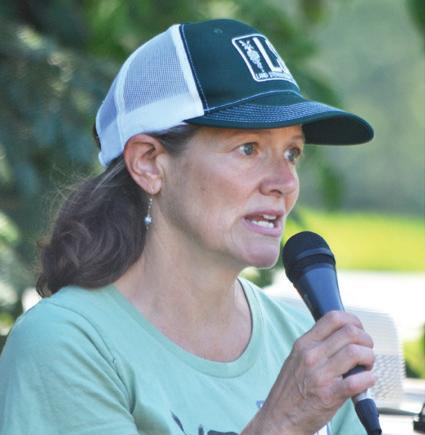
Through her position on the soil health team, she helped organize a successful series of field days and workshops focused on cover cropping, diverse rotations, small grains, and no-till. Sogn-Frank also helped coordinate a highly visible soil health billboard campaign in southern Minnesota and was part of the team that organized the Robin Wall Kimmerer 40th Anniversary Event in January (see page 34).
Haze Harrison has wrapped up work as the organizer of LSP’s 2023 Family Farm Breakfast, which was held in April (see page 10). Harrison moved to Minnesota in 2017 from her hometown of Missoula, Mont., to attend Macalester College, where she studied history and dance. During the past five years, Harrison has organized with several campaigns for social and climate justice, including the “Stop Line 3” campaign in northern Minnesota. Through that work, she served as one of the editors of Even the River Starts Small: A Collection of Stories from the Movement to Stop Line 3, which was published this spring.
Paula Williams recently wrapped up a stint organizing around LSP’s healthcare priorities during the 2023 session of the Minnesota Legislature.
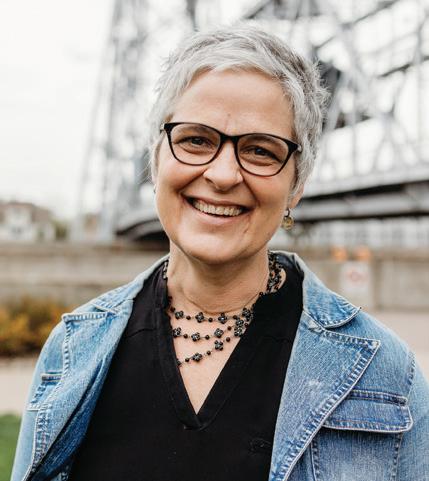
Williams has been a volunteer on the LSP Healthcare Steering Committee since 2016 and an LSP board member since 2019. During the 2023 legislative session, she worked with members and allies to push through initiatives to make affordable, quality healthcare accessible to more people (see page 8).
Martin Moore has joined LSP’s staff as a policy organizer.

Moore grew up in Montevideo, Minn., and has a bachelor’s degree in environmental studies from Macalester College. He has worked as a high school teacher in Hawai’i, an instructor at the Montana Outdoor Science School, an education mentor at the Eagle Bluff Environmental Learning Center, and an outreach intern for the Campaign to Save the Boundary Waters.
Moore is based out of LSP’s office in Lewiston, Minn. He can be reached at mmoore@landstewardshipproject.org or 612-767-9881.
Rin Kilde is serving a summer LSP internship, during which she’s helping put on the Twin Cities Cookout on July 27 (see page 36).
Kilde recently graduated from St. Catherine University, where she received a bachelor’s degree in public policy, with a communications studies
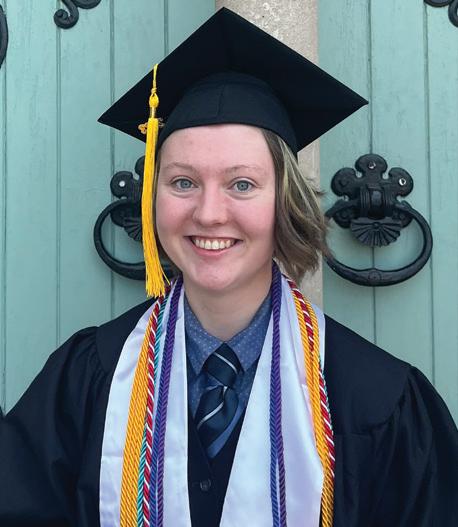
minor. She has worked at the Minnesota Center for Diversity in Economics and was a member of St. Catherine’s Community Work and Learning Project staff. Kilde grew up in western Wisconsin and has experience working with both urban and rural agriculture and gardening. p
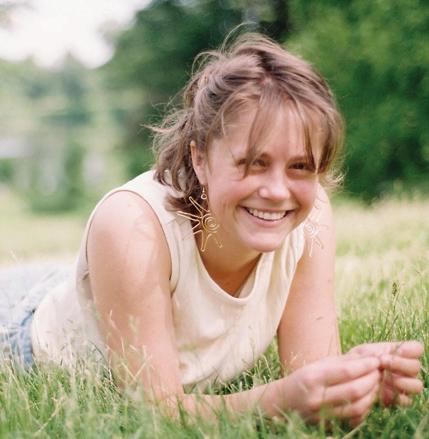
Get Current With
Sign up for the LIVE-WIRE e-letter to get monthly updates from the Land Stewardship Project sent straight to your inbox. Details are at landstewardshipproject. org/live-wire-sign-up. p


6 No. 1, 2023 The Land Stewardship Letter Want Someone to Speak about LSP’s Work to Your Group? Would others in your community or a group you’re a part of be interested in learning about the Land Stewardship Project’s work? Staff members are available to speak about our various initiatives. Contact us at info@landstewardshipproject.org or 612-722-6377 to learn more and to get something set up. For details on other ways to connect with LSP, see landstewardshipproject.org/connect-with-lsp.
Barb Sogn-Frank
Shona Langseth
Paula Williams
Haze Harrison
Martin Moore
Rin Kilde
Policy & Organizing
State Policy
Lawmakers Invest in Soil Health, Regional Food Systems, Emerging Farmers & Water Quality
By Laura Schreiber & Amanda Koehler
Earlier this year, Land Stewardship Project members leveraged an historic Minnesota legislative session to win, after decades of underfunding, record investments in sustainable and regenerative agriculture, small and mid-sized farmers, and rural communities. People power made these wins possible. Here are some organizing highlights:
➔ We held the largest Family Farm Breakfast and Lobby Day in LSP history, with more than 300 people participating (see page 10).
➔ We held four town hall meetings with key elected officials, featuring small and emerging farmers, farmers’ market managers, and rural leaders.
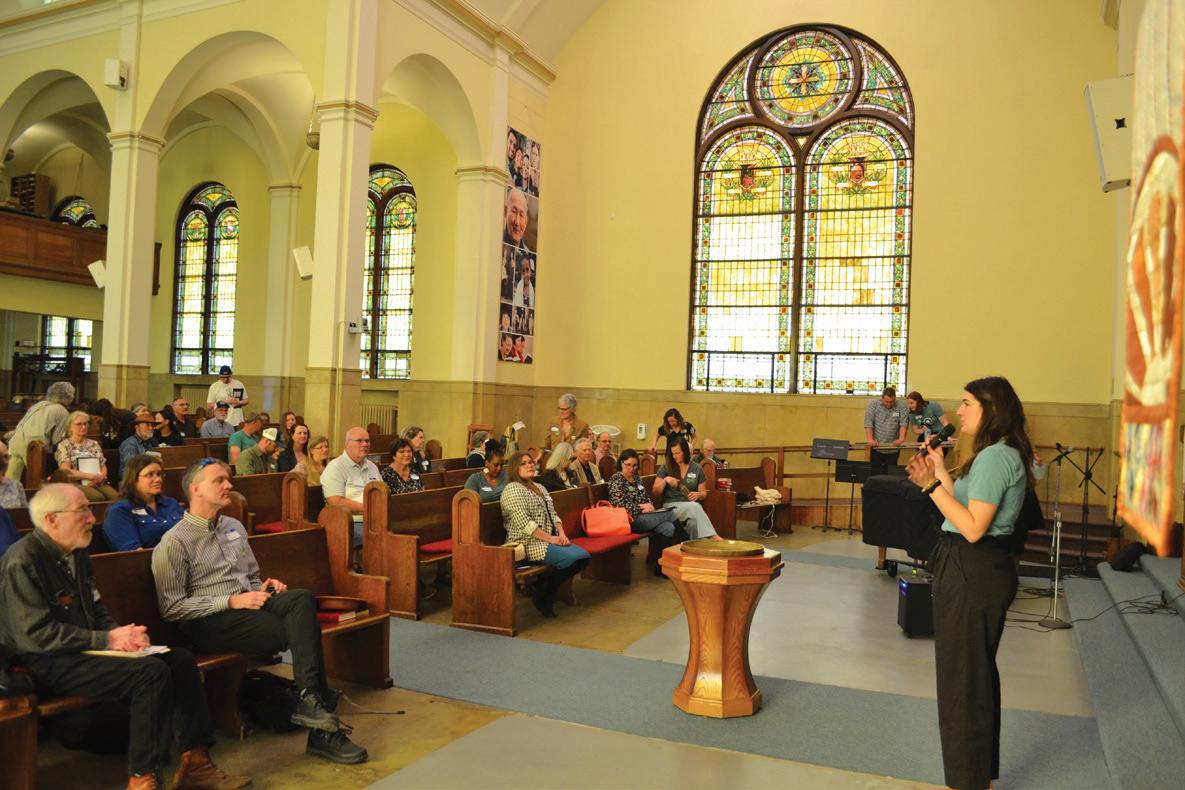
➔ Twenty-five LSP farmers, processors, and rural leaders shared their stories at legislative hearings in support of our priorities for people and the land.
and various pollinator protections.
➔ Regional Food Systems: We won the establishment of Meat Processing Liaison and Farm-to-School Coordinator positions within the MDA. Also made available was record funding for local food systems via the Farm-to-School Grant Program, the Good Acre’s Local Emergency Assistance Farmer Fund (LEAFF), the Urban and Youth Agriculture Grant Program, the Good Food Access Program, SNAP/EBT infrastructure for farmers’ markets, the Minnesota Grown Program, and the Healthy Eating Here at Home Program (i.e. Market Bucks). Additionally, we won funding for local meat processing training, retention, and development.
➔ Emerging Farmers & Land Access: We won historic funding for the Emerging Farmers Office; increased funding and important policy changes to the Farmland Down Payment Assistance Program; and the renewal of and important policy changes to the Beginning Farmer Tax Credit.
LSP members and allies participated in a lobby training after the 2023 Family Farm Breakfast (see page 10). Over 1,100 LSP members and supporters engaged in legislative organizing during this session by attending events, signing petitions, and contacting their legislators, as well as the Governor. (LSP Photo)
➔ Over 300 farmers, processors, and marketers signed our letter calling for significant investments in emerging and small-scale farmers, local meat processing, local food systems programming and infrastructure, and soil health.
➔ Over 1,100 LSP members and supporters engaged in our legislative organizing during this session by attending events, signing petitions, and contacting their legislators, as well as Governor Tim Walz.
➔ LSP deepened our partnership with several allied organizations.
➔ LSP attended the signing of the Omnibus Agriculture, Broadband, and Rural Development Bill at Medicine Creek Farm, which is owned and operated by Hannah Bernhardt, a farmer-leader within LSP, the Minnesota Farmers Union, Climate Land Leaders, and the Emerging Farmers Working Group.
Major wins that resulted from this powerful organizing, strong partnerships, and favorable legislative dynamics include:
➔ Soil Health: We won the establishment of a fulltime Climate Coordinator Position within the Minnesota Department of Agriculture (MDA); over $44 million for soil health cost-share and grant programs; over $50 million for Soil and Water Conservation Districts (SWCDs); over $4 million per year for the development and commercialization of continuous living cover crops; a ban on PFAS and PFOS chemicals in pesticides;
➔ Factory Farming & Water Quality: We won comprehensive changes to fish kill investigations as well as millions of dollars for private well and drinking water testing. We also won the passage of the Frontline Communities Protection Act, which creates stronger permitting requirements for facilities seeking to emit pollutants in “environmental justice” areas, and requires the Minnesota Pollution Control Agency (MPCA) to evaluate existing pollution in an area when issuing a new permit. Unfortunately, corporate polluters were successful in limiting the scope of the Frontline Communities Protection Act to the Twin Cities seven-county metropolitan area, Duluth, and Rochester, making the bill unlikely to be a tool to address factory farm proposals.
➔ Fair Farm Economy: Passed was a voluntary Grain Indemnity Fund (championed by the Minnesota Farmers Union); full funding for the state Attorney General’s Office; $8 million for the Dairy Assistance, Investment, and Relief Initiative (DAIRI) Program; and additional funding for the Farm Advocates Program.
➔ Healthy, Robust Rural Communities: We won a MinnesotaCare Public Option;
Legislature, see page 8…
The Land Stewardship Letter No. 1, 2023 7
Organizing works – and that’s what we’ll continue to do to ensure these wins are successfully implemented.
Policy & Organizing
…Legislature, from page 7
establishment of a Prescription Drug Affordability Board; a prohibition on hospital mergers that drive consolidation; Paid Family and Medical Leave; Earned Sick and Safe Time; and $125 million for the Borderto-Border Broadband Fund.
➔ Farm & Food System Workers: Passed was the Safe Workplaces for Meat and Poultry Processing Workers Act (championed by UFCW Local 663); the inclusion of farmworkers in Paid Family and Medical Leave; the inclusion of non-citizen Minne-
sotans in the MinnesotaCare Public Option; and the restoration of the Driver’s Licenses for All law.
Citizens’ Board Stymied
This session’s biggest disappointment is that our effort to reinstate community oversight of the Minnesota Pollution Control Agency by re-establishing the Citizens’ Board was not successful. Opposition from corporate agriculture and mining interests, as well as a lack of support from the MPCA and Governor Walz, Reps. Jeff Brand (DFL – St. Peter), Luke Frederick (DFL – Mankato), Dave Lislegard (DFL – Aurora), and Gene Pelowski (DFL – Winona) killed the bill through closed-door meetings. But we made significant progress and are not done fighting for a Minnesota Pollution Control Agency that puts people and our environment before corporate polluters’ profits.
Learn more about all of these legislative wins by checking out our full blog at landstewardshipproject.org/2023-minnesotalegislative-session-wrap-up.
Together, we made tangible progress toward building a farm and food system that is truly sustainable and just for farmers, workers, and consumers as we collectively face climate change, consolidation, and the hollowing out of rural communities. Organizing works — and that’s what we’ll continue to do to ensure these wins are successfully implemented while preparing for the 2024 legislative session. p
LSP policy organizer Laura Schreiber can be reached at lschreiber@ landstewardshipproject.org; Amanda Koehler, the organization’s policy manager, is at akoehler@landstewardshipproject.org.
Organizing Secures Key Wins for Rural Healthcare
MinnesotaCare Public Option & Prescription Drug Affordability Board are Strong Steps Forward
By Paula Williams & Amanda Koehler
The Land Stewardship Project began organizing around healthcare in 2008 after hearing repeatedly from our members that one of the primary barriers to getting into farming — or staying in it — is lack of access to affordable and useful health insurance. Farmers and other self-employed people do not have employerbased healthcare coverage without off-thefarm or additional jobs. They also often have variable incomes, making it difficult to consistently qualify for governmentsponsored programs like MinnesotaCare Moreover, having insurance doesn’t necessarily mean care is affordable, accessible, or of high-quality. People often have to delay or skip necessary medical care because they can’t afford the high out-of-pocket expenses if coverage is denied or they have high deductibles or co-payments. In rural areas in particular, it is hard to find in-network services when and where they are needed.
After years of grassroots organizing for accessible, affordable, high-quality healthcare for all Minnesotans, regardless of income, age, zip code, or immigration status, LSP is celebrating two strong steps in the right direction during the recently adjourned session of the state Legislature (see page 7).
These steps are represented by the passage of a MinnesotaCare Public Option and the Prescription Drug Affordability Board. Originally called the MinnesotaCare Buy-In, the Public Option expands access to affordable health coverage for more Minnesotans by allowing those without access to employer-based coverage the option of purchasing a plan from this well-tested public program, paying an affordable premium based on their income. Currently, MinnesotaCare is only available to working Minnesotans with an income below 200% of the federal poverty line or $55,000 per year for a family of four. This leaves many no other option but to buy insurance on the individual health insurance market, which is plagued by ever-rising deductibles and out-of-pocket maximums of as much as $7,000 to $20,000 a year.
Services estimates that 300,000 Minnesotans are uninsured. A disproportionate number of uninsured Minnesotans are Black, Indigenous, and/or people of color, and 17% are undocumented immigrants. As an organization committed to transforming the food and farm system, we have consistently advocated for a healthcare infrastructure that leaves no one behind.
Spending over $1 billion on the “reinsurance” program has not fixed the problems of Minnesota’s individual health insurance market or expanded coverage. (The statebased reinsurance program is designed to stabilize premiums in Minnesota’s individual health insurance market by partially reimbursing insurers for high-cost claims.) Instead of continuing to spend enormous resources subsidizing a broken health insurance system, Minnesota can now direct our healthcare dollars toward a better quality, affordable public health insurance option. The MinnesotaCare Public Option will be paid for with state and federal funds, premiums, and cost-sharing.
Healthcare, see page 9…
Another key aspect of expanding MinnesotaCare this session was ending the ban on coverage for Minnesotans without citizen status. Currently, thousands of undocumented workers and families, many on the frontlines of our food and farming system, are left without healthcare when they need it most. The Minnesota Department of Health
Give it a Listen
OnEar to the Ground podcast episode 310, Paula Williams talks about the gains made on healthcare during the 2023 session of the Minnesota Legislature: landstewardshipproject.org/podcast/ ear-to-the-ground-310-healthy-farmershealthy-land.
8 No. 1, 2023 The Land Stewardship Letter
One of the primary barriers to getting into farming, or staying in it, is lack of access to affordable and useful health insurance.
…Healthcare, from page 8
Now that the MinnesotaCare Public Option has passed, agencies can begin conducting an actuarial analysis to determine how many Minnesotans are likely to enroll, and determine the premium costs based on that information. Minnesota’s Department of Health Services will also start the process of applying for the federal waiver to redirect federal healthcare dollars to the public option.
The Prescription Drug Affordability Board (PDAB) will have the power to rein in skyrocketing medication prices that Minnesotans rely on to survive and thrive by carefully setting upper payment limits on highcost drugs. For too long, pharmaceutical corporations have legally been allowed to price-gouge when it comes to medicine — driving up costs at the pharmacy and across our entire healthcare system. Our current system works well for the industry’s profitgenerating stakeholders, but it’s certainly not working well for patients. Even if you aren’t on a high-cost drug, we all pay the price for drug companies’ greed through higher costs for premiums, deductibles, and other out-of-pocket costs. In the words of Minnesota Attorney General Keith Ellison, who was a strong advocate for this legislation, “No one should have to choose between affording their medications and affording to live.”
across the finish line by:
u Holding hundreds of constituent meetings with state legislators at LSP Family Farm Breakfasts and in-district meetings and events, as well as coalition lobby days.
u Sharing our stories in dozens of legislative hearings and at rallies.
Drug Affordability Board and Provider Tax, as well as oppose reinsurance and other false solutions.
u And more. In the end, people power prevailed!
Expanded access to MinnesotaCare will help make lives more sustainable, reliable, and affordable for farmers and others without access to employerbased coverage in communities across our state, as well as early retirees and young people who age off their parents’ insurance. This expanded public program will make Minnesota a place where culture, innovation, small businesses, and local economies can thrive.
LSP members recently gathered to discuss advancements made in healthcare policy during the 2023 session of the Minnesota Legislature. The organization got involved with the issue after farmers made it clear lack of access to affordable, quality healthcare was a major impediment to their success on the land. (Photo by Paula Williams)
u Publishing dozens of letters-to-theeditor in newspapers across the state.
u Holding several town hall meetings with Attorney General Ellison and other key leaders.
u Gathering thousands of petition signatures calling on state leaders to champion affordable, accessible, highquality healthcare solutions.
These wins are great encouragement for the road ahead. Healthcare legislation and its implementation are complicated and there are many pieces to the complex puzzle. Undocumented workers should be able to start buying into the current MinnesotaCare program by 2025 and the MinnesotaCare Public Option should be rolling out in 2027. This means, of course, that there’s more work to be done by people’s organizations like LSP and our partners at groups such as Minnesota Farmers Union, TakeAction, SEIU, UNIDOS, Minnesota Nurses Association, AARP, Springboard for the Arts, Mainstreet Alliance, ISAIAH, AFL-CIO, and the MN Budget Project to ensure everyone has the healthcare they need. p
For 15 years, LSP member-leaders have worked to get the MinnesotaCare Public Option with immigrant inclusion, as well as the Prescription Drug Affordability Board,
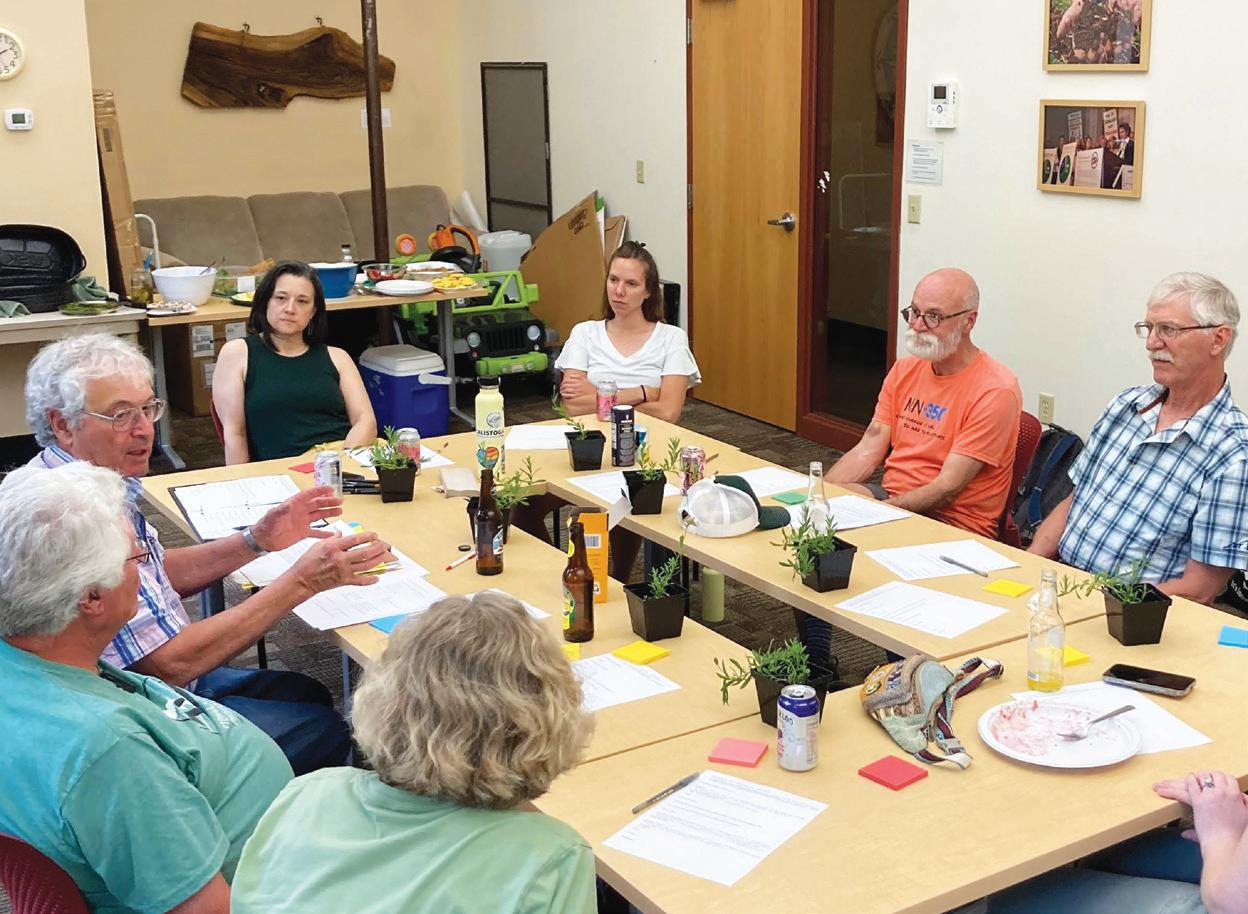
u Sending thousands of e-mails and making countless calls to our lawmakers, urging them to support the MinnesotaCare Public Option and the Prescription
Paula Williams is an LSP memberleader from Barnum, Minn., who recently led LSP’s healthcare organizing work in a short-term staff role. For more information on LSP’s healthcare work, see landstewardshipproject.org/healthcare.
Want to Have a Policy Impact? Connect with Land Stewardship Action Fund
In February 2018, the Land Stewardship Project’s board of directors created the Land Stewardship Action Fund (LSAF), a 501(c)(4) partner organization, because they recognized the power that comes with being able to drive forward the mission and goals of LSP with an expanded set of political and electoral tools.
LSAF came out of the realization that our members and leaders could no longer sit on the sidelines in the current political environment, but instead must proactively engage in elections so that we have a say in who is elected and representing us.
For more information on LSAF and to get involved in such initiatives as voter education and deep canvassing, see landstewardshipaction.org or contact Emily Minge at eminge@landstewardshipaction.org, 612-400-6353.
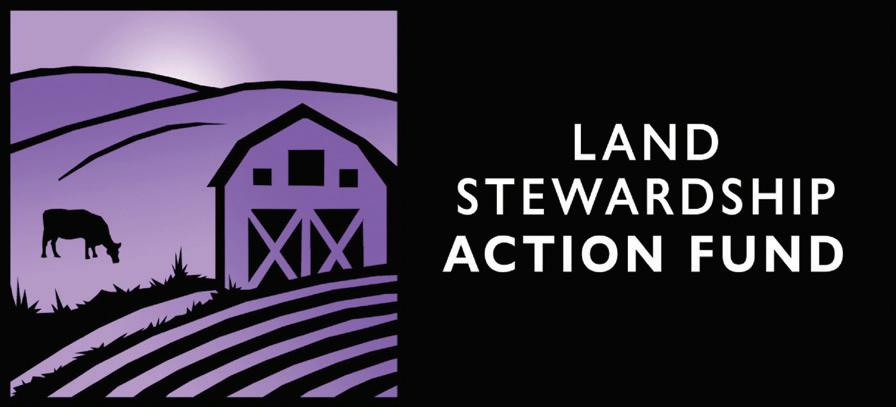
The Land Stewardship Letter No. 1, 2023 9
& Organizing
The Return of the Family Farm Breakfast
By Amanda Koehler
On April 13, over 300 Land Stewardship Project members, supporters, staff, and elected and appointed public officials gathered in Saint Paul, Minn., for our 17th Family Farm Breakfast and Lobby Day – the largest Family Farm Breakfast in LSP history!

This year, the event was co-hosted by Clean Up the River Environment, Climate Land Leaders, Greener Pastures, the Latino Economic Development Center, the Minnesota Farmers Market Association, and The Good Acre. These are all sustainable agriculture or rural organizations that share our vision for people and the land.
Over a delicious meal featuring products from LSP members’ farms (prepared by the Chowgirls; see the sidebar on page 11), folks built community, interacted with public officials, and listened to a powerful program. Attendees included Minnesota Department of Agriculture (MDA) Commissioner Thom Petersen and members of his staff; Minnesota Pollution Control Agency (MPCA) Commissioner Katrina Kessler and members of her staff; members of the Minnesota House and Senate and their staff; and staff from the offices of U.S. Representatives Angie Craig and Tom Emmer, as well as staffers from the offices of U.S. Senators Tina Smith Amy Klobuchar.
The Family Farm Breakfast program was fully LSP-member run. LSP board chair and livestock farmer Beth Slocum emceed the program and highlighted numerous victories over LSP’s 41-year history. It featured poetry from Michael Chaney of Project Sweetie Pie, testimonials on the importance of reinstating the Minnesota Pollution Control Agency Community Board from former MPCA Citizens’ Board member and LSP member Loni Kemp, along with LSP member Adam Muschler. Vegetable farmer Naima Dhore and hog farmer Dayna Burtnesson also talked about the importance of building a farm and food system where there are more people on the land sustainably
growing food for their communities
After the Family Farm Breakfast, approximately 150 LSP members, supporters, and partners went to the state Capitol complex to advance our legislative agenda for people and the land. Together, we met with approximately 90 state legislators (almost 50% of the Legislature). Our top priorities for the day were:
➔ Restoring community oversight of the Minnesota Pollution Control Agency by reinstating the MPCA Citizens’ Board.
➔ Ensuring all Minnesotans have the
In addition to constituent meetings with state legislators, we held three town hall meetings with key public officials. First, was a town hall with Rep. Kristi Pursell (DFL – Northfield), who is the vice chair of the House Agriculture Committee, and Sen. Rob Kupec (DFL – Moorhead), who is the vice chair of the Senate Agriculture Committee. LSP member and farm-to-school program manager Aimee Haag and vegetable farmer John Fisher-Merritt passionately spoke to the importance of expanding our state’s investment in the Farm-to-School Grant Program, establishing a fulltime Farm-to-School coordinator at the Minnesota Department of Agriculture, and establishing regional food system coordinator positions across the state. Farmer Lori Cox spoke to the importance of reinstating community oversight of the MPCA. Farmers John Snyder (Preston, Minn.) and Michelle Boyechko (Tamarack, Minn.) spoke to the importance of investing in soil health, as well as supporting our rural communities. We also held an open Q and A session for audience members to directly interact with Rep. Pursell and Sen. Kupec.
Next was a town hall with Minnesota Attorney General Keith Ellison. LSP members James Kanne, John Snyder, and Tim Ahrens spoke to Ellison about the need to address consolidation in agriculture. Members Al Kruse and Aleta Borrud, along with LSP board member Paula Williams, spoke about the importance of establishing a Prescription Drug Affordability Board to ensure medications are affordable for all Minnesotans.
affordable care they need when and where they need it by creating a MinnesotaCare Public Option and establishing a Prescription Drug Affordability Board (PDAB).
➔ Finalizing a robust agriculture budget that delivers for beginning and emerging farmers, small and mid-sized farmers, farmers facing financial stress, and local meat and poultry processors, along with our soil, water, pollinators, and climate.
(See page 7 for a summary of what policies LSP was able to advance before the legislative session adjourned in May.)
The last town hall was with Jason Garms, who is a part of the Government Relations team at the Minnesota Department of Natural Resources. Livestock farmer Terry VanDerPol, along with other LSP members, spoke to issues related to excessive water use by factory farms, human-caused fish kills, water quality, and Indigenous land issues.
We also held a conversation on emerging farmer issues with Julia Wickham of Senator Smith’s Office; MDA Assistant Commissioner Patrice Bailey; and MDA staff members Jenny Heck, Val Gamble, and Lillian Otieno. Emerging farmers participated in this discussion and talked about state and federal policy solutions related to improving land access and providing support. p
LSP policy manager Amanda Koehler is at akoehler@landstewardshipproject.org or 612-400-6355.
10 No. 1, 2023 The Land Stewardship Letter
Policy
State Policy
LSP has held 17 Family Farm Breakfast and Lobby Day events over the years. (LSP Photo)
Volunteers helped with the Family Farm Breakfast and Lobby Day by doing everything from greeting and registering guests to setting up beforehand and cleaning up afterwards.
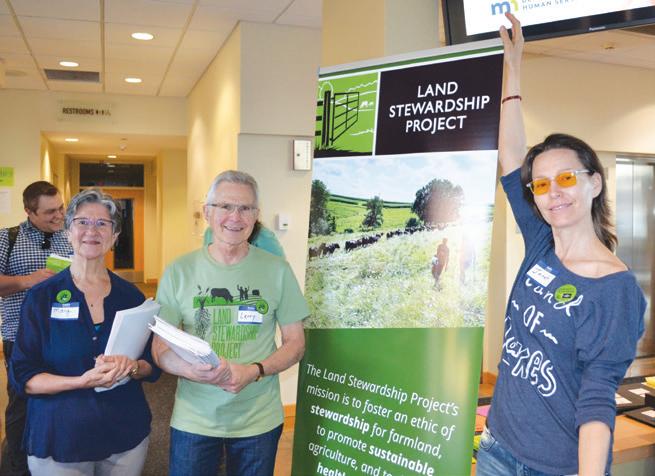
Thanks to Those Who Fueled the Breakfast
Thank you to Chowgirls Catering (pictured) for making the Family Farm Breakfast meal possible. Without Chowgirls’ generous donation of time, ingredients, and servingware, this meal would not have been able to come together at an affordable price.

The Food Suppliers
Also, thanks to our ingredient suppliers: Ames Farm ♦ Common Harvest Farm ♦ Ferndale Market ♦ Hidden Stream Farm ♦ Lane Ridge Farm ♦ Niman Ranch ♦ Pastures A’ Plenty ♦ Organic Valley ♦ Pine Tree Orchards ♦ Shepherd Moon Farm ♦ TC Farm ♦ Yker Acres.
After the breakfast, southeastern Minnesota farmer John Snyder spoke at a town hall meeting with Rep. Kristi Pursell and Sen. Rob Kupec, vice chairs of the House and Senate Agriculture Committees, respectively. (

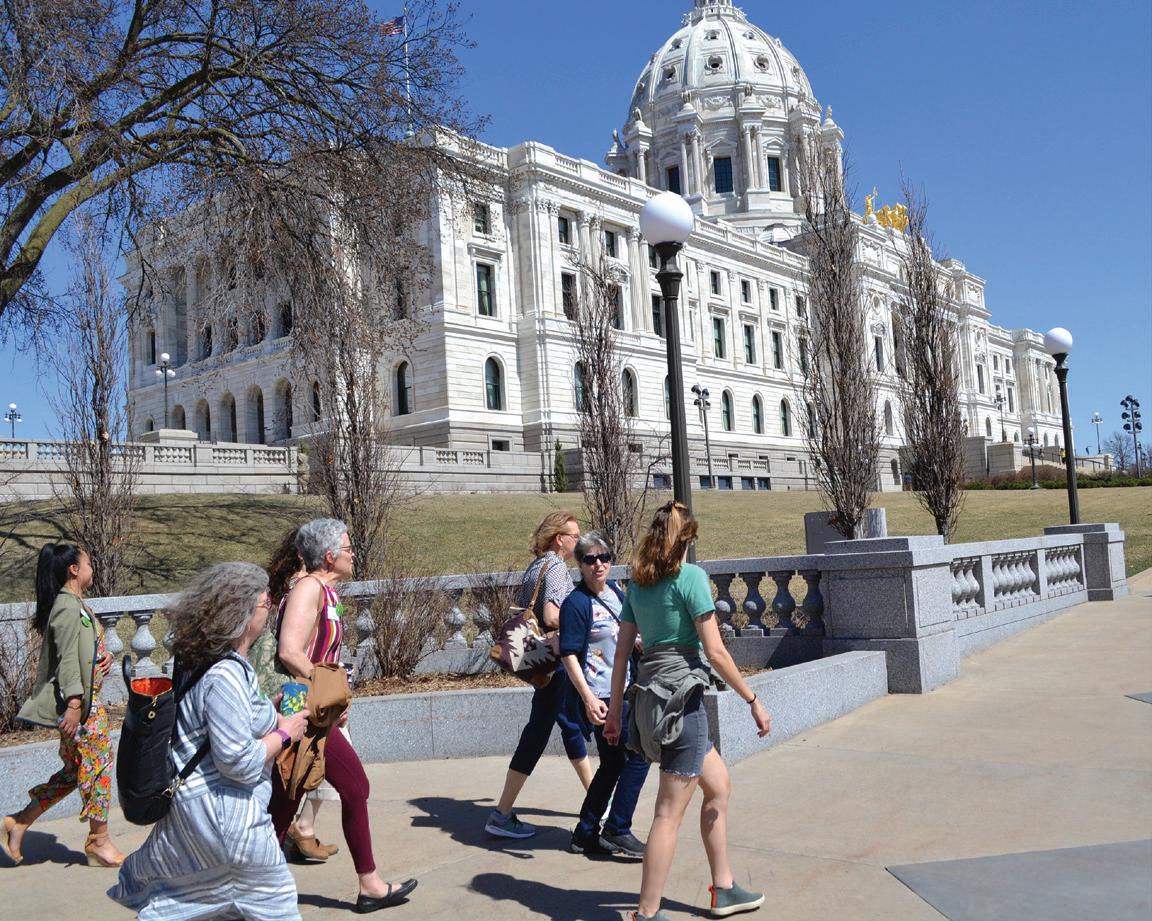
Thanks to Velasquez Family Coffee and Equal Exchange for providing coffee and tea, respectively. Thanks to Baker’s Field Flour & Bread for providing baked goods, and to Seward Community Co-op, Mississippi Market Co-op, and Twin Cities Co-op Partners for providing gift cards to assist with the costs of the Family Farm Breakfast.
The Advertisers
Thank you to those who supported the Family Farm Breakfast by purchasing an advertisement in the program: 100% Campaign ♦ A Couple of Gurus ♦ Albert Lea Seed House ♦ Baker’s Field Flour & Bread ♦ Ben & Jerry’s Catering-South Minneapolis ♦ Clancey’s Meat Market ♦ Co-op Credit Union ♦ CTUL ♦ Dangerous Man Brewing Co. ♦
Food Co-op
Seed Farm ♦

The Land Stewardship Letter No. 1, 2023 11
Ferndale
♦ Foresight Bank ♦ Honor the Earth ♦ Lakewinds Food Co-op ♦ Lorentz Meats & Deli ♦ May Day Café ♦ Minnesota Center for Environmental Advocacy ♦ Minnesota Nurses Association ♦ Minnesota Farmers Union ♦ Minnesota Interfaith Power & Light ♦ Minuteman Press-Uptown ♦ National Farmers ♦ Niman Ranch ♦ Parks & Trails Council of Minnesota ♦ People’s Food Co-op ♦ Prairie Moon Nursery ♦ Seven Corners Printing ♦ St. Peter Food Co-op ♦ The Book House in Dinky Town ♦ The Good Acre ♦ Velasquez Family
♦ Voices
Justice
Eastside
♦ Falk
Market
Coffee
for Racial
LSP Photo)
After the Family Farm Breakfast, LSP members and staff lobbied at the Capitol. (LSP Photo)
(
LSP Photo)
The official Family Farm Breakfast mug is available for purchase at LSP’s online store: landstewardshipproject. org/shop. (LSP Photo)
Federal Policy
A View from the Farm Bill Field
Farmers are Making their Voices Heard when it Comes to the Next Ag Law
Fly-ins, farm tours, and field days… oh my! With the 2018 Farm Bill expiration on the horizon — it sunsets Sept. 30— the Land Stewardship Project has been working hard organizing members, partnering with allies, and actively developing proposals we want included in its 2023 replacement. Namely, we are pushing for a 2023 Farm Bill that addresses problems with agricultural consolidation, conservation and climate change, and crop insurance, while supporting young, beginning, and BIPOC farmers, as well as regional food systems.
With the passage of the raising of the federal debt ceiling in early June, Farm Bill negotiations have ramped-up in earnest as Congress now has a budget to work with and the government has averted a shutdown. Although it is expected that Farm Bill negotiations will continue past the Sept. 30 deadline, now is the best time for LSP members to let lawmakers in Congress know what they want to see in our federal agriculture policies over the next five years. And members have risen to this challenge through fly-ins, Congressional meetings, and participation in a massive D.C. rally.
Rally for Resilience
For example, LSP members and staff traveled to D.C. in March to participate in
Give it a Listen
OnEar to the Ground podcast episode 304, organizer Sarah Goldman talks about LSP’s priorities for creating a more sustainable, and fair, 2023 Farm Bill: landstewardshipproject.org/ podcast/ear-to-the-ground-304-policyfor-the-people.

Episode 305 features LSP farmermembers describing how farm policy impacts their operations, and ways it could be modified to benefit the land, people, and rural communities: landstewardshipproject.org/podcast/ear-to-the-ground305-farm-bill-as-a-public-good.
the “Farmers for Climate Action: Rally for Resilience” — the largest farmer rally this Farm Bill cycle — to demand action on climate change in the 2023 Farm Bill. Six LSP farmer-members, two farmers from the Midwest Farmers of Color Collective, and the full LSP policy team spent a week in Washington calling for a more just Farm Bill. A few highlights from this trip include:
➔ Beginning farmer Claudia Lenz speaking on the main stage to 1,000 rally participants about the barriers that young farmers are facing (see page 13).
➔ A farmer-tofarmer community building event with the LSP delegation and farmers from the Illinois Stewardship Alliance.
➔ Chanting and marching down Pennsylvania Avenue to the U.S. Capitol to demand bold climate solutions in the Farm Bill.
➔ A full day packed with meetings at the Capitol, where we met with the staffs of U.S. Representatives and Senators.
On-farm Congressional Visit
In April, U.S. Rep. Angie Craig met with direct-to-consumer farmers at Seeds Farm in Northfield as part of her in-district listening session tour to identify issues and opportunities in the upcoming Farm Bill. A few points that the farmers, many of them LSP members, discussed during this session included crop insurance access and land access challenges, as well as the important role that direct-to-consumer producers play in local economies and feeding community members experiencing hunger. Craig is a member of the House Agriculture Committee.
Crop Insurance Access
LSP has launched a crop insurance working group consisting of Aaron Wills (Little Hill Berry Farm), Andy Petran (Twin Cities Berry Company), and Kathy Zeman (Simple Harvest Farm), along with Jeff Diamond, Scott Smith, and Nathan Hulinski (University of Minnesota Extension). This group has been investigating ways to improve the Whole Farm Revenue Protection crop insurance program through the Farm Bill.
Farm Bill, see page 13…
12 No. 1, 2023 The Land Stewardship Letter
Policy & Organizing
In mid-April, LSP staffers and southern Minnesota farmers who raise fruit, vegetables, and livestock gathered at Seeds Farm near Northfield, Minn., to share with Minnesota U. S. Rep. Angie Craig (in gray jacket) what they would like to see in the next Farm Bill. Craig is a member of the House Agriculture Committee. (LSP Photo)
Sarah Goldman
No legislation has as big an impact on our landscape, rural communities, and food system as the Farm Bill.
…Farm Bill, from page 12
D.C. Fly-ins
Land Stewardship Project members Bonnie Haugen and Carrie Redden traveled to D.C. in April to participate in a fly-in with the Campaign for Family Farms and the Environment, which LSP is a member of. During the trip, Haugen and Redden, who are both Minnesota dairy farmers, talked with Congressional staffers in the offices of Senators Tina Smith and Amy Klobuchar, as well as staffers with Representatives Angie Craig, Tom Emmer, and Ro Khanna, about the impact of consolidation and factory farms on our farmers and rural communities. They also specifically asked that the Farm Bill not use public dollars through the USDA Environmental Quality Incentives Program to further support concentrated animal feeding operations.
In June, LSP member Angela Smith traveled to D.C. as part of a National Sustainable Agriculture Coalition fly-in to talk with the Minnesota Congressional delegation about the importance of crop insurance access through the Whole Farm Revenue Protection program and Micro-Farm policy. Smith, who raises fruit, vegetables, and herbs in southeastern Minnesota, made it clear that there are many ways these initiatives can be improved to better serve diversified, small, and beginning farmers.
Land, Capital & Market Access
In late June, the USDA announced the first ever grantees for its new Land, Capital, and Market Access Program, with $300 million in federal funds targeted to directly
support land access projects for underserved producers. LSP is engaged in a federal effort to make this new USDA program permanent through the Farm Bill, and we are excited to see this effort moving via a bill that was recently introduced: H.R. 3955, the “Increasing Land Access, Security, and Opportunities Act.” LSP will continue to advocate for this proposal as the Farm Bill advances.
A Look Ahead
As September approaches, LSP will continue to create opportunities for farmers to speak directly with their Representatives and Senators who are actively engaged in the Farm Bill drafting process. This will be especially important in August, when Congress is on recess and lawmakers are back in their home states. Interested in engaging in this work? Reach out to me at sgoldman@landstewardshipproject.org or check out our federal policy web page at landstewardshipproject.org/federalpolicy. p
While they were in D.C., the LSP “Rally For Resilience” delegation and allies met with Minnesota Congressional staffers to talk about priorities for the upcoming Farm Bill. They met with the offices of U. S. Representatives Angie Craig, Brad Finstad, Tom Emmer, and Betty McCollum, as well as staffers for U. S. Senators Amy Klobuchar and Tina Smith. (Photo by Sean Carroll)

LSP Farm Bill Platform
Member-leaders of LSP’s Farm Bill Organizing Committee have developed a platform that outlines the organization’s priorities for the 2023 Farm Bill. The platform addresses: agricultural consolidation; conservation and climate change; crop insurance reform; supporting young, beginning, and BIPOC farmers; and regional food systems. The platform is at landstewardshipproject.org/ federal-policy/farmbill2023.
Young Farmers & the Climate
One of the Land Stewardship Project members who participated in the “Farmers for Climate Action: Rally for Resilience” event in March was Claudia Lenz (pictured). Her family has a Community Supported Agriculture (CSA) operation in Star Prairie in western Wisconsin. Lenz spoke at the rally. Here’s an excerpt of her comments:

“There seems to be this common thought that the reason we’re losing farmers at a rapid rate is that there is a severe lack of interest on the part of younger generations in farming. I’m here to tell you the interest from young generations is there. As a 21-year-old who watched our parents start our CSA farm from scratch 16 years ago, I am interested in farming. I see the interest growing every year from the high school and college students my parents have employed, to the young folks I meet gathering around agricultural issues. But we are not interested in managing thousands of acres of a single crop, growing our livestock operations as big as we can, or continuing to deplete the resources we depend on.
“We are interested in climate solutions that protect the integrity of our land and water. Solutions that strengthen our food systems in rural communities. Young people want to secure a future on this planet, and we understand that climate-focused farming is the only way.” (Photo by Amanda Koehler)
The Land Stewardship Letter No. 1, 2023 13
LSP organizer Sarah Goldman works on federal policy issues.
Community Food Systems
Beyond the Charisma
Creating Community Food Webs Requires Complex Conversations
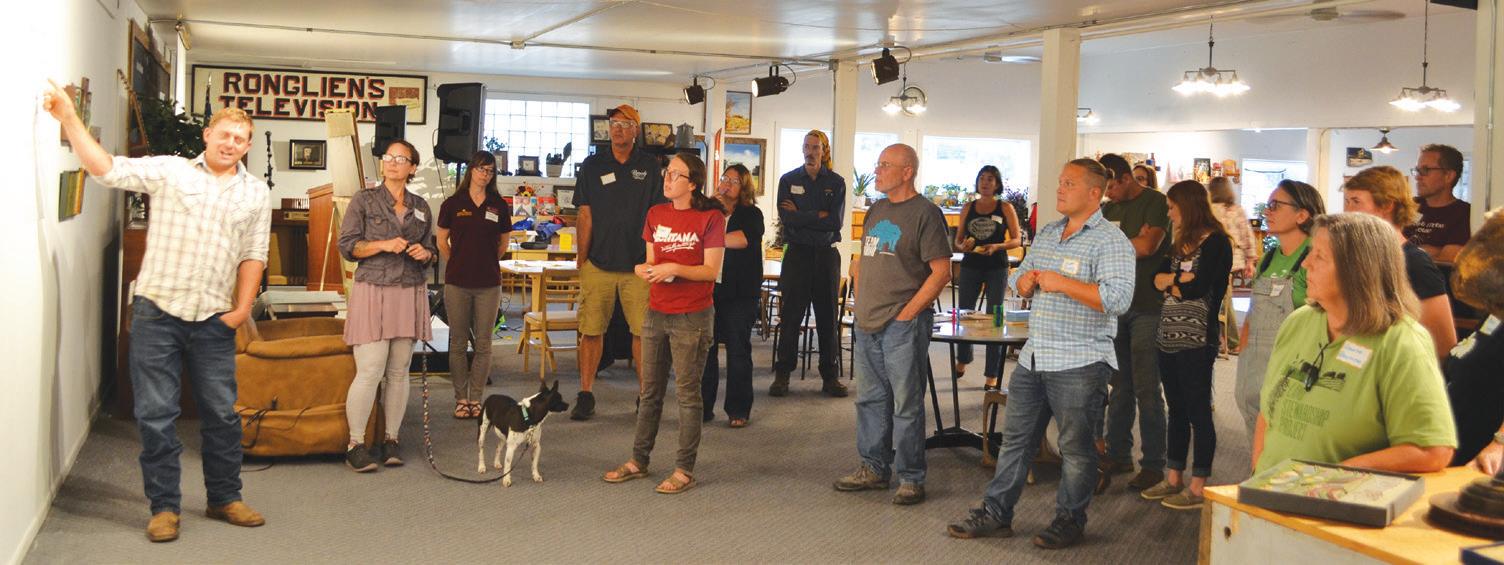
As anyone who’s spent any time on social media knows, there’s nothing like a rock star farmer to get people amped about consuming local, sustainably-produced food. But, argues one of the country’s leading food systems analysts, we need more than compelling stories if we are to build the kind of infrastructure that is resilient far into the future.
“We like to celebrate the charismatic chef, the charismatic farmer, but none of that will be resilient if we don’t build food systems that really engage all of us, whether we’re charismatic or not, whether we’re politically powerful or not,” said Ken Meter during a Land Stewardship Project webinar.
Building local and regional food webs requires celebrating group success and building community collaboration — something that’s more complicated than highlighting “individual heroes and heroines,” he said.
Meter should know. As president of the Crossroads Resource Center (crcworks.org), he has spent the past several decades telling complicated stories about how communities across the country are impacted by the current food and farming system. He’s an expert at diving into often arcane government statistics and drawing out trends that other analysts miss. Meter puts a human face on this data by combining it with interviews he conducts with farmers, small business owners, and local government officials.
The bad news is that his analyses show America’s agricultural machine, while extremely productive in a raw commodity sort of way, is extracting wealth out our rural communities at an alarming pace, something that U.S. Secretary of Agriculture Tom Vilsack only recently acknowledged. But a growing number of communities are using Meter’s data to figure out how to develop food and farming systems that build local wealth while benefiting the land, farmers, Main Street businesses, and human health.
Meter was speaking during the final session of a three-part online learning circle discussion series LSP sponsored in March. The learning circle was centered around Meter’s recent book, Building Community Food Webs, in which he describes the problem with our current extractive economy, and then uses examples from his various studies to lay out an alternative: community
food webs that go beyond a hierarchal chain, which inevitably creates winners and losers.
The conventional food chain keeps the producer and the consumer separate from each other, and that’s dangerous, because it means farmers have no market power, and it means consumers don’t actually know what’s going on in their own communities, or with their own food supply.
Rather than a linear, hierarchical structure, a food web is more of a circle, one that starts with farmers and ends with farmers. It takes into consideration what the food
they can be built upon. What farmers and local processors are already involved in providing food in the community? Is there a local grocery store or restaurant that has the infrastructure in place to service a community-based food system? Finding all that out requires lots of information sharing and communication — often across political and other lines of difference. That information can come via surveys, asset maps, and community meetings — all strategies LSP has been using recently in western Minnesota. But that exchange of information can also occur informally in diners, on the street, or at the local elevator.
As an increasing number of organizations, government entities, and even private companies get involved with the so-called “food movement,” it’s more important than ever that local communities take control of their own destiny.
“In a community food web, we write our own menu. We’re not doing things because
and farm system requires to be resilient in the long-term: healthy soil and a system that gives everyone, from farmers to food system workers, a viable way to make a living. Meter said often when people think of community-based food systems, they get hung up on geography and the idea that food must be sourced from within a certain number of arbitrary miles. But food webs are more based on relationships than road miles. A Midwestern coffee shop can source its beans from farmers in Central America in a way that wealth stays in both communities.
When one starts talking about infrastructure, the discussion gets complicated fast, and frankly, it’s not as easy as “liking” a food celebrity’s latest Instagram post.
What are needed are deeper, often hard, discussions about what a community lacks when it comes to developing a more resilient food and farm system. But Meter said people also need to acknowledge what assets are already in place to an extent that
General Mills or Target told us to do or buy that,” Meter said. “We’re doing it because we decided for our own selves, our own communities, that’s what our priority is.” p
LSP & Community-Based Food Systems Work
For more information on the Land Stewardship Project’s work on community-based foods, see landstewardshipproject.org/community-food or contact Amy Bacigalupo, amyb@landstewardshipproject.org, 320-269-2105; or Scott DeMuth, sdemuth@landstewardshipproject.org, 612-767-9487
On Ear to the Ground podcast episode 283, Ken Meter talks about how community food webs can help counter the extractive economy: landstewardshipproject.org/podcast/ear-to-the-ground283-ending-the-extractive-economy.
14 No. 1, 2023 The Land Stewardship Letter
To build food webs, farmers, farmworkers, business owners, consumers, and local government officials first need to engage in deep discussions about what the community lacks, as well as what its assets are, says Ken Meter. (LSP Photo)
Why Food Webs Matter
Dave Bishop Sees the Current System as an Abuse of Land, Farmers, Communities
Central Illinois farmer Dave Bishop likes to say, “Diversity is the antidote to adversity.” Bishop’s PrairiErth Farm (prairierthfarm.com) is certainly putting that philosophy into practice. Along with corn and soybeans, the 450-acre certified organic operation produces vegetables, beef cattle, pork, flowers, and small grains such as wheat. The products from this operation are direct marketed and Bishop is a master at identifying profitably in hidden corners of the farm, like when he realized huitlacoche, otherwise known as corn smut, could make a diseased looking corncob worth $5 in the specialty food market.
The farmer also feels strongly that diversity in marketing and sales options is key to success. PrairiErth learned that the hard way when the COVID-19 pandemic hit and restaurants shut down. Within seven days, vegetables sold to restaurants went from 30% of the farm’s market to zero. Bishop, who teaches a course on regenerative farming at a local college, knows from personal experience that directmarketing farmers can’t do everything and that they need to develop food webs (see page 14) with other businesses in the community to provide the kind of processing, marketing, and transportation infrastructure that allows them to be profitably diverse.
In a recent Land Stewardship Project Ear to the Ground podcast, Bishop talked about why it’s so important for farmers and rural communities to diversify their source of income through local food systems. Here are excerpts of that conversation:
Wealth Extraction & Rural Communities
“In 2011, Ken Meter (see page 14) studied 32 counties in Illinois and found that we were bleeding about $5.8 billion a year. And I asked him in 2018 if he’d do an update of that analysis for me, which he did. And his updated research found it was up to $8.8 billion lost per year. It was like, ‘Oh my gosh, from 2011 to 2018, things have gone downhill that much.’ Does that match what you see when you drive through rural America? Sure does.
“There’s no question we need to pay attention to all this economic wealth leaving our rural communities. That’s about as high a priority as actually growing vegetables that have nutrients in them. We can’t afford to produce this really high-quality food and then let someone else suck all the profit out of it. That doesn’t make any sense. So, what we need to focus on economically here is
not only producing a high-quality product that people are willing to pay for, but asking, ‘How am I going to keep the wealth I generate from this land in the community?’ And that requires me to do value-adding and marketing in my own community, rather than just growing raw materials and letting someone else have 85% of the profit.”
A Monocultural Desert
“There’s no logical reason for allowing the Midwest to be dominated by crops like corn and soybeans to the detriment of the soil’s health. That’s just abuse of the land. I don’t know how else to say it. If you have this incredibly fertile, eight-foot-deep black topsoil, and you manage to turn it into something that’s basically holding up a plant, how are you going to blame Mother Nature for that? It just kind of makes you sick to your stomach when you see something like that.”
What is Local?
“One of the criticisms leveled against local food systems is, ‘Well, you know, local food systems are great, but they can’t supply everything. What about coffee and bananas? So your local food systems can’t really supply everything.’
a third-party setting the price and extracting value from the transaction. We can supply every product known to man through a local food system.”
Relationships & Transparency
“Now, once I start buying local, I start to wonder, ‘Am I really getting what I think I’m getting?’ A classic example being the jug of milk with the beautiful, bucolic picture of the cows in the pasture, and then you find out those cows haven’t seen anything green their whole life. Well, are you doing what I think you’re doing, really?
“Well, come on out to my farm — I promise I won’t sue you for taking a picture. Come on out and look for yourself. And while you’re here, bring the kids out, have an enjoyable day, wander around the farm, make this a destination. Now you have a connection with that person who produces your food in many different ways. And once you start that, once you begin to appreciate all of that, and you’re getting good food too, that changes everything.”
It’s Not Inevitable
“An exchange trip to Europe was an eye-opening experience for me. One of the things I saw was a 160-cow dairy in Germany right in the center of a town of 3,000 people. And the first thing that comes to mind is, ‘Gee, if I went home and I proposed to a city in central Illinois that I should do that, they’d have me locked up.’
“But it’s not a big deal over there because that’s what local food systems mean to them. And yet, we see things through our own lens so narrowly sometimes that it’s really hard to get that lens out of the way.
“The way I answer that is to use the illustration in Bloomington, Illinois, where we have a coffee house called the ‘Coffee Hound.’ And when they wanted to serve local coffee, they went to Central America, I think Nicaragua, and formed a relationship with a coffee cooperative. They made arrangements to have raw beans shipped back to Bloomington, and they roasted the beans themselves.
“So, is that a big deal? Well, yes, the reason it’s a big deal is that by doing it this way rather than through a coffee broker, there is no third-party that sets the price and extracts value from the transaction. All of that value remains local, somewhere — maybe half in Central America and half in central Illinois — but nowhere is value being sucked out of the community. If you drive around rural America, you’re looking at four decades of
“And it helps local people understand that just because you’ve got 160 cows in the middle of town doesn’t mean it stinks to high heaven. And they also had some hogs in the middle of town, out on pasture — they don’t stink. But in this country, we associate hogs with places that smell so bad you can’t get within two miles of them. Well, that’s a design choice. You can design a hog barn to stink to high heaven, and you can design one not to. Your choice — it’s not inevitable.” p
Give it a Listen
On Ear to the Ground podcast episode 300, Dave Bishop talks about how rural communities can’t “monoculture” their way out of the economic, ecological, and social challenges that plague them: landstewardshipproject. org/podcast/ear-to-the-ground-300-diversity-trumps-adversity.
The Land Stewardship Letter No. 1, 2023 15
“We can’t afford to produce this really high-quality food and then let someone else suck all the profit out of it.”
— Dave Bishop
Soil Health
Pay Dirt
Viewing Profitability Through a Soil Health Lens
By Brian DeVore
Last fall, a team of pretty smart people — environmental scientists, supercomputing specialists, hyperspectral remote sensing experts (you get the picture) — released a paper titled, “Recent cover crop adoption is associated with small maize and soybean yield losses.” The results, which were based on sophisticated satellite data gathered on 90,000 fields in six states, showed that cover crops caused corn and soybean yields to drop by an average of 5.5% and 3.5%, respectively. These yield drops were recorded on acres that had been cover cropped for three years or more. The researchers’ hypothesis was that cover crops were competing with cash crops for fertility, water, possibly even the oxygen present in the soil. Based on crop prices at the time of the research, that calculated out to a loss of $40 per acre for corn, and $20 per acre for soybeans.
Those last two figures should catch the attention of any farmer considering diving into cover crops. The researchers concluded that there are a lot of good reasons for planting cover crops — erosion control, organic matter development, water management, weed suppression — but profitability isn’t one of them.
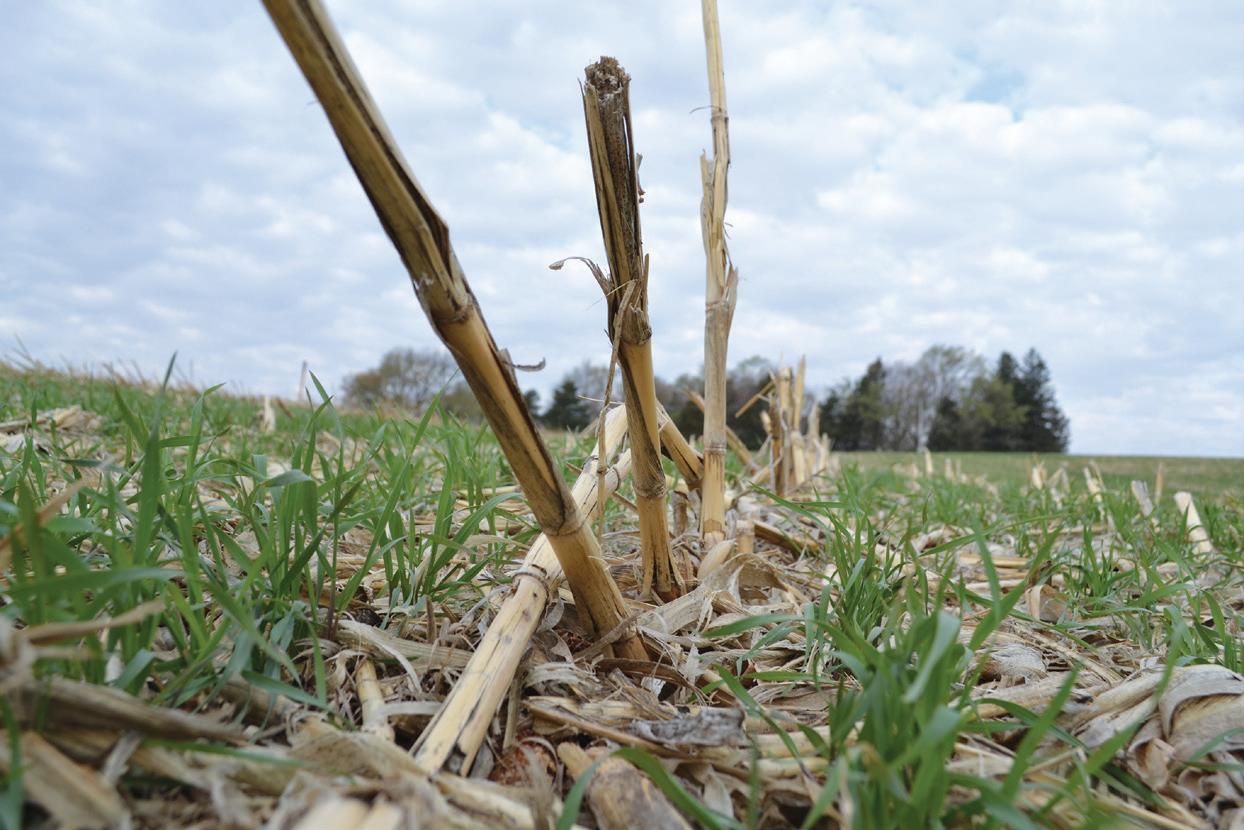
The scientific credentials behind this study are rock solid: the scientists represent top research universities and the study was sponsored by NASA. Unfortunately, their conclusions assume higher yields always equal higher profitability. It may look that way when viewed from a satellite thousands of miles up, but the reality on the ground can be quite different. When farmers begin putting in place soil health practices such as cover cropping, traditional ideas around profitability are turned on their head.
The NASA study views profitability through the traditional, reductionist lens of conventional ag: more corn in the bin auto-
matically equals more money in the bank. That makes sense in a world where A = B. But when the diverse world of the soil biota enters the picture, A = Z, and the impact all the letters in-between have on the end result must be taken into consideration. With that in mind, on the next few pages are a few
that’s working in the business,” says Pratt. But working on the business is figuring out not just how to manage a cattle or cropping operation, for example, but asking hard questions. Should I be raising cattle or corn in the first place? What impact is my production system having on the long-term sustainability of the soil, as well as the people working the land?
“We’re so busy working in the operation that we don’t take time to work on it. As a result, we don’t really own businesses,” says Pratt bluntly. “Most farms and ranches are not businesses, they’re just a giant collection of very expensive assets and a whole bunch of low-paying, physically demanding jobs.”
Stability = Profitability
Rick Clark is big on spreadsheets, and he has one labeled “Stability” — a title that doesn’t exactly light one’s imagination on fire. But upon closer examination, the data represented in that chart provides a convincing argument for utilizing cover crops. What it shows is that before he adopted cover crops on his 7,000-acre crop and livestock operation in west-central Indiana, the variance in corn yields from year-to-year, otherwise known as the standard deviation, was 28 bushels per acre. Today, his annual corn yields vary on average less than five bushels per acre. For soybeans, his standard deviation has gone from over eight bushels per acre to less than three.
insights generated by people who are looking at farms, and the soil that supports them, from a new economic angle.
Working On the Farm
First, a little reality check, courtesy of Dave Pratt. The financial and grazing expert is not afraid to deflate a few myths when it comes to the economics of farming and ranching. Spend any length of time with the Ranching for Profit instructor, and you are likely to walk away questioning your own beliefs about what makes a business a real business, if hard work always pays off, whether you own the farm or whether it owns you, and, when it comes to estate planning, the difference between equal and fair. And during a recent Land Stewardship Project soil health presentation in Red Wing, Minn., Pratt talked extensively about the difference between working in your business and on it. When it comes to a farm or ranch, people spend a lot of time doing field work, fixing fence, etc. “We’re fabulous at that —
That consistency is money in the bank, says Clark, who raises corn, soybeans, wheat, alfalfa, peas, milo, cattle, sheep, and, of course, cover crops. Around 5,600 acres of his operation is organic.
Clark plants his cash crops straight into standing cover crops and then uses a roller crimper to lay down and terminate those covers, a technique called “planting green.” He also relies on diverse rotations as well as integrating livestock into his operation. Through it all, his number one rule is to treat cover crops as the equal to his cash crops. One of the farmer’s goals is to, as much as possible, take advantage of what he calls the “free stuff” available in nature, such as solar energy and natural fertility.
He may not be pulling in record-breaking yields year-after-year, but Clark is getting the kind of consistency that resembles a gentle sine wave when plotted on a graph. And because he’s building the kind of soil health that is much less reliant on purchased
16 No. 1, 2023 The Land Stewardship Letter
Pay Dirt, see page 17…
When building soil health via practices such as cover cropping, traditional views of profitability need to be reconsidered.
(LSP Photo)
inputs for fertility and weed control, his profitability is also consistent.
“I will sacrifice yield to maintain soil health; I do it every day,” says the farmer. “Don’t get me wrong — we have to have yields to pay our bills, to calculate our return on investment. But I’m not driving our system for higher yields; I’m driving our system for higher profitability, and that doesn’t always mean high yields.”
Monitor the Microbes
On a snowy day in southeastern Minnesota, microbiologist Elaine Ingham is showing a group of farmers how to check their soil’s balance sheet. Gathered around microscopes set up in a biology lab at Saint Mary’s University in Winona, the LSP workshop participants smear samples of compost onto glass slides.
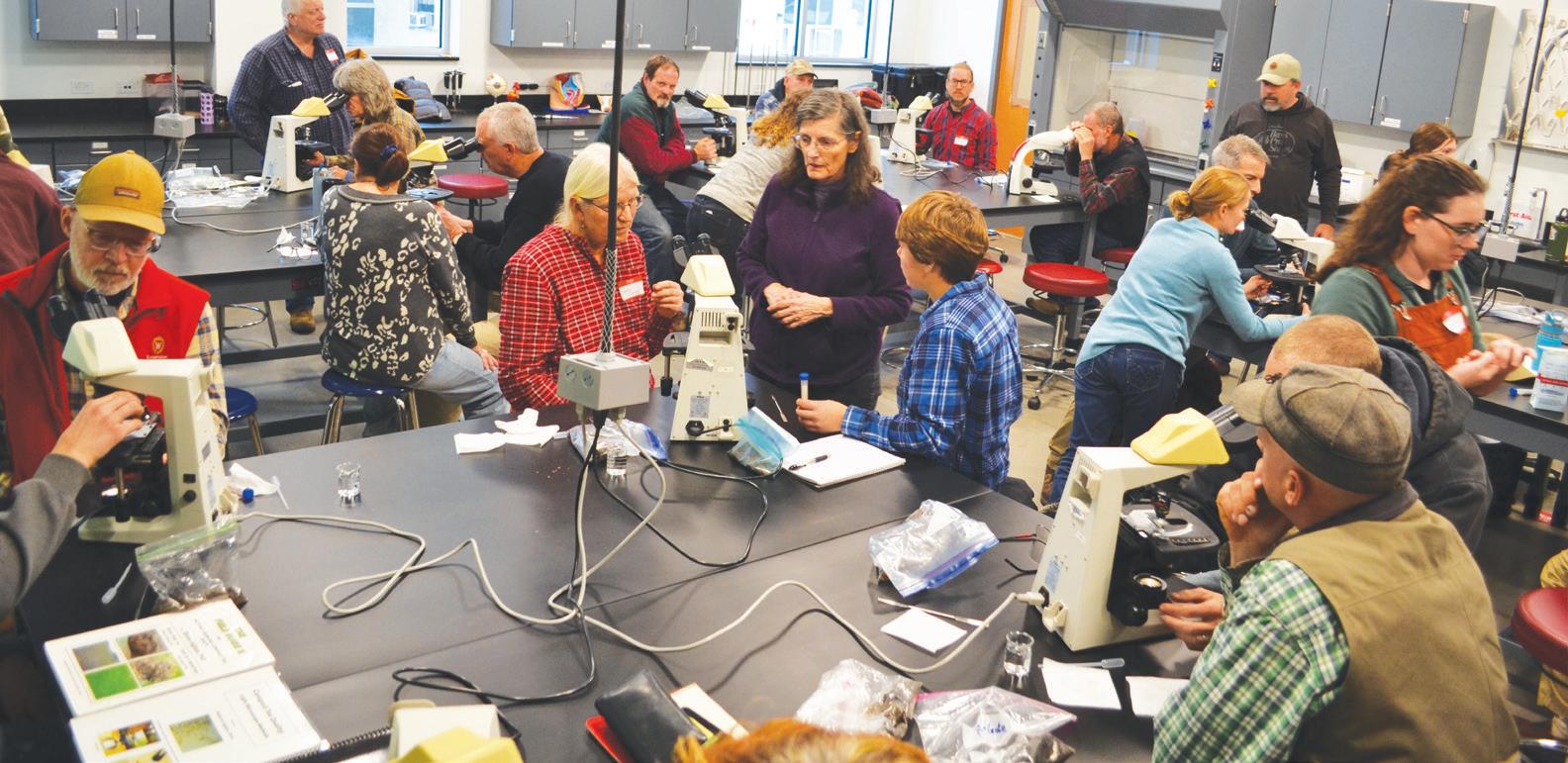
Ingham goes from microscope-tomicroscope, helping workshop participants identify fungi and amoebas. One of the magnified images shows a rotifer, which is in a kingdom of its own. It has “rotors” at one end that are used to suck bacteria it wants and spit out bacteria it doesn’t need.
“It’s like bing, bing,” says Ingham as she flutters her fingers in the air like they were Cuisinart blades. “It’s like a video game.”
The microscope workshop offers a fun, graphic grounding to the message the scientist shared during a presentation earlier in the day: soil has all the potential in the world to cook up the homegrown fertility we need for productive and healthy crop fields, vegetable plots, orchards, and pastures.
“But you have to put that biology back in the soil — the biology just doesn’t show up
one day,” the scientist warns. Ingham emphasizes the benefits of utilizing composting and diversity to build the biome and tap into all those willing workers beneath the ground. But such an approach requires farmers to become keen observers in order to build healthy soil, something that’s not as easy as it sounds. Without that close attention to how the soil functions, farmers aren’t really the masters of their own fate; they are basically relying on input suppliers to determine what’s the best way to produce food — a case of ceding the future to outside forces.
“Whereas when we start implementing the biological approach, you as a grower have to pay attention to a lot of things,” she says. “It’s a very different approach. In a biologically-based system, farmers are really going to be the people doing the thinking.”
A Thumb on the Scales
Give and take. Three steps forward, two steps back. Farming with soil health in mind is all about stacking the odds in favor of more biology. But, says southern Minnesota crop and livestock farmer Tom Cotter, such an approach comes with plenty of compromises, lots of fits and starts.
“Pluses and negatives — for everything I do, it’s a plus one, or a negative one,” he says during a presentation at a recent LSP soil health workshop. But Cotter, who farms 795 acres in southern Minnesota, concedes just knowing what negatively impacts soil health is not enough — there are times when tillage seems necessary or chemicals are called for in the short term. That’s where “plus” columns and “negative” columns
Pay Dirt, see page 18…
95%...
Soil Health by the Numbers
That’s the amount of erosion reduction we would see in the Midwest if 100% of its crop acres was converted to no-till farming systems, according to a recent study by University of Massachusetts-Amherst researchers. The scientists have found that more than one-third of the Corn Belt in the Midwest has lost all of its carbon-rich topsoil during the past centuryand-a-half. Most of that soil loss is due to tillage, and it’s nearly double the rate at which the USDA considers sustainable.
Roughly 40% of the Midwestern crop acres the scientists studied are currently no-tilled. But modeling showed that if that amount of conservation cropping was upped to 100%, the soil savings would be so significant that it would take 10,000 years to see the same level of erosion and carbon loss that would occur in only a century if we continue business as usual. The study, “The Future of Soils in the Midwestern United States,” is available in the May 25, 2023, issue of the journal Earth’s Future: agupubs.onlinelibrary.wiley.com.
67%...
That’s the amount, on average, of nitrogen-based fertility corn gets from sources naturally occurring in soil, according to University of Illinois research. This has major implications for the environmental and economic problems that occur when farmers over apply nitrogen in an attempt to make up for lost fertility, and the role building soil health can play in building natural fertility. “If the soil is the main source of nitrogen for crop uptake, which it almost always will be, we need to take the soil into account,” says study co-author Richard Mulvaney. “Otherwise, with factors like timing, rate, placement, and form, we’re tweaking, but probably won’t find a miraculous increase in efficiency using those approaches.”
The University of Illinois research is at phys.org/news/2023-05-nitrogen-corn-fertilizer-farmers.html.
The Land Stewardship Letter No. 1, 2023 17 …Pay Dirt, from page 16
Microbiologist Elaine Ingham (center) leads a microscope workshop during an LSP soil health event. “When we start implementing the biological approach, you as a grower have to pay attention to a lot of things,” she says. (LSP Photo)
…Pay Dirt, from page 17
come in handy — they serve as a biological balance sheet that allows him to grapple with the inevitable compromises that come with building soil health on a farm.
“I’m not perfect, and if I do something bad I have to counteract that,” says Cotter, flashing a PowerPoint slide with two columns — one side lists his pluses for a given growing season; the other his negatives. He goes down the list and explains that dropping fall tillage and planting a cover crop puts him two points ahead. But the fact that he used herbicides the following spring to kill the covers is a negative. Cotter has organic acres and is working on terminating cover crops with a roller crimper, which doesn’t require chemical use. So that could be a check mark in the “plus” column.
“At the end of the year, I can be a plus three,” says the farmer. “That’s pretty good, but I have room to get better.”
Going Beyond Widgets
Martin Larsen admits that when his farm consisted of just two crops — corn and soybeans — he treated it like a “widget factory.” “You put this in and you put that in and pray for Mother Nature to cooperate, and in the end you get some yield, sell it, and that’s your widgets, right? You’re almost ignoring the fact that it’s a biological system,” he says.
Give it a Listen
On LSP’s Ear to the Ground podcast, hear the folks quoted in this article discuss some of the economic rules related to building soil health profitably. The episodes are at landstewardshipproject.org/ear-dirt.
4 Episode 308: Is Your Farm a Business? (Dave Pratt)
4 Episode 301: Pipe Dreams (Tom Finnegan)
4 Episode 297: Web of Willing Workers (Elaine Ingham)
4 Episode 296: Stability is Sexy (Rick Clark)
4 Episode 288: More with Less (Tom Cotter)
4 Episode 260: Soil Health’s Long View (Martin Larsen)
Since he added oats to his corn-soybean rotation on the 700 acres he farms in southeastern Minnesota, the benefits of that biological system have come to the fore. That addition of a small grain, with its extensive root system and ability to suppress weeds, build organic matter, and in general improve soil health, has a significant positive spillover effect on the other crops.
During a recent LSP soil health workshop, Larsen projects onto the wall what he calls the “mother of all spreadsheets.” At first, he simply shows the costs, yields, and profit from a two crop-rotation. Then he tweaks the spreadsheet to illustrate what happens when he adds a third crop like oats. For one, there’s a 5% yield boost for subsequent corn and soybean crops. That’s great, given that it gives him more of those row crops to sell at the elevator. In addition, since Larsen sells his oats into the foodgrade market, growing them provides a third crop — a third widget, so to speak — to sell off the farm.
But it’s not all about yield and commodity sales. Larsen points specifically at the columns showing how introducing oats into his rotation significantly cut his dependence on herbicides in subsequent corn and soybean crops. He is also able to slash fertilizer costs because the clover he interseeded with the oats is a legume, which adds nitrogen to the soil. Money not spent is money earned, thanks to the fact that the lines separating the crop categories on that spreadsheet are more permeable than they appear.
“There’s more interaction between the years,” Larsen says. “Everything we do in a given year affects a year down the road.”
Pipe Dream
It’s hard to overstate the role tile drainage has played in producing row crops. According to the latest Census of Agriculture, around 56 million acres of U.S. farmland is tiled, which represents 14% of all the country’s cropland. That figure goes up every year and over half of Iowa’s farmland is now artificially drained. In Minnesota, over a third is.
With its ability to pull excess moisture off farm fields in a short amount of time, this rural version of a storm sewer system has made countless low-lying acres tillable, and thus profitable. But a few years ago, Tom Finnegan realized here was a limit to what all that underground engineering can accomplish. Finnegan farms some 500 acres with his wife, Kim, in the Cedar River watershed near Austin in southern Minnesota. Managing water is a major problem on the corn and soybean ground they manage. As a result, they haven’t been shy about investing in the installation of drainage systems.
“Over five years we tiled the whole farm out at a six-figure expense, and then we were still struggling with ponding in a couple of different spots,” he recalls.
The tiling company, naturally, recommended even more intense artificial drainage, to the tune of tens of thousands of dollars more. “Well, that wasn’t really feasible,” says Finnegan.
But through their own experience and by observing other farmers in the region, the Finnegans began to notice the positive impact cover cropping could have on building the kind of soil aggregate structure that allows fields to soak up and store moisture. By planting cocktail mixes that contain as many as 12 species, the Finnegans are now utilizing the ground cover and rooting systems these plants provide to build resiliency. The result is not only less swamped land and lower erosion rates, but fewer weeds.
On top of that, the Finnegans have been able to make their cover crops a source of revenue by grazing their direct-marketed beef herd on them. That rotational grazing is feeding the soil by spreading manure and urine evenly across the fields, “fast tracking” soil health and increasing aggregate structure even more, says Finnegan. Even the tops of hills that had been damaged by erosion when the farm was rented out are now building organic matter.
“We’ve seen a huge improvement and with not having to spend all the money on extra tile,” says the farmer, adding that building soil health isn’t just good for the land. “It’s kind of addicting because you’re seeing change, you’re seeing the land respond. Any small amount of change just has a huge effect — it’s remarkable how everything is interconnected.” p
workshops, field days, and on-farm demonstrations, as well as the latest soil health and cover crop research.
For more information on joining, see landstewardshipproject.org/soil-health or contact LSP’s Alex
18 No. 1, 2023 The Land Stewardship Letter
Soil Health
Join LSP’s Soil Builders’ Network
Interested in profitable ways to build soil health? Join hundreds of other like-minded farmers, natural resource professionals, and others in the Upper Midwest and become a member of the Land Stewardship Project’s Soil Builders’ Network. Members get regular updates
on
Maura Curry (mcurry@ landstewardshipproject.org, 612-7679882).
Romano (aromano@ landstewardshipproject.org, 612-7679880) or LSP’s
Climate Resilience It’s Not You, It’s the Climate
The Human Element of Building Resilience on the Farm
By Brian DeVore
There’s little doubt Rodrigo Cala has the skills to grow good vegetables on his certified organic operation near Turtle Lake in western Wisconsin. “I have 20 years of experience growing brassicas, so I know what I’m doing,” he says confidently.
He especially likes growing broccoli — there’s a good market for it and it’s satisfying to take in a bumper harvest. But a few years ago, he noticed weather problems caused the crop to repeatedly succumb to disease pressure. Cala tried adjusting the way he managed the soil and even the way irrigation was done, but the broccoli was still not producing at the level he was used to, and he lost money on it three years in a row, at one point tossing 70% of the crop. Today, broccoli is no longer grown on Cala’s farm.
“Numbers don’t lie, even if we think we are the greatest grower,” says the farmer with a hint of resignation in his voice.
He’s not alone — extreme weather brought on by climate change is making it difficult for farmers across the country to conduct business as usual. There’s nothing like a thousand-year storm in September, a devastating drought in August, or a killing frost in June to expose the vulnerabilities of a farming operation. And it’s not just the direct impact of extreme weather that plays havoc — excess moisture or droughty conditions can have interrelated side effects, such as creating a more hospitable environment for insect and weed pests, as well as diseases. Unfortunately, as climate change makes itself more evident, farmers of all types are grappling with weather-related calamities that test the very survival of their operations.
three-to-four times as many nights above 70 degrees. There may be more precipitation in the state by that time, but not during the summer.
“The thing that concerns me the most is we will be getting more moisture in the spring and struggling with maintaining that moisture in the soil throughout the summer, which can really stress plants,” says Greg Klinger, a University of Minnesota Extension educator who works on water quality and nutrient management issues.
extremely hot, dry summers.
“Farming will only get harder,” says Natalie Hoidal, who works on vegetable crops and local foods for U of M Extension.
Extreme weather can be particularly hard on farmers who raise specialty crops such as fruits and vegetables. Timing can be everything with such crops, and an adverse weather event can cause a farmer to miss a key marketing window. In addition, government subsidized crop insurance programs are geared mostly to benefit farmers who raise major commodity crops such as corn, soybeans, and wheat.
Rodrigo Cala’s failure to raise a profitable broccoli crop is a prime example of why today’s farmers need to develop a climate resilience plan, says regenerative agriculture expert Laura Lengnick. All too often farmers see themselves as the weak link when a weather disaster strikes. That involves a lot of self-blame. Maybe if I just worked even harder, I can muscle through this immediate situation, goes the thinking. But the author of Resilient Agriculture: Cultivating Food Systems for a Changing Climate says such a narrow approach does not build the kind of long-term agronomic, economic, and ecological sustainability successful farming operations need. Worse, it ignores the fact that the mental and physical wellbeing of the humans raising that food is just as important as the health of the soil it’s being raised in.
Vegetable farmers are becoming increasingly dependent on protective shelters and irrigation systems to deal with weather extremes. (LSP Photo)
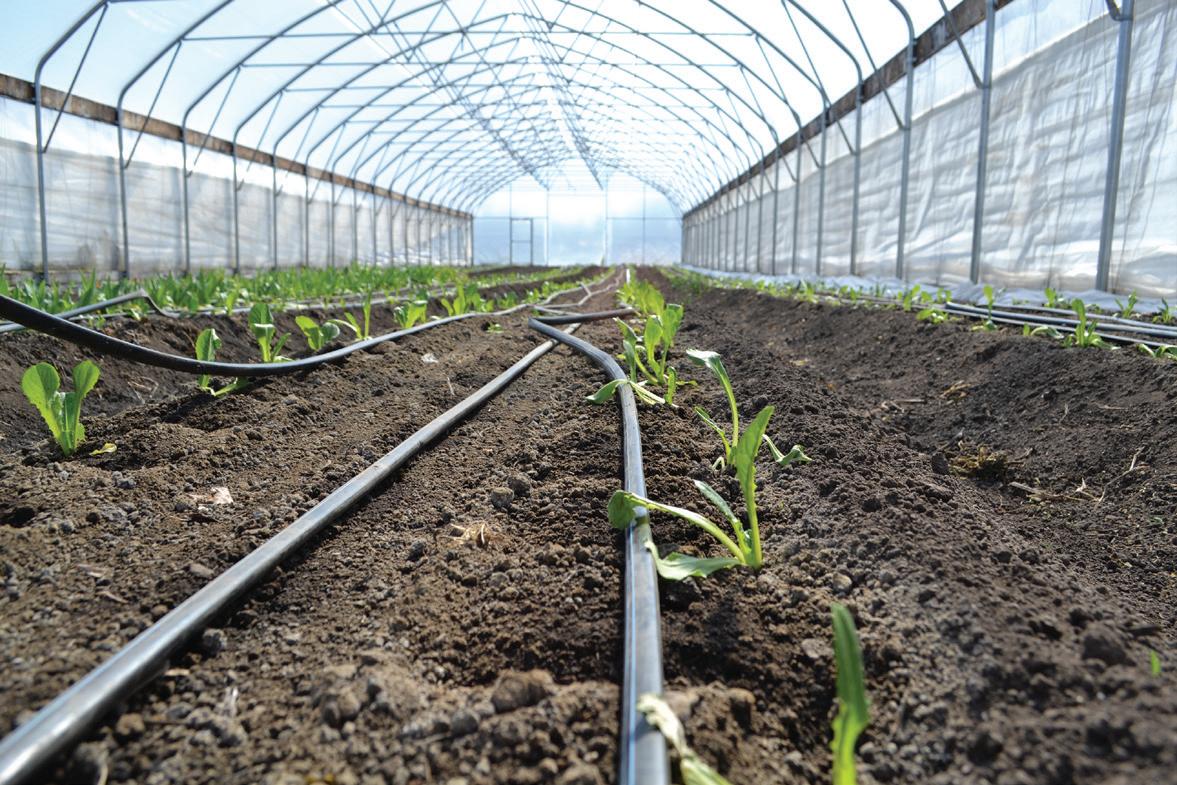
If greenhouse gases continue their rapid rise, at least 30% of corn and wheat acres will face “adverse changes” in growing conditions by 2040, according to a study by the American Farmland Trust. This spring, University of Oklahoma researchers estimated that the risk of “flash droughts” — brief periods where high temperatures and lack of rain combine to suck moisture out of the soil rapidly — will increase in every major agricultural region in the world. In North America, cropland that had a 32% annual chance of a flash drought a few years ago could have as much as a 53% chance by the final decades of this century.
Lengnick is the director of agriculture at the Glynwood Center for Regional Food and Farming, as well as the owner of a company called Cultivating Resilience. She’s worked with farmers across the country to help them develop climate resilience plans.
During the past few years, the Land Stewardship Project has partnered with U of M Extension to help specialty crop producers develop more resilient operations in the face of climate instability. LSP and Extension are using as their guide Lengnick’s book and other resources she and others have developed.
And climate change’s negative impacts on farming only promise to worsen. By the middle of this century, Minnesota will be having twice as many 90-degree days and
For much of Minnesota and other spots in the Midwest, the 2022 growing season, as well as the beginning of the 2023 season, could be harbingers of what’s to come:
Farmers need to take a holistic approach which gives as much emphasis to a farmer’s wellbeing as it does to the ecological health of the farm and the operation’s productivity and profitability, says Lengnick, whose background is in vegetable production. And the farmers’ values and the role their operations play in the health of the community must also be taken into account. Lengnick
Climate, see page 20…
The Land Stewardship Letter No. 1, 2023 19
Climate Resilience
…Climate, from page 19
recommends taking an approach that allows farmers to assess their strengths, weaknesses, opportunities, and threats (something she calls SWOT for short), and to develop a plan that not only allows their farm, but themselves, to be more resilient.
Soil health provides a perfect foundation for putting a SWOT strategy into place. Soil can represent a weakness when it’s being eroded by too much precipitation, which represents a threat. Strengths may be rooted in a type of soil that is naturally fertile, and opportunities can be in the form of planting cover crops to protect it.
Lengnick has a couple of caveats when it comes to resilience planning. For one, be patient. With conventional agriculture, we tend to go for a short-term fix when confronted with a problem, which may address the symptoms, but doesn’t get at the root cause.
“One thing whole farm planning does is really help farmers find those longer-term solutions that are getting closer to the root causes of why the farm isn’t performing as well as it used to,” she says. Having a crop wiped out by a pest infestation may be better resolved with a long-term rotation change, rather than a quick fix like spraying.
Farmers also need to have the ability to let go and cut their losses. As Rodrigo Cala discovered, changing management may not be enough.
“We have to learn how to deal with loss. We may have to give up some of those things we love to do in order to maintain quality of life and balance,” says Lengnick, adding that such a decision can be difficult. “We tend to grow things that we have a feeling for, or some kind of relationship with. It’s not that farmers have to get out of farming, but they may shift the species that they’re caring for. It’s less about being a good or bad farmer, and more about adjusting to the situation.”
In Cala’s case, after he dropped broccoli he focused more on other vegetables and diversified into chickens. He’s one of the farmers taking part in LSP’s most recent climate resilience cohort, which gets together periodically to share ideas and resources.
Wrangling Resiliency
On a bitterly cold day in January, LSP held a climate resilience retreat at a YMCA camp overlooking the Saint Croix River in western Wisconsin. It brought together an
existing cohort of farmers who had spent the previous year developing climate resilience plans, and a new cohort that was just starting on that journey. Around three dozen farmers from Minnesota and Wisconsin, representing everything from wholesale and Community Supported Agriculture vegetable production to fruit and specialty crop enterprises, were present. They shared how climate change is already impacting them: flash droughts and extended droughts at times of the year they normally don’t occur, flooding, extreme winds, pollution caused by wildfires, unsafe conditions for workers, a late spring killing frost or an early autumn freeze-up. The impacts can literally be measured by a few degrees — one vegetable farmer pointed out that a slight change in temperature overnight can reduce the window available for treating potato beetles from 12 hours to six.
Farmers who have been working on resiliency plans shared some of what they’ve adopted in the past year or so: adding livestock to a vegetable operation to increase the value of soil-building cover crops, improving irrigation systems (“For us, it was truly life-changing,” says one farmer of the new irrigation management plan they have put in place.), digging new wells, adjusting field work times to avoid the heat of the day, installing solar panels to provide an electricity back-up during storm-caused blackouts, installation of moisture sensors, use of hoop houses and row covers, and, regrettably, dropping crops or enterprises completely. The farmers also talked about ways they are trying to develop “self-resiliency” as they struggle with the stress of climate change by doing such things as practicing regular physical therapy and getting together with other farmers to compare notes and network.
Lengnick, who was present at the workshop, says that self-resiliency is particularly important, but often overlooked.
“It concerns me the amount of discussion going on these days around regenerative agriculture, and how much of it is just focusing on the health of the environment,” she says. “Because people farm, it’s people that are managing the landscape.”
One adaptation strategy the farmers discussed was taking advantage of the “shoulder seasons” that have been made longer by climate change. For example, warmer summers can morph into longer autumn periods when there’s no killing frost. That means vegetable farmers, for example, can sometimes access late-season markets with another succession of plantings. Lengnick says she knows of several farmers across the country who have taken advantage of these shoulder seasons to great effect, putting the “opportunity” aspect of SWOT into action. But, she cautions, such opportunities can
come at a cost as the farm moves into a more risky time of year. That’s where investments in protected growing spaces such as hoop houses can be invaluable.
A Public Good
Building climate resiliency can be expensive. High steel prices recently made erecting a simple hoop house a major investment. During the retreat, one farmer pointed out that the cost of putting in a retention pond for water management was between $30,000 and $40,000 for the liner alone; that cost didn’t even include excavation. Some of the farmers at the retreat talked about the financial and technical support they received through the USDA’s Natural Resources Conservation Service to erect hoop houses or put in better water management systems. One vegetable farmer reported that the USDA’s Whole Farm Revenue Protection Program was a useful way to protect their farm from being decimated by a weather disaster. On the other hand, a fruit producer said applying to the program was a “very painful process” and so they didn’t enroll in it during 2022. (The USDA has recently made more funds available to farmers who want to invest in climate-smart agriculture.)
The consensus at the climate retreat? Farmers are willing to adapt in order to make their operations more resilient, but there’s a limit to what they can do on their own. If the public wants to ensure food can be raised in a regenerative manner long into the future, then it needs to step up and support attempts by farmers raising more than just corn and soybeans to make their operations more resilient. Lengnick says that public support links directly back to good holistic planning, which recognizes that farmland should be managed in context of community — in terms of how it can benefit that community through healthier food, cleaner water, and more resiliency, as well as what the community itself can do to support that kind of public good.
“The science tells us that there are things farmers can do on the farm to enhance resilience,” she says. “But there are things that society needs to do to create space for farmers to adapt to climate change.” p
Give it a Listen On
Ear to the Ground podcast episode 299, Laura Lengnick tells why, if farms are to survive (and thrive) in the age of climate change, we need to remember it’s not just about soil and water — it’s also about people: landstewardshipproject.org/podcast/earto-the-ground-299-road-to-resilience.
20 No.
The Land Stewardship Letter
1, 2023
A Cultivated Classroom
A Day in the Life of a Beginning Farmer Course
By Brian DeVore
The old joke about the Land Stewardship Project’s Farm Beginnings course (see page 23) is that it won’t teach you how to start a tractor, but it will give you the skills needed to figure out if you need to invest in such an implement in the first place. On a cold Saturday morning in January, participants in the 2022-2023 class learned what that means firsthand. This was the sixth of 13 sessions, and the main topic of the day was “Financial Planning with a Holistic Lens: Start Up Costs and Enterprise Budgets.”
The class was a hybrid: 19 people were present in-person at the offices of the Minnesota Farmers Union in Saint Paul, Minn., and around a dozen joined the session via Zoom. It was a mix of people in their 20s and 30s, along with middle-aged folks, representing a range of ethnicities. They hailed mostly from Minnesota, with a few living in Wisconsin. Some had grown up on farms or in small towns; others were lifelong suburban or city dwellers with little agriculture in their background, other than perhaps a grandparent who had farmed. Some owned land; some were renting. A few had worked on farms; others were still dreaming about how they’d set foot on that first acre.
Once people settled in, they were asked to participate in a “world café” socializing activity: people could gather at one of seven tables organized by topic or activity. Topics included such things as “community farming” and “tools and equipment.” As far as activities went, folks could leaf through seed catalogs or play a Marble Run game. In the “tools and equipment” group, an energetic discussion cranked up around Kubota vs.
John Deere tractors. It was generally agreed that Kubotas are the “dream” implement for small-scale agriculture, but their price puts them out of reach for many farmers. One young man who grew up working on old tractors said, “Only in recent years have I realized what a capable tractor is.”
Once they were back in the big group, people were asked to share aha moments they’ve had thus far in the class. One young woman shared that the overall farm plan she had developed early in the course was modified after she started going through a class enterprise exercise. She realized she needed
based on the concept of Holistic Management, which helps farmers achieve a “triple bottom line” of sustainable economic, environmental, and social benefits. In a Holistic Management system, a farmer’s quality of life is put on the same level as the health of the soil or the operation’s economic viability. Holistic Management relies on a process of constantly monitoring whether a certain decision on the farm is helping meet longterm overall goals, or is just an off-ramp toward something that in the end may undermine a farmer’s values and needs.
Olson said he and Joan have found that it’s crucial to do an enterprise budget to separate out the financials of each enterprise; otherwise the farm is “just a big glob” and it’s not clear what’s making money and what’s a financial loser.
“I think this was one of the best things we did on our farm,” Olson said, referring to a PowerPoint slide labeled, “Start-up cost estimates.” He explained that they have a list of capital items they’d like to buy to make the farm better, and then they revisit that list at the end of each season and determine if they have enough money for a purchase.
“This is when we do a gut check of ‘Do we really need this?’ ” he said, adding that it’s one way of getting over the feeling that you need to buy everything at once. Olson pointed out a caveat: his enterprise budget does not include the cost of his labor. “It’s really hard to calculate labor on the farm,” he said.
to simplify it and focus on values more and not try to “do everything.” “Where I started out my plan is not where I am now,” she told the class. A middle-aged woman said she is clearer than ever that “the physical aspect of farming brings me happiness.” However, she is increasingly enjoying the “educational” aspect of it as well as she learns more and more things.
Crunching the Numbers
Nick Olson, an LSP organizer who, with his wife, Joan, has owned and operated a Community Supported Agriculture (CSA) farm in west-central Minnesota for 16 years, then launched into a session on holistic financial planning. This type of planning is
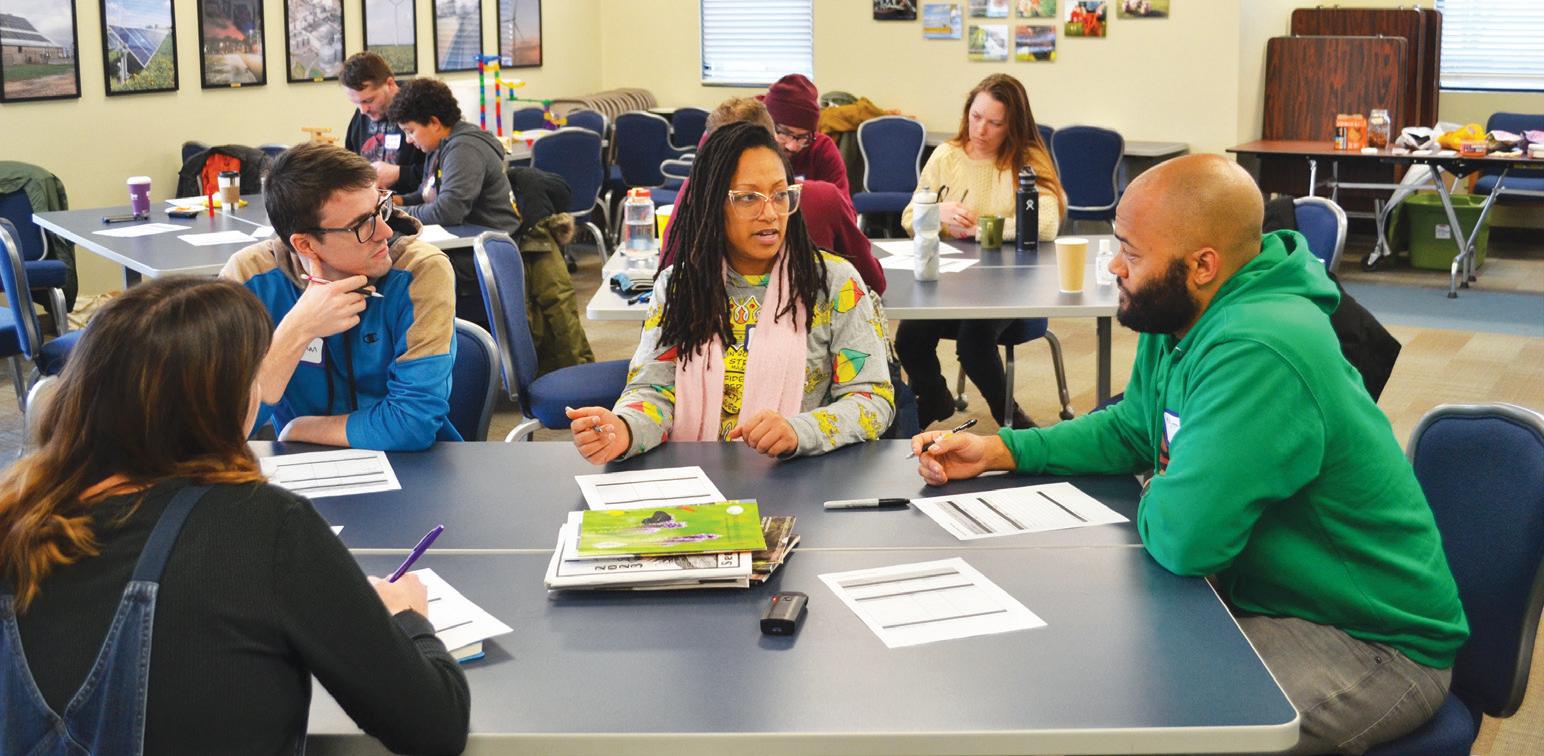
Olson took the participants through a real life enterprise budget from his own farm involving a pastured hog enterprise they launched a few years ago. He flashed up charts showing how they documented the cost of the pigs, feed, equipment, shelter, fencing — even the fuel used to drive the fattened hogs to the processor. He then totaled up all the expenses and used that amount to figure out what to charge.
“It puts you in the driver’s seat,” said the farmer of this process, adding that it’s preferable to “looking back” at an enterprise after the fact. “You can be in charge of your numbers, rather than having your numbers be in charge of you.”
It’s not all about numbers. Constant Class, see page 22…
The Land Stewardship Letter 21 No. 1, 2023
Farm Beginnings
During a recent class, Farm Beginnings participants held a small group discussion on enterprise budgeting. “You can be in charge of your numbers, rather than having your numbers be in charge of you,” said class facilitator and farmer Nick Olson. (LSP Photo)
…Class, from page 21
monitoring of how an enterprise fits with one’s values and quality-of-life goals is also key. In the end, the Olsons stopped raising pigs because of the hassle of things like transporting them to the processor.
“The stress no longer matched the income it brought in,” he said. To make up the lost income, they decided to sell a few more CSA shares.
6 Choices = Lots of Questions
Olson then broke the class up into six groups, each of which was tasked with developing a budget for a specific enterprise:
1) 15 feeder lambs;
2) 250 meat chickens;
3) 10-week mixed vegetable farmers’ stand;
4) six-week u-pick raspberry operation;
5) agritourism enterprise that includes rustic farm stays;
6) 100 laying hens.
The class participants punched numbers into their phones’ calculators while holding intense conversations around the tables. They then filled out numbers on enterprise budgeting worksheets that had been handed out. When the large group reconvened, there were lots of questions:
• In the chicken enterprise, if they produce compost that can be sold, should that be in the enterprise budget? Yes, and don’t forget that fertility from livestock is invaluable and may be worth keeping on the farm.
• Our exercise showed we made only $400 from feeder lambs. What did we do wrong? Nothing. It’s a good example of how grass-based livestock enterprises don’t pay off for a few years.
cut-flower farm. One man who works as a carpenter and has two small children owns land in Wisconsin and is considering setting up a silvopasturing operation. But he’s taking his time. “I’m waiting to see what the land wants,” he said.
Millions of Mistakes
Presentations by established farmers are at the bedrock of the Farm Beginnings course. After lunch, Les Macare, who operates Racing Heart Farm near Colfax, Wis., with Els Dobrick, talked about how they were able to grow the CSA operation from a tiny operation on rented land in 2014 to 115 shares on a farm they purchased in 2017. They also sell vegetables through a farmers’ market and to a food co-op.
“The thing about being a beginning farmer is as soon as you take a photo, it’s
vehicle,” Macare said. “You can fit about $1,000 worth of market product in a Grand Caravan. You can even transport veggies in air conditioning.”
The farmer explained how purchases were divided into immediate needs — tillage equipment, seeders — and big ticket items that they waited years to buy — a walk-in cooler, a full greenhouse, a pack shed.
At one point, Macare showed a slide that asked the question, “When is it time to spend big for your farm?” Well, the farmer explained, don’t build a pack shed or dig a well on rented land, but it’s okay to buy items up front that can be moved when one obtains a “forever farm.”
One thing that can be “portable” is a market for one’s products. Macare recommended building a market before buying land, and, in a sense, carrying that market with you. It’s a major risk to purchase land with no way to make a living on it, advised the farmer.
Class participants had questions about whether it’s worth taking LSP’s follow-up course, Journeyperson (see page 23). They also had queries about taxes, soil tests, where to buy plants, and whether it’s worth renting greenhouse space. Any big mistakes?
“We’ve been lucky in that we didn’t make any big mistakes,” said Macare. “But we made a million little mistakes.”
They added that getting work experience on other farms was invaluable; Macare’s experience working at a food co-op has provided insights into the retail end of the business.
“We’ve been lucky in that we didn’t make any big mistakes,” said CSA vegetable farmer Les Macare. “But we made a million little mistakes.” (LSP Photo)
One student, a young Black man, asked a question that touched on a sensitive topic brought up earlier in the class: what is your quality-oflife like in a rural area?
• What if we have to buy the lambs a month early? What about long-term expenses like orchard trees? What about depreciation of equipment? Those are excellent questions. That’s why we do enterprise budgeting.
During lunch, participants discussed their dreams, challenges, and plans. There was talk of developing everything from pasturebased livestock enterprises to a CSA-style
out-of-date,” Macare, who prefers the pronoun they, said with a laugh while showing PowerPoint slides of the farm. A packing shed, hoop houses, and a deer fence have all been added to the former dairy operation in recent years. Macare showed a slide of their first budget in 2014 — the farm produced $5,000 in income and they started seedlings on the bedroom floor, watering them with a child’s watering can.
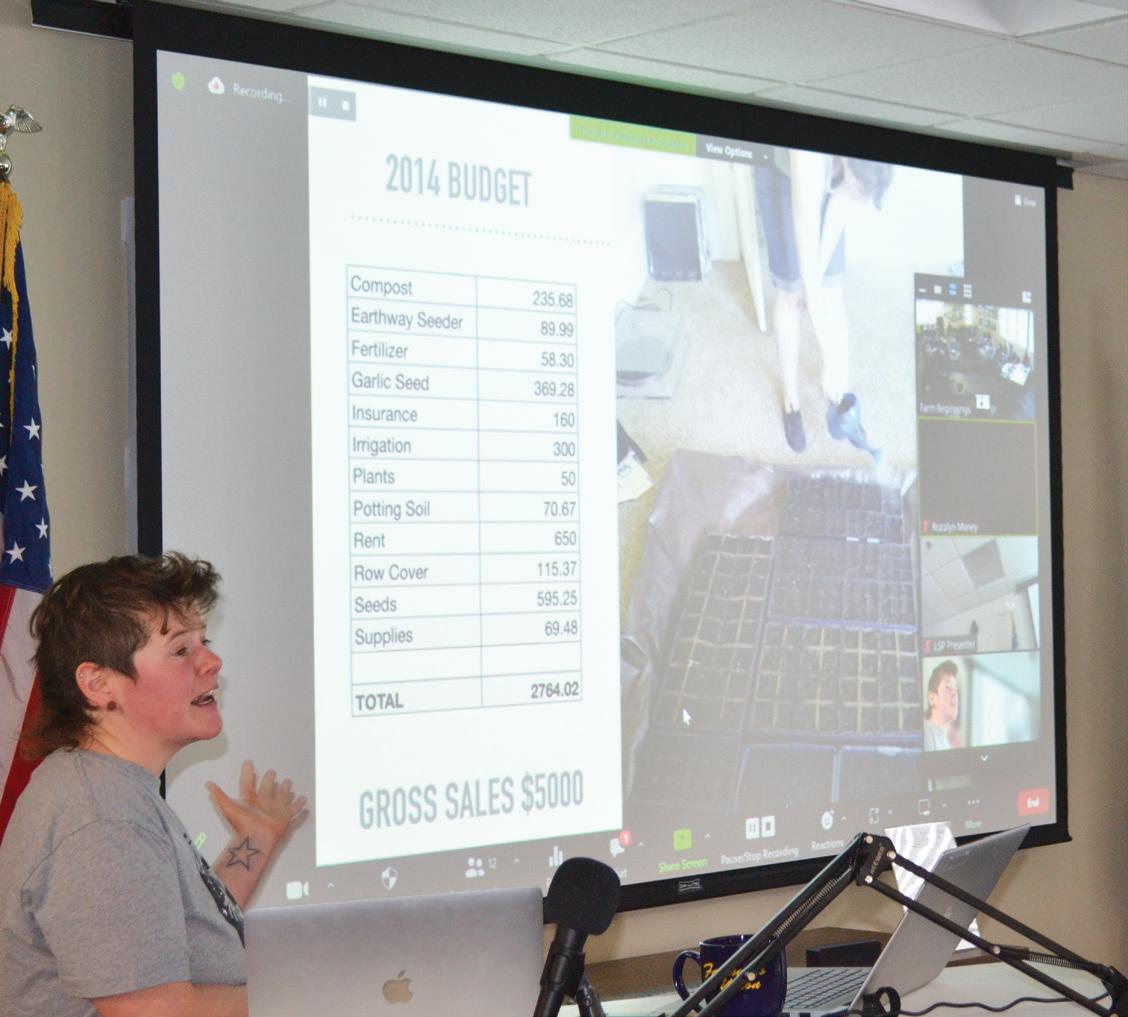
Macare took the class participants through a detailed list of what they required to get started farming: finances, land, labor, implements, even transportation.
“I can’t emphasize enough how much the mini-van is the perfect beginning farmer
It’s an important question: Macare and Dobrick identify as queer and moved to their farm from the Twin Cities, which has a relatively large community of LGBTQ people, as well as people of color. Macare said there are times they wish there was more of a queer community in their rural neighborhood, but they’ve had success creating a community of their own. It helps that all of their hard work is on display as people drive by on the road, which earns them respect.
“The only guy who has not been supportive is the guy who plowed our plots; he told the fence-building guy, ‘I give them six years.’ Whatever, plow guy,” Macare said
Class, see page 23…
22 No. 1, 2023 The Land Stewardship Letter
with a laugh.
Cultivating Mental Health
The day was wrapped up with, as LSP organizer and Farm Beginnings graduate Pilar Ingram put it, a shift in gears. “We’ve been talking all day about finances and other types of stuff, and now we are going to talk about something that’s completely different, but equally important,” she said.
Concerns about ways to strike a “worklife balance” in farming were brought up throughout the day, in both table talk as well as in large group sessions, and a class survey earlier had shown participants wanted to discuss mental health strategies.
“I’ve done farming where it’s nothing but farming for five or six months,” said one participant during a small group discussion. Another said he watched his father and grandfather work fulltime jobs off the farm while trying to manage a large cropping and beef operation. “I want a better work-life balance,” he said.
Participants were asked to spend five minutes writing down the answer to this question: What do you think might force you to quit farming? Answers that emerged:
body physically gives out, lack of community, it takes too much time away from the children, racism, inability to get away from the farm, and, finally, simple burn-out. Heads nodded in agreement when people shared their fears.
“You’re all unique and wonderful people, but I’ve heard all this before,” Olson said.
With that, Vahisha Hasan, a mental health expert from Memphis, Tenn., joined the class via a Zoom connection. Hasan pointed out that there needs to be more of an emphasis on “community care,” something that’s difficult in a country that emphasizes the individual to such a great extent. Farmers, in particular, need to learn that asking for help is not a weakness.
“Farming is a particular kind of frontline work,” said Hasan, adding that frontline work comes with its own set of mental health challenges. “You deserve support.”
Hasan then guided the class participants through a wellness plan that had been handed out. It was a step-by-step guide for noting and monitoring one’s own mental wellbeing, as well as that of other family members, friends, or neighbors. As Hasan pointed out, being aware of the warning signs isn’t enough — a mental wellness plan should include specific steps for dealing with stress, including who should be aware of what
indicators to look for that things aren’t going well for you, and what short-term, and longterm, strategies should be put in place.
Finally, Hasan counselled, when you feel like you’re having an existential crisis brought on by issues like climate change, recognize the stress that causes as an “everpresent danger” that looms over you. That’s when community is more critical than ever. At times, hang out with people who share those concerns, but also take the opportunity to be with a community that’s experiencing “pure joy,” Hasan recommended.
“In my 14 years of working with Farm Beginnings, this is the first time we’ve talked about mental health during class time, and I think it’s a mistake,” said Olson. “I’ve seen a lot of people stop farming. If mental health was given the same importance as enterprise budgeting, maybe some of those people would have kept farming.” p
Give it a Listen
Interested in hearing directly from the next generation of innovative farmers? Check out the Land Stewardship Project’s Ear to the Ground “Fresh Voices” podcast series: landstewardshipproject.org/fresh-voices.
FB Course Accepting Applications for 2023-2024
Beginning and prospective farmers are invited to apply to the Land Stewardship Project’s Farm Beginnings course, a training program that focuses on the goalsetting, marketing, and financial skills needed to establish a successful farm business. The class will run from November 2023 through March 2024, with some additional educational opportunities to take place later in 2024. To view the class schedule, see https://bit.ly/FBClassSchedule.
The deadline for applications is Sept. 1. The cost of the class is $1,000 for up to two participants per farm. Early bird applications submitted by Aug. 1 will receive a $100 discount if you are accepted into the class. Scholarships will be available. For more details and to apply, see landstewardshipproject.org/farm-beginnings-class.
Reach out with any specific questions by contacting LSP’s Pilar Ingram at pingram@landstewardshipproject.org, 612-400-6349; or LSP’s Annelie Livingston-Anderson at annelie@landstewardshipproject.org, 612-400-6350.
For more information on LSP’s Journeyperson course, which can serve as a good follow-up to Farm Beginnings, see landstewardshipproject.org/journeyperson-course or contact Livingston-Anderson.
Is Farming for You?
By the way, if you’re trying to figure out if farming is the right career path for you, take part in LSP’s Farm Dreams Visioning Exercise at landstewardshipproject.org/ farm-dreams-workshop. p
Farm Beginnings Guiding Principles
The Land Stewardship Project is a member of the Farm Beginnings Collaborative, a coalition of community-based groups that offers the Farm Beginnings course in several states. The Farm Beginnings Collaborative adheres to the following principles for the course:
➔ Farmer-led: Class participants will hear from regional farmers about their farms and how they’ve implemented goal setting, marketing, and financial management practices.
➔ Community Based: Because LSP is best able to provide resources and connections in this area, applicants from Minnesota, western Wisconsin, and northern Iowa will be given priority. If you are located elsewhere, check out the Farm Beginnings Collaborative website at farmbeginningscollaborative. org to see if there is an organization near you offering Farm Beginnings.
➔ Racial Equity: We acknowledge the historical and ongoing racial inequities and oppression in agriculture towards farmers and communities of color. We commit to furthering our own understanding and supporting the farmers we interact with to do the same. We commit to using the power and influence we have across our organization to build more inclusive and equitable agricultural systems and implement changes that make it possible for more farmers of color to be successful.
➔ Focused on Sustainable Agriculture: All farmers are encouraged to create a farm plan that is economically, socially, and ecologically sustainable.
The Land Stewardship Letter No. 1, 2023 23
…Class, from page 22
Farm Beginnings Thinking Like a Tree
Soil, Cicadas & Spreadsheets: Playing the Long Game in Farm Country
There’s farm planning. And then there’s long-term farm planning. Figuring out what kind of rotation to use the following growing season is one thing; picturing what the entire farm will look like in a decade or so is quite another. Abbie Baldwin and Mitch Hawes are well aware that when the enterprise you are undertaking involves trees and other elements of permaculture, getting immediate gratification isn’t part of the package. In fact, on a summer day they were doing some longterm math while walking their patch of ridgetop land just outside of La Crosse in southwestern Wisconsin.
For one thing, they had just planted 30 chestnut trees that won’t be hitting their production stride for another 10 to 15 years. The fruit orchard they are planning could start generating income a little sooner — standard apples can be marketable as soon as seven years after planting. But hold on to that rootstock: first they need to build back the soil on land that’s been “cornon-corn-on-corn” for the past 40 or 50 years, and the possible arrival of a devastating pest in 2024 has prompted the couple to delay planting fruit trees until 2025. Baldwin and Hawes are both in their early 30s, which means their farming dream may not come to fruition until they are in their 40s. But, they say, working with a stretched timeline has its advantages — it’s giving them the opportunity to build the kind of agronomic, economic, and lifestyle foundation needed to make their farming enterprise a success decades down the road. In a way, they feel they’ve been given the rare gift of time, and all the advantages that come with having a calendar cushion.
“That’s the beauty of trees — it’s really a long game,” says Hawes while looking at a newly planted windbreak of evergreens.
“It’s refreshing just to plan for the future in a world that’s constantly going and doesn’t want you to do that. Let’s do it right the first time.”
Long-term planning is a little easier for the couple since they took the Land Stewardship Project’s Farm Beginnings course (see page 23). Among other things, the class exposed them to Holistic Management, a planning system that focuses on “big picture” decision-making and goalsetting processes.
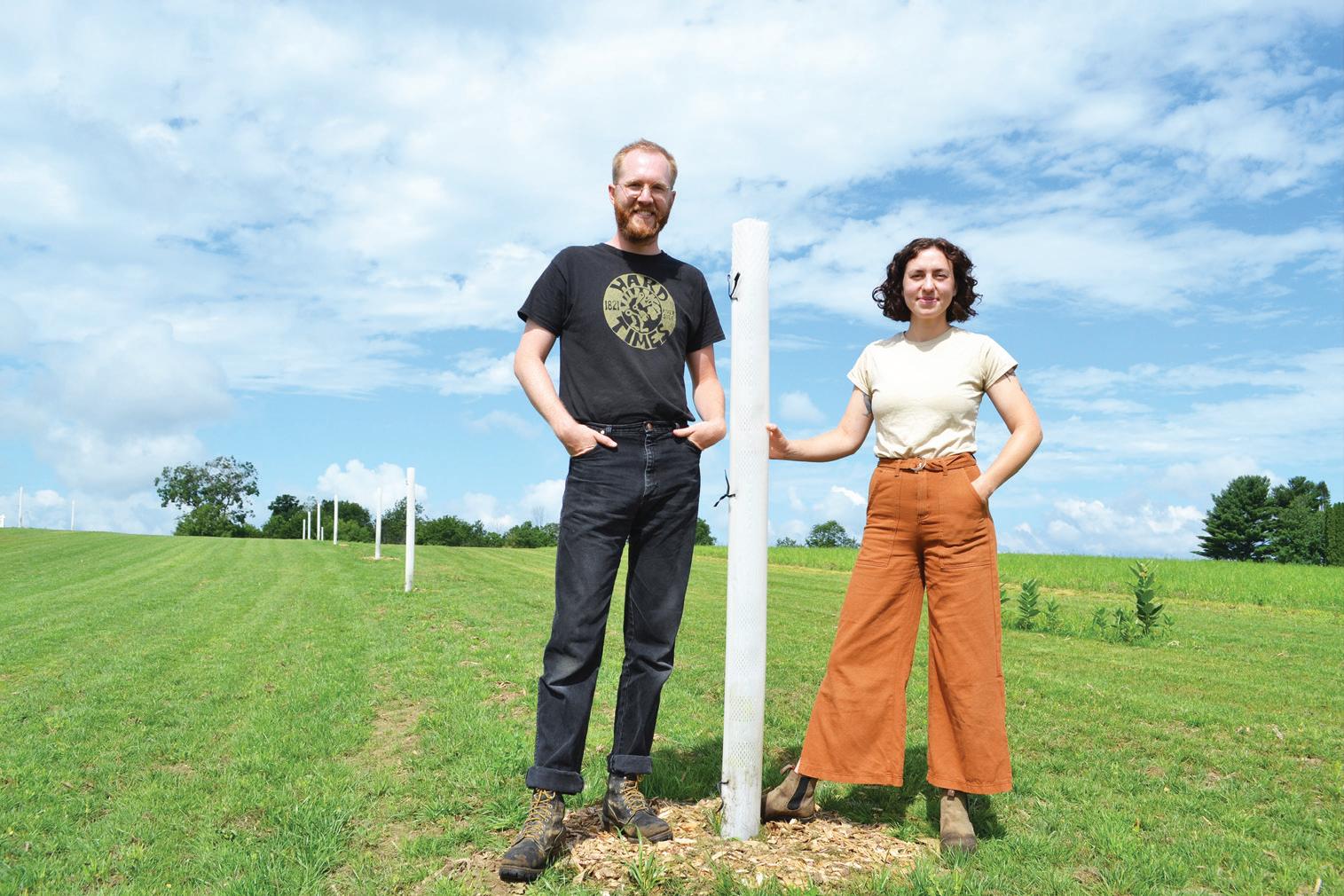
self-conscious, like, ‘Are we being idiots? Are we doing this right? Here we go, let’s learn how to drive a tractor,’ ” says Baldwin.
“We are the people planting trees in a cornfield, so…,” adds Hawes with laugh.
Permaculture’s Promise
Hawes and Baldwin were already hooked on permaculture before they took the course. But as a result of the exposure Farm Beginnings gave them to holistic business planning and goalsetting, as well as their interactions with other farmers who were involved with fruit and nut production, the couple also got a clearer picture of how to play the long game financially — even if it means developing a spreadsheet that crunches numbers for the next 15 years, or maybe being the oddballs in the neighborhood who aren’t growing corn and soybeans.
“Being new to farming, we’re just very
Hawes and Baldwin didn’t grow up on farms, and never really considered it as a career path until a few years ago. Baldwin has an art degree from the University of Puget Sound, grew up in the Twin Cities, and has extensive experience working in landscaping and gardening. Hawes hails from southwestern Wisconsin and grew up in a place he calls, “a subdivision in the middle of nowhere.” While in business school at the University of Wisconsin-Madison, he learned mostly about how to pursue a career in the corporate realm, rather than how to be a rural entrepreneur. However, both of them grew up in the shadow of climate change, and are eager to figure out how they can play a role in creating a healthier planet. After they had been dating about a year, they took a course offered by Bill and Becky Wilson of Midwest Permaculture in Illinois. Permaculture is a way of producing food and other products that relies on “permanent” establishment of plants, rather than annual cultivation of row crops and small grains, for example. Trees are the anchors of such systems; fruit orchards, nut plantings, berry bushes, and silvopasturing techniques that integrate livestock and grazing are often associated with such enterprises. Permaculture has attracted the interest of the environmental community — it’s seen as a way to build soil health and reduce reliance on chemical and energy inputs, all while protecting water quality, sequestering carbon, and providing wildlife habitat. Before Hawes and Baldwin enrolled in the Illinois course, they saw permaculture as a pathway toward stewarding a piece of land, but weren’t convinced it could be a fruitful way to make a living. The course changed that mindset.
Tree, see page 25…
24 No. 1, 2023 The Land Stewardship Letter
Mitch Hawes and Abbie Baldwin in a former cornfield where they’ve planted chestnut seedlings. It could take almost a decade before their permaculture operation has marketable products. “We’re planning on being here for awhile, so let’s not take shortcuts,” says Hawes. (LSP Photo)
…Tree, from page 24
“Bill and Becky really laid it out that you can make a living off trees — it doesn’t just have to be a hobby,” recalls Hawes.
But it was clear knowing what varieties of trees to plant was not enough. The couple was going to need to figure out how to do long-term entrepreneurial business planning if they wanted permaculture to be a fulltime career. In 2020, they enrolled in the Farm Beginnings class being offered in Menomonie, Wis. Through the class, LSP organizers introduced students to holistic planning and goalsetting, and established farmers, as well as experts on farm financing and other topics, gave in-depth presentations.
Farm Beginnings forced Baldwin and Hawes to do the “homework” of considering various enterprise options and then putting on paper what the breakeven needed to be to make them viable. The timing of the course was critical for them as a couple, given that they had been together a relatively short amount of time and needed the skills to talk through what they valued in their personal and work lives.
Baldwin says such relationship building is particularly important given that they both need to buy into doing trees as a long-term enterprise.
“It’s not like we can grow veggies for a couple summers and if it doesn’t work out we can part ways,” she says. “No, we’re going to be intertwined for quite some time.”
Of particular interest to Baldwin and Hawes was the information shared during a class presentation by Rachel Henderson, who, with her husband Anton Ptak, took Farm Beginnings several years ago. Since graduating, Henderson and Ptak have built up, from scratch, a western Wisconsin permaculture operation that involves extensive plantings of fruit trees and berry bushes. They’ve recently integrated livestock into the operation, which, before they arrived, was basically an open hayfield.
“It was interesting to think about all the possible enterprises we could pair with fruit trees,” says Baldwin. “Farm Beginnings was helpful in throwing out all the ideas we possibly had and then narrowing it down to what fits together logistically.”
Ancient History
Despite the hands-on nature of Farm Beginnings, much of what was discussed in the class was hypothetical to the young couple. That changed a year after graduation when, after a seven-month search, they found a 25-acre farm outside of La Crosse. The
parcel meets many of the criteria they set for themselves when they started searching for land: 10 to 20 tillable acres (14 acres of this land is tillable; the rest is in timber), a house on-site, and relatively close to a good metro market. Because it had been rented out for row crops for several decades, the tillable acres have plenty of open space for planting trees. But room to roam comes at a price — they once dug a foot down and still found remains of corn plants that weren’t broken down from previous growing seasons.
“It was like doing an archeological dig,” says Hawes as he and Baldwin take a look at the rows of tree-tubed chestnuts growing in one seven-acre field. “It was clear there was not much biological activity in the topsoil.”
pests in the world mean little in the realm of developing a working farm enterprise that generates a viable income. That’s why Hawes put his business school background to work by developing a long-term breakeven spreadsheet.
Soon after they moved to the farm, the couple planted a cocktail mix of cover crops to start building up the organic matter. They also inoculated the soil with mycorrhizal fungi in an attempt to kickstart biological activity. On this summer day, they were excited to see a few toadstools emerging from the soil — a good fungal start, anyway.
“This is the first year in probably 50 years that our land hasn’t been sprayed and planted with corn,” says Baldwin. “With trees, it’s not like we’re going to be tilling our land every year and planting annuals. This is kind of our one shot to get the soil health up and ready so by the time we plant the fruit trees they have the best shot of growing and surviving and having the nutrients that they need.”
An added twist has stretched Mitch and Abbie’s timeline further. It turns out that in 2024, an insect called the periodical cicada is expected to arrive in the area. That’s bad news for a tree that’s just getting started. After spending 17 years underground as nymphs, adult cicadas emerge en-masse, and can cover small trees and lay eggs in the wood, decimating, or at least stunting, the plants. To be safe, the couple won’t be planting fruit trees until at least 2025. They eventually want to raise heritage varieties of apples, as well as pears, plums, and chestnuts.
Long Division
Making good use of delayed gratification means crunching numbers along the way. Otherwise, all the organic matter or avoided
The spreadsheet consists of 15 columns, and each column represents a year. On the rows that run down the left-hand side of the spreadsheet is a section that represents expenses and a section that represents income. The couple has used the spreadsheet to forecast their expenses for those crucial “setting up” years. They’ve already bought a used tractor and a broadcast seeder, and will eventually need to invest in such things as deer fencing. The long-term view the spreadsheet has developed gives them confidence that these investments will begin to pay off — somewhere around year 10 or 12 when they have marketable products. And the couple feels permaculture is the kind of enterprise that can be prepped for over the years while they hold down off-farm jobs and maintain good cash flow; Baldwin is employed at Ethos Green Power in nearby Viroqua, Wis., and Hawes works remotely for an insurance company.
“It’s way more fun to look at apple varieties than it is to put together a breakeven spreadsheet, but the breakeven spreadsheet is arguably more important than understanding the varieties,” says Hawes
They are also spending their planning years figuring out such strategies as whether to sell apples wholesale or if they should bring customers to their farm via a u-pick enterprise — or a combination of both. In a sense, that spreadsheet isn’t just predicting financial breakevens — it’s also trying to forecast what role Hawes and Baldwin can play in making the planet a better place. The more their farm provides a fulltime income, the more they can concentrate on building its ecological resiliency.
“It’s broader than just making money off of our crops,” says Baldwin. “Through permaculture classes and then Farm Beginnings, we began to see agriculture as a way to steward the land in a sustainable, regenerative way. It gave me hope that we can improve the soil and the quality of our food — they don’t have to be separate things.” p
Give it a Listen
On
Ear to the Ground podcast episode 302, Abbie Baldwin and Mitch Hawes talk about playing the long game when it comes to launching their permaculture operation: landstewardshipproject.org/podcast/ear-to-the-ground302-thinking-like-a-tree.
25 No. 1, 2023 The Land Stewardship Letter
“It’s way more fun to look at apple varieties than it is to put together a breakeven spreadsheet. But the breakeven spreadsheet is arguably more important than understanding the varieties.”
— Mitch Hawes
A Home Away from Home
When Melissa Driscoll Climbed Down the Ladder, She Reassessed Sustainability
Every living thing needs a home — even ginger, tomatoes, and garlic. And southeastern Minnesota farmer Melissa Driscoll sees written contracts as handy and efficient vehicles for getting her produce to their final destination.
An extensive use of forward contracts isn’t just good for business — it gives Driscoll the kind of peace of mind she strives for on her diverse, seven-acre, organic operation near the community of Kenyon. She and her husband, Jay Hambidge, purchased the farm in 2010 after taking the Land Stewardship Project’s Farm Beginnings course (see page 23), where they learned how to do the kind of big-picture planning that can put ecological health on the same level as productivity and financial viability. Just as importantly, an LSP follow-up course the couple took a few years ago, Journeyperson, helped clarify how important it is to prioritize the physical and mental health of the farmers themselves. As she sees it, she got into farming committed to doing it in a regenerative, sustainable manner, and that sustainability should extend all the way from beneath the soil to the people who are doing the work. If you are doing farming out of the mainstream, why should one take on the mainstream way of working oneself into the ground?
“When I first started farming, I just thought I could work myself to the bone and it wouldn’t matter,” Driscoll, who’s 57, says. “The work will always be there, but you might not be there to do it unless you take care of yourself.”
Pecking Away at a Passion
Which came first, the chicken or the egg? For Driscoll, it was definitely the chicken(s).
When she was around 10-years-old, her great-uncle Charlie showed up at her family’s house near Afton, Minn., with 25 hens and a rooster, along with a simple message: “These are for Melissa.” Her parents built a
results, to convince conservation officials that farming and a healthy ecosystem can play nice with each other. In short, whatever work she did, she tried to not separate farming from nature.
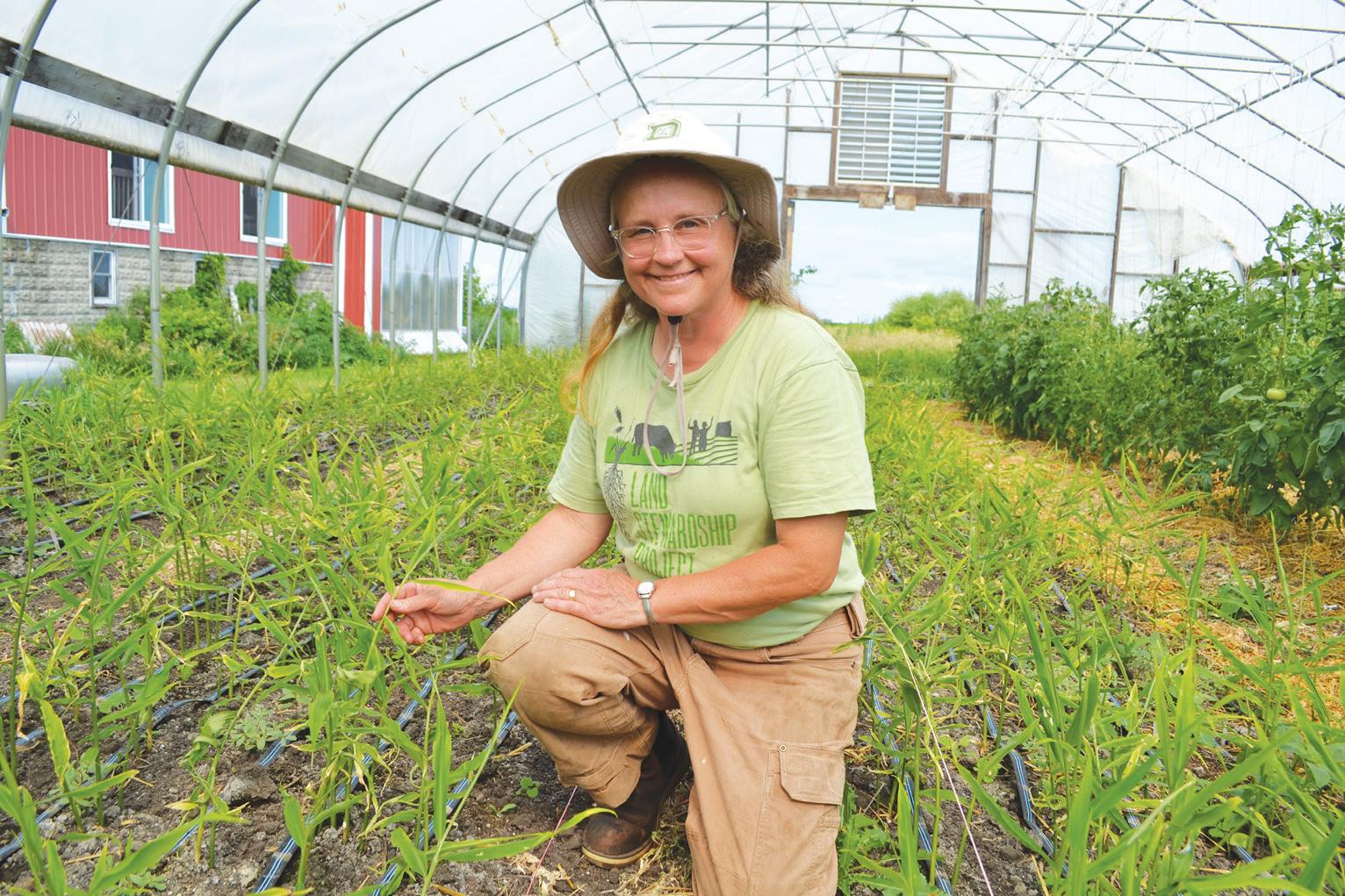
“My passion is the place between ecology and agriculture,” she says. “I think you can have biodiversity and farming in the same place.”
Driscoll is in the midst of her 13th season operating Seven Songs Organic Farm (sevensongsfarm.com), which, in a way, is the place where that passion is being realized. Besides a restored native prairie, it’s home to numerous farming enterprises — she raises eggs, as well as garlic, heirloom tomatoes, and a variety of herbs. Driscoll also produces a popular jarred product called Escape Garlic Scape Pesto. But perhaps the farm is best known for the ginger it grows, and for two years she trained members of the Hmong American Farmers Association how to raise the crop.
“They kind of trained me; we kind of trained each other,” she says with a laugh.
coop and Melissa went on to show chickens at the Washington County Fair and Minnesota State Fair. This launched a lifelong fascination with chickens, birds, and how food can be produced in a way that contributes to a healthy environment for avian species and wildlife in general. The farming side of that passion was fed by her mother, the late Cynthia Brackett Driscoll, a master gardener who wrote extensively on organic practices. Melissa went on to get a master’s degree in conservation biology, with a sustainable agriculture systems minor, and over the years has done research on, among other things, the impact rotational grazing has on grassland songbirds. She raised chickens on various farms and got experience in the retail side of the food business by working at a food co-op. Driscoll also worked at the Minnesota Department of Natural Resources for 15 years, during which she tried, with mixed
Customers for the farm’s products include food co-ops and distributors such as Co-op Partners Warehouse and TC Farm, as well as specialty businesses that make products such as teas and kimchee. The eggs are delivered to Twin Cities customers on a weekly basis by Hambidge.
Listening to the Knees
Driscoll says Farm Beginnings gave her the kind of business planning and goalsetting expertise she needed to run a diversified, organic farm. It also connected her with established and beginning farmers who were pursuing alternative production and marketing strategies. But Driscoll admits that once she finished the class and she and Hambidge bought the farm, they figured that pure sweat equity would be the road to success. And that strategy worked — for awhile.
Half-a-dozen years ago, she and Hambidge took LSP’s follow-up course to Farm
Farm Beginnings
26 No. 1, 2023 The Land Stewardship Letter Home, see page 27…
Melissa Driscoll and a stand of ginger, which she markets via contracts she negotiates during the winter. “It just works so well to know what I’m growing already has a home,” she says. (LSP Photo)
…Home, from page 26
Beginnings, Journeyperson, “as a way to check in after putting in years of grunt work,” Driscoll says. The Journeyperson course (see page 23) is designed to support people who have several years of managing a farm under their belt, and are working to take their operation to the next level. It provides advanced farm business planning and a mentorship connection with an established farmer, as well as guidance on balancing farm, family, and personal needs. Driscoll says the course came at a good time, both personally and professionally. Hambidge concedes that he isn’t as passionate about farming as Driscoll, so having an opportunity to check in on each other’s goals and motivations was invaluable.
“I felt like Journeyperson helped refocus Jay and I as a couple,” recalls Driscoll. “I’m more of the farming person and he does support me when I ask him, he’s very supportive. But it’s not his dream and we need to communicate about what I want to do compared to what he wants to do.”
The course reinforced that Driscoll likes to work hard outdoors raising food, and wants to spend less time doing things like processing pesto in a windowless commercial kitchen. But the perspectives she gained via Journeyperson also helped the farmer realize she had to pace herself if her business was to be viable in the long term.

During the fall of 2021, she was building a greenhouse when she had an epiphany: if she didn’t take care of her body, that body wouldn’t be able to take care of the farm. It turned out going up and down the ladder all day was trashing her knees, to the point that in order to climb the stairs in her house at the end of the day, she was forced to crawl on all fours. These days, before she steps outside the house in the morning, the farmer spends time doing knee exercises. It may mean getting out in the garden plots a little later, but she believes it’s worth it if she’s to continue farming in the future.
example, for years Seven Songs grew two rows of raspberries in a hoop house.
“I love raspberries. Yum! And people buy ‘em,” she says. But then the spotted wing drosophila fly made an appearance. Driscoll ended up spending a lot of time picking around the damaged fruit and came to the realization that there was a better use for some relatively expensive growing facility real estate. It wasn’t easy, but she decided to rip out the raspberry bushes.
“I can make more money on tomatoes and ginger,” she concluded.
Home Cooking
But it’s not just the physical nature of farming that can be stressful. Selling a wide variety of products to various customers is nerve-wracking, what with orders to fill, transportation headaches to deal with, and struggles with juggling supply and demand. The fear of the unknown can wear on a body, as in, it’s unknown if everything I am raising will have a profitable market. But, like her physical wellbeing, Driscoll has taken an approach to marketing that she feels keeps her life financially and emotionally stable. At one point, she sold much of her production through farmers’ markets, and was good at it — she loved chatting up customers and getting direct feedback about the quality of her products. But she tired of the early morning set-ups and the situations where she didn’t always sell everything she had hauled into town. So she started focusing on wholesaling what she raised.
Give it a Listen
OnEar to the Ground podcast episode
307, Melissa Driscoll talks about how Farm Beginnings and Journeyperson taught her that true sustainability starts not only with the soil, but with the person who’s stewarding it: landstewardshipproject.org/ podcast/ear-to-the-ground-307-listeningto-the-knees.
ging it or whatever,” she says. “And then it’s finally going to the place I’ve agreed upon with the people, at the price we’ve agreed upon, at the time we’ve agreed upon. Mostly, it just works so well to know what I’m growing already has a home.”
Journeyperson also helped her look at each part of the farm and identify weak links, even when she has an emotional attachment to an enterprise. Driscoll likes to do the weak link analysis during the winter when she has more time to execute a kind of “thought experiment” that mixes a little math with a lot of contemplation. For
After a bad experience where she had ramped up garlic production for a restaurant that dropped her as a supplier, Driscoll turned to utilizing written contracts for marketing. Sitting at her dining room table on a summer afternoon, she pulls out one of the contracts; in this case it’s for providing herbs to a tea maker. It stipulates how much the farm will provide, the price, and delivery dates. If there is some sort of disaster that prevents Seven Songs from delivering on the contract, it’s Driscoll’s responsibility to tell the buyer as soon as possible. “That’s my out — I just have to communicate well,” she says.
One buyer of ginger has good cash flow in the spring, a time when Driscoll’s income is low, so that business has agreed to pay her early for product that won’t be delivered until later in the season.
“So I’m planting the seed, growing the plant, picking the fruit of that plant or dig-
After putting away the contract, Driscoll gives a tour of a packing shed and greenhouse area that’s part of a classic refurbished red barn. It’s clear the area was designed to be efficient and to minimize unnecessary labor as much as possible: carts and drying racks are on wheels for easy movement, and tables and wash basins are set up at comfortable heights. She climbs the stairs to the airy hayloft where south-facing windows look out onto surrounding farmland. The former forage storage area has been remodeled in a way that it’s an efficient place to process garlic. Just as importantly, it appears to be a pleasant place to work. That’s important not just for Driscoll and Hambidge — community is critical to the couple and they often invite customers and friends over for work parties at the farm. Driscoll also networks with other farmers and neighbors in the area, and she’s part of the Cannon River chapter of the Sustainable Farming Association, which gets together for monthly socials.
After all, she wonders out loud, what good is it to do a type of farming that’s called regenerative, “if we’re not regenerating us?” p
27 No. 1, 2023 The Land Stewardship Letter
Driscoll with a tray of drying bachelor’s buttons she raises for a specialty tea maker. She says Farm Beginnings and Journeyperson helped her look at each part of the farm and identify weak links. (LSP Photo)
Talking Through Tough Choices
Transforming a Wish List into a Viable Farming Operation
There’s a bit of a disagreement over how many enterprises were originally on a certain wish list when Hannah Frank and Justin Thomas were considering launching a farm.
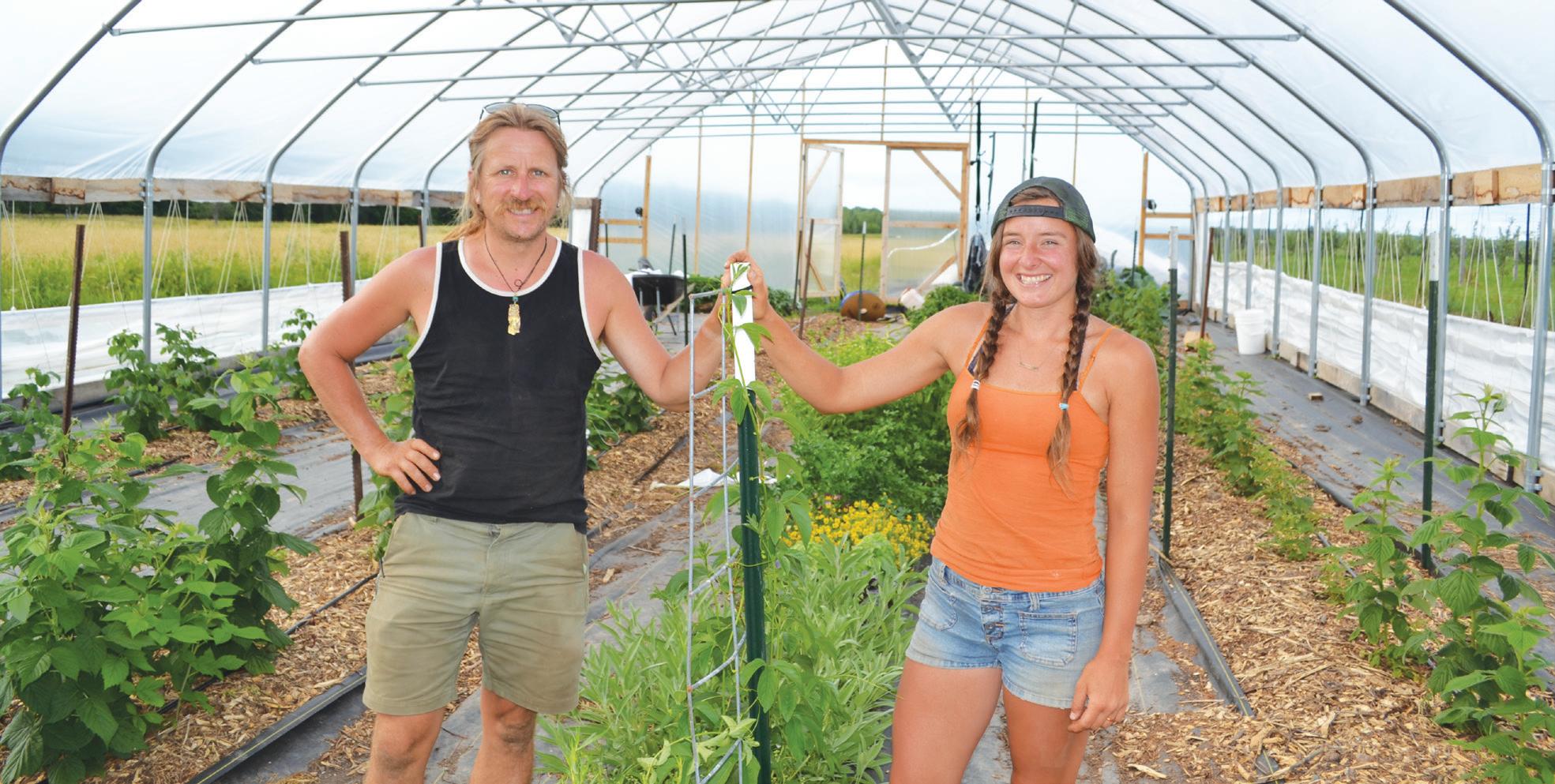
“Didn’t we have, like, 40 different enterprises on our goal sheet?” Thomas asks Frank on an overcast day in July while the couple stands next to a hoop house on Rue de Bungaloo Farm.
“Oh, we did not!” Frank shoots back. “I’m going to have to go back and count them. I still got the binder. I think it was more like, maybe, seven. Not 40.”
“It was a lot,” says Thomas.
“Well,” concedes Frank with a laugh, “you have to work through them all and see what you like.”
Apparently, a dinner wager is on the line as to whose number is right. But one fact is clear: Frank and Thomas have used the holistic training they received through the Land Stewardship Project’s Farm Beginnings course (see page 23) to narrow down what they will focus on, and to figure out how to balance profitability and environmental sustainability, along with a little fun.
Since purchasing 12 acres of a former dairy farm from Hannah’s father, Dale, in 2021, Frank and Thomas have been busy building an agricultural business in northcentral Wisconsin’s Marathon County. After just two years, their farm is already showing signs of being relatively diverse, even if the enterprises can’t be counted in the dozens.
As the couple’s good-natured argument makes clear, striking items off the wish list hasn’t been easy. But it was a particularly heart-wrenching decision for Frank when it came to one enterprise they had to put into the “no”column: a small dairy. That choice
came laced with economic, quality-of-life, emotional, and familial repercussions.
“It’s kind of hard to have a normal conversation about that kind of thing. It’s stressful,” she says. “But when we were doing it as an exercise in the Farm Beginnings class it was really helpful for both of us to kind of lay out the things that we wanted to be happy, to not be totally stressed.”
vegetable operations in her community — Stoney Acres Farm, Cattail Organics, and Red Door Family Farm — proof that a living can still be made in agriculture. Frank eventually majored in agriculture studies with an emphasis on environmental science at the University of Wisconsin-River Falls.
Thomas, 44, grew up 15 miles away and although he didn’t come from a farming background, always had an interest in plants and vegetables. The couple met while they were both working at Stoney Acres, and eventually set about gaining as much farming experience as possible. Frank was particularly interested in “reviving the family farm” by starting a micro-creamery on her family’s land. She worked at the River Falls dairy plant and got cheesemaking experience at a micro-dairy in western Wisconsin. She and Thomas eventually enrolled in the
Local Roots
When she was younger, including anything related to agriculture on a wish list was pretty much out of the question for Frank. In fact, she grew up on a small dairy just across the fence-line from her current farming operation. When she was about 15, her family sold the 32-cow herd because they, like many small dairies, were unable to make it financially anymore.
“I did not want to farm at all,” recalls Frank, 27. “I didn’t really like it, so I didn’t really pay very good attention.”
But she increasingly became interested in the source of her food and how it could be produced in an ecologically healthy manner. There are three well-established organic
Worldwide Opportunities on Organic Farms program and worked on two farms — one in Italy and one in France — that produced farmstead cheese.
Cheese Dreams
At one point, their plan was simple, if a bit full-to-the-brim: launch a micro-dairy and market cheese off the farm, all while raising market vegetables. They had the hands-on production experience in dairy and vegetables down, but knew such an audacious plan would require business acumen as well. Kat Becker, the owner of Cattail Or-
Choices, see page 29…
Farm Beginnings
28 No. 1, 2023 The Land Stewardship Letter
“We should make this a community where people want to stay. I hope that’s what we’re working toward doing,” says Hannah Frank, shown here with Justin Thomas on their farm in north-central Wisconsin. (LSP Photo)
…Choices, from page 28
ganics, suggested they enroll in LSP’s Farm Beginnings course, which, among other things, provides in-depth training on holistic business planning and goalsetting. During the winter of 2019-2020, the couple drove to the class in Menonomie, Wis., where they were able to crunch the numbers with the help of trainer and northeastern Minnesota farmer Cree Bradley, gather resources on regenerative agriculture, and, perhaps most important of all, run an increasingly lengthy wish list through a gauntlet of questions. Are their markets available in the area? How much infrastructure is involved? What is the up-front investment? Will we enjoy doing the kind of work involved with this kind of enterprise?
“Just how you envisioned your lifestyle, what you wanted your life to be like, in the community and as a person, and what would make you a happy person?” says Frank of the questions they considered during that part of the training. Then, turning to Thomas, she adds, “Just seeing what you had to say in response to those questions was good for us and our relationship. It’s not something that would always come up in conversation if you didn’t actually sit down and talk about it and put it on paper. If we’re mentally broke down by farming, then we definitely can’t do it successfully or well, and then we can’t feed people, and that’s not good.”
Thomas concedes that he had not really had much experience with big-picture, holistic planning. “We just farm and get everything done, and not plan for the future,” he says, explaining his approach to agriculture previously.
The Farm Beginnings course also put them in touch with other farmers who were stepping off the conventional path to make a living in agriculture. Frank and Thomas say that through Farm Beginnings and other groups like Marbleseed and the Savanna Institute, they’ve greatly benefited from visiting various farmers in the region and seeing what they’re doing to make a go of it — warts and all.
“When I see their farms are not perfect, it makes me feel very good in a way, because it’s like, ‘Oh I don’t have to do everything right and I can still be successful and there’s no one set way of doing things,’ ” says Frank. “It makes me feel you don’t have to attain every standard of perfection.”
One question the couple mulled over at length was whether operating a micro-dairy was viable. Eventually, they realized after
going through goalsetting and planning that they really like working with plants outdoors. In addition, having a livestock enterprise would tie them down to the farm more than they’d like; they love traveling. Finally, Frank and Thomas found the regulatory, economic, and marketing environment for on-farm cheesemaking not as accommodating in Wisconsin as it is in, say, France.
“It’s very dreamy to make cheese in Europe,” says Frank. “It is not as dreamy here.”
But Frank admits she fantasized for a long time about dairy cows returning to her family’s land.
“People were excited about it, and for awhile I felt like I was letting people down and I felt guilty about it,” she says. “But there’s a reason there’s not a lot of microdairies. Going through the Farm Beginnings course, doing the holistic analysis of what we wanted, we realized we shouldn’t do
it just to do it. It has to be something that meshes with our lifestyle, that we’re going to be happy doing.”
What they did figure out they’d be happy doing is creating a farm centered around such enterprises as fruit and mushroom production. It turns out those enterprises make sense from a marketing point of view as well. Although there are plenty of vegetables being raised in the neighborhood, farmers’ markets and other outlets lack access to locally produced fruit and mushrooms.
After buying a piece of the original dairy farm, the couple set to work planting an orchard. They put up a deer fence scrounged from a neighbor’s scrap pile, and planted in a former hayfield dwarf and standard apple trees representing 40 or 50 different varieties. They’ve also planted raspberries and currants, and have over 500 mushroom logs — harvested from the property — representing various varieties, including shiitakes.
The farm now has two hoop houses, one built with funding from the USDA’s Environmental Quality Incentives Program (EQIP). The EQIP funding was key, given that the hoop house was erected when steel prices were exploding.
The sale of mushrooms through a local farmers’ market and a small Community Supported Agriculture share arrangement has been brisk, and is providing income for the farm at a time when other enterprises are still in the “potential” stage.
Give
it a Listen On Ear to the Ground podcast episode 306, Hannah Frank and Justin Thomas discuss how Farm Beginnings helped them whittle their enterprise “wish list” down to a sustainable size: landstewardshipproject.org/podcast/ ear-to-the-ground-306-tough-choices.
Home is Where the Farm is
While providing a tour of their orchard and hoop houses, Frank and Thomas talk about the support they have in the community. Despite some disappointment that cows won’t be milked here, family members are excited to see a new farm business of any type get launched in the neighborhood and have stepped up to help.
Frank’s father has provided tractor support and helped build mushroom tables, all while sharing insights on soil types and local weather. Her mother, Marilyn, owns a local restaurant and has promised to buy what they produce. Community and family are important — Frank points out her father’s parcel next door, as well as land her grandparents long farmed and still live on.
Now the couple represents a new generation rooted in the community’s past, but also bringing in new ideas. After all, the farm’s name — Rue de Bungaloo (rue-de-bungaloo-farm-llc.square.site) — combines local family lore with the couple’s love of the chef and foodie icon, Julia Child.
Both work off the farm on neighboring organic vegetable operations. Hannah is at Cattail Organics, and Justin works for Tony Schultz at Stoney Acres Farm, where, as “the most famous waiter in Marathon County,” he helps serve over 300 pizzas during pizza nights. Their eventual goal is to be able to live and work fulltime on their own operation.
One thing that gives them confidence is the network of people they’ve created through Farm Beginnings and right in their own neighborhood — people who see a future in farming. Such a network is of practical importance.
“We have enough people in the area to help stretch plastic on a hoop house,” jokes Thomas.
But there are also bigger, more qualityof-life issues at stake.
“We should make this a community where people want to stay,” says Frank while standing just a few hundred feet from where she grew up. “I hope that’s what we’re working toward doing.” p
29 No. 1, 2023 The Land Stewardship Letter
“I did not want to farm at all. I didn’t really like it, so I didn’t really pay very good attention.”
— Hannah Frank
Seeking Farmers-Seeking Land Clearinghouse
Are you a beginning farmer looking to rent or purchase farmland in the Midwest? Or are you an established farmer/landowner in the Midwest who is seeking a beginning farmer to purchase or rent your land, or to work with in a partnership/employee situation? Then consider having your information circulated via the Land Stewardship Project’s Seeking Farmers-Seeking Land Clearinghouse. To fill out an online form and for more information, see landstewardshipproject.org/farmland-clearinghouse. You can also obtain forms by e-mailing LSP’s Karen Stettler at stettler@landstewardshipproject.org, or by calling her at 612-767-9885. Below are a few recent listings. For the latest listings, see landstewardshipproject.org/farmland-clearinghouse.
Farmland Available
u Tim Kiernan is seeking a renter for 3 acres on the north side of Frederick Creek, three miles south of Buffalo in central Minnesota’s Wright County. The acres are available on the driveway road over the creek and are surrounded by woods and wildlife, so fencing would be important. There is no housing available. The entire farm is 60 acres but the rest of the tillable acres are being farmed by a neighbor. Contact: Tim Kiernan, 763-682-4477.
u Michael Busch does custom rotational grazing on his 50-plus acres of pasture in southeastern Minnesota’s Winona County Busch moves the animals every day for optimum feed and maintains fences. This would be an ideal place for dairy heifers. The pastured acres would be available Aug. 15. Contact: Michael Busch, 507-454-1326.
u Melissa Row has available for sale pasture and tillable land that has not been sprayed in Osseo, in western Wisconsin’s Jackson County. There is a good shallow water table, excellent hunting, good road frontage, tillable areas, and wooded areas. There is no housing available. Contact: Melissa Row, 715-533-1994.
u Sara Ceresa has 190 conventional tillable acres available in southeastern Iowa’s Louisa County. There is a machine shed, three grain storage bins, and a pond. No housing is available. Contact: Sara Ceresa, ceresas@gmail.com.
u Fred Grefe has 73 acres of conventional land available for rent in south-central Wisconsin’s Adams County; 40 acres for-
ested and 30 acres tillable. The tillable acres would be $75 per acre. There is no housing available. Contact: Fred Grefe, 937-750-3678, grefef@gmail.com.
u Ed Lysne has 8 acres for sale or rent outside of Northfield south of Minnesota’s Twin Cities. There are 6 acres of forest, 1 acre of pasture, and 1 tillable acre that has not been sprayed. Housing is available. Contact: Ed Lysne, 612-790-7873, edriclysne@gmail.com.
u Sherry Benike has land for rent in southeastern Minnesota’s Fillmore County. There are approximately 4 acres that have been pastured for 20 years and have not been sprayed for six years. There is water available. The owner lives on the property and grows vegetables. Benike is also looking for someone to help sell her produce at the farmers’ markets. Contact: Sherry Benike, sbenike8@gmail.com.
Seeking Farmland
u Sarah Schroeder is seeking forested and tillable land to rent in Minnesota . Contact: Sarah Schroeder, 952-200-0427, sjschroeder3@gmail.com.
u Julie Schroeder is seeking to rent or purchase 5 acres of farmland (with housing) in Wisconsin. Contact: Julie Schroeder, jbsmilwaukee@gmail.com.
u Vernon Klingbeil is seeking to rent pasture/forestland in Wisconsin for grazing goats. Water availability would be necessary and Klingbeil would prefer to have an outbuilding that would provide shelter for the goats. Contact: Vernon Klingbeil, 920-265-2297,
Resources for Retiring & Beginning Farmers
Afarm is a deeply personal thing. It is a home, a b usiness, a living ecosystem, a way of life. It can also be an investment in the future of agriculture. When family members develop a farm transition plan, they can shape the values and stewardship that will be carried out on that land, and potentially give new farmers an opportunity to get started.
The Land Stewardship Project has various tools and support available to help beginning farmers, as well as retiring farmers and non- operating landowners, navigate the transition of land and other agricultu ral resources to the next generation.
For details on publications, workshops, tax credits, and other Land Stewardship Project transition resources, see landstewardshippr oject.org/ land-transition-tools, or contact LSP’s Karen Stettler at stettler@landstewardshipproject.org, 612-767-9480. p
vern.klingbeil@gmail.com.
u Pete Kapustka is seeking to rent 160 acres of tillable land in Iowa. A machine shed and grain bins would be a plus; no housing is necessary. Contact: Pete Kapustka, 515-571-5233, pete.kapustka@yahoo.com.
u Brian Ingmire is seeking 20 acres of pasture and tillable land in Minnesota that has not been sprayed. He is seeking a long-term relationship for development of a perennial system. No housing is necessary, however water would be a plus. He will be using portable fencing. Contact: Brian Ingmire, 812-212-5036, brian.ingmire@ gmail.com.
u Erik Bergstrom is seeking to buy 5 tillable acres in Wisconsin. He is interested in available housing and water. Also, a medium pole barn would be ideal. Contact: Erik Bergstrom, ebergstrom12@gmail.com.
Seeking Mentorship
u Julie Schroeder would like to find a mentor to work with to gain more experience on a farm with the potential to buy or lease the farm. Schroeder would be interested in learning more about pasture-raising livestock, Community Supported Agriculture (CSA) production, floriculture, strawberry farming, or tree farming. The farm must be within a 30-40 minute drive of Hudson in western Wisconsin. Schroeder has some experience with backyard gardening, but no experience with livestock (but would like to learn). Contact: Julie Schroeder, jbsmilwaukee@gmail.com.
Conservation Leases Toolkit
The Land Stewardship Project’s “Co nservation Leases Toolkit” includes fact sheets, sample leases, and other resources for farmers as well as non-farming landowners who are interested in developing rental arrangements that build soil and ensure stewardship of the land in the long-term.
Check it out at landstewardshipproject.org/ conservation-leases or contact LSP’s Robin Moore at rmoore@landstewardshipproject.org, 320-2692105.
30 No. 1, 2023 The Land Stewardship Letter
Milked
How an American Crisis Brought Together Midwestern Dairy Farmers and Mexican Workers
By Ruth Conniff
292 pages
The New Press thenewpress.com/books/milked
Reviewed by Gina
 Johnson
Johnson
Richard Nixon’s Secretary of Agriculture, Earl Butz, told farmers to “get big or get out” and “plant fencerow to fencerow.” A few heeded the call and got big, but a staggering number were forced out. My Wisconsin dairy farming grandparents got out in the 1970s. My husband’s grandparents and uncles suffered through two auctions at their Litchfield, Minn., dairy farm in the 1980s. By reading the Land Stewardship Letter, I know a bit about those who have made it despite the push toward industrial agriculture. In Ruth Conniff’s book, Milked: How an American Crisis Brought Together Midwestern Dairy Farmers and Mexican Workers, I learned more about the current state of dairy farming in Wisconsin and Minnesota.
Conniff, a journalist by training, uses her interviewing expertise to engage with dairy farmers and their workers and shine a light on the increasing dependence of Upper Midwestern dairies on undocumented workers from Mexico. Each chapter focuses on different individuals to weave a story about the realities faced by American dairy farmers and the workers who leave their homes and families to make the dangerous trek across the southern border. They make this journey to work in Midwestern dairies and send money home to build the lives they dream of eventually creating for themselves in Mexico.
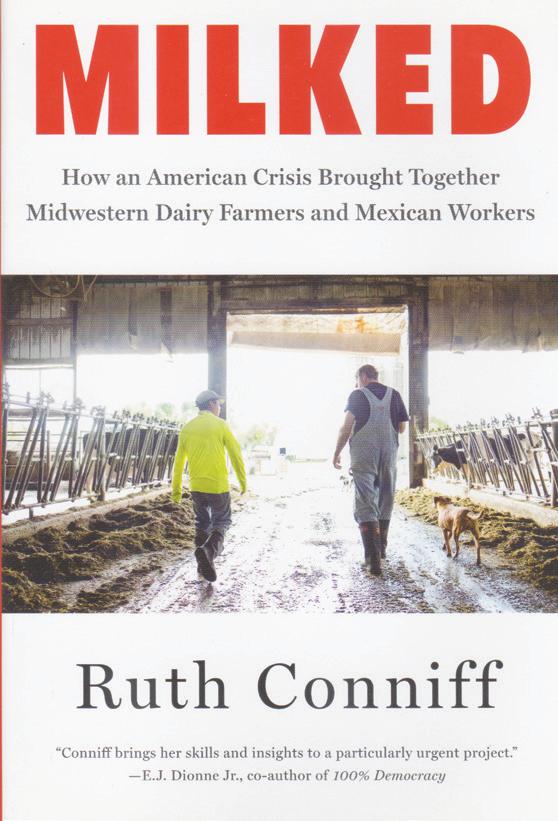
Farm policy impacts everyone featured in this book, and politics are examined via multiple lenses. Conniff finds American dairy farmers who voted for Donald Trump, believing his statements against the North American Free Trade Agreement (NAFTA) would lead to improved policies for family
farms. Many share their dislike of his derogatory statements about Mexicans, but also praise his administration’s COVID relief funds directed at agriculture. Conniff also finds farmers who identify as progressives, who represent the “F” in Minnesota’s DFL, and who hold out hope that the Biden administration will provide work permits and a path to citizenship for the Mexican workers spending years away from their families and keeping the dairy farms afloat. Conniff’s journalistic experience shines in the nuanced political views she uncovers. Because her focus is on the individual people, the book brings policies to life without exaggeration or outrage. People share conflicting feelings and lament some past decisions with hindsight, showing how complex agricultural policy is and how challenging it is for the farmers who are feeling the impacts while engaging in physically and mentally taxing work. There are no easy answers presented in this book, but there are signs of hope.
Woven throughout are poignant moments of connection, guiding the reader to an understanding of the similarities between American dairy farmers and the Mexican workers they rely on. Conniff does not romanticize farming or the relationships between employer and employee, but she presents them in their own words in ways that highlight their humanity. She travels to Mexico on a trip with Wisconsin farmers, organized by a nonprofit organization founded by a high school Spanish teacher who helped bridge language and cultural gaps between the farmers and the workers. While their Mexican employees remain in Wisconsin, keeping the farms running, the farmers visit the families of their workers, bringing gifts and seeing the homes and farms being built with their wages. Relationships are made, deep understanding is reached, and lives are changed. But, back home, a small number of other farmers take advantage of their undocumented workers. Conniff introduces the reader to all of it: the good as well as the bad.
In addition to a deeper understanding of the industry and the people involved in it, this book brought home two major points for me. The first is the challenging and uplifting story of people finding common cause. Voces de La Frontera, a membership-based
Because individual people connect, share their stories, and work together, change is proven possible. These types of stories are particularly critical to hear right now.
community organization headquartered in Milwaukee, Wis., that focuses on protecting and expanding civil rights and workers’ rights, finds common cause around immigration policy with the Wisconsin Farmers Union and the milk industry lobby. Because individual people connect, share their stories, and work together, change is proven possible. These types of stories are particularly critical to hear right now.
The second point is quietly woven throughout the multitude of personal stories and perhaps best summed up by Conniff in the book’s epilogue when she discusses how the pursuit of happiness seems to be foundational to what the United States is all about. She writes, “But in reality it seems that we are only engaged in pursuit. When do we get to the part where we are happy?” Her interviewees, both American and Mexican, reflect on how much more pleasant life is in Mexico, and not simply because temperatures do not drop below zero the way they do in the Upper Midwest. In that part of the world, there is a focus on family and community, gathering to celebrate, and taking time to relax rather than constantly work. Conniff contrasts a Mexican agricultural researcher advocating modesty and sustainability in economic models so there is enough for everyone with a U.S. economist who believes the root cause of poverty in the state of Oaxaca is the lack of ambition in its people. Similarities are highlighted in this book, and so are differences from which all involved can learn. Get big or get out changed the American dairy industry immensely. NAFTA did the same to Mexican agriculture. Milked uncovers the impacts of these types of policies on people and communities. In some ways, it is bleak. In other ways, it is heartwarming and uplifting. Ultimately, it is reality; a reality we all need to understand in order to make better, more humane policy going forward. p
Land Stewardship Project member Gina Johnson spent many hours volunteering in the former White Bear Lake office of LSP before moving away from her home state of Minnesota. Now located in Denver, Colo., she continues to support sustainable farmers in the Upper Midwest and the West.
The Land Stewardship Letter No. 1, 2023 31
Grain By Grain
A Quest to Revive Ancient Wheat, Rural Jobs, and Healthy Food
 By Bob Quinn & Liz Carlisle 268 pages Island Press islandpress.org/books/grain-grain
Reviewed by Dana Jackson
By Bob Quinn & Liz Carlisle 268 pages Island Press islandpress.org/books/grain-grain
Reviewed by Dana Jackson

Liz Carlisle concludes the prologue to Grain By Grain by calling Bob Quinn, the voice of this book, “a genuine American hero.” Pretty extravagant praise. But by the time I got to the last page, I agreed with her. This Montana farmer, clad in his jeans, plaid shirt and cowboy hat, is a hero, not because he is a highly successful organic grain farmer/scientific researcher/entrepreneur/businessman, but because of the way he measures success.
Bob Quinn tells about growing up near the small town of Big Sandy (it’s in central Montana north of the Missouri River), on a conventional wheat farm. His father was a Farm Bureau leader and early adopter of farm chemicals. An interest in science and scientific research led Quinn to the University of Montana-Bozeman, where he earned two degrees in botany, and then to the University of California-Davis and a doctorate in plant biochemistry.
As a graduate student at one of the premier agricultural institutions in the country, Quinn did not question how industrial chemical agriculture funded and directed university research — until he overheard his professor and a peach farmer laugh about fooling consumers into buying a tasteless, hard, unripe peach, deceptively made to look ripe by a chemical spray developed by the professor. By the time he finished his doctorate, Quinn had no ambition to become an agriculture research scientist. After a few disappointing years in a contract chemical research business with a friend, he decided to return to the family farm in Montana with his wife and children.
The agricultural community Quinn returned to in 1978 was very different from
what it looked like in the 1950s and 1960s when he grew up. There were fewer people and businesses in Big Sandy and fewer farmers on the land, and the farms were huge, chemical-dependent and debt-ridden. He soon learned that 2,400 acres of industrial, commodity agriculture could not support his parents and his family of seven. But he didn’t want to buy out his neighbors and get bigger, which was the USDA solution. Thus began his first independent business venture.
Quinn founded the Montana Wheat Company in 1983 and direct-marketed his wheat to millers in California, whose buyers wanted to make whole grain bread. As demand grew, he started sourcing wheat from his neighbors and doubled his income in one year. Demand for organic wheat in California led him to experiment, learn from organic agriculture pioneers, and eventually convert to growing and marketing organic wheat. His scientific training had taught him that plants need nutrients and don’t care whether the source is chemical or organic. But he learned that providing nutrients through a healthy, organic soil made sense for the long term productivity of his fields. Also, by converting to organic production, he “recovered the economic value he’d previously lost to industrial processors and chemical companies.” Quinn became an advocate for organic production and in 1990 served on the board that set the first USDA national organic standards.
Once his grain marketing business was established, Quinn bought a stone mill to make real whole wheat flour and renamed his company Montana Flour and Grains. Then he began experimenting with an “ancient grain,” a wheat grown from some large seeds someone had given him at a county fair when he was a kid, seeds his father had kept and propagated. He trademarked this wheat as “Kamut” and sold it to Arrowhead Mills, an organic products company that turned it into breakfast cereal, pancake mix, and pasta. As the market grew, Quinn helped other farmers grow Kamut organically, and his company bought it for triple what they would earn from conven-
tional wheat. Farmers liked that Quinn had trademarked Kamut, instead of patenting it like Monsanto, and they could save their own seed. A buyer from Belgium bought some Kamut, and within a couple of years Quinn’s Kamut International Company was selling as much in Europe as in the U.S. He also established Big Sandy Organics as a way to process the grain and make Kracklin Kamut, a snack similar to corn nuts. All along this journey, Quinn made money, and so did those he brought into the production, processing, and marketing businesses.
Quinn describes further business ventures, included raising dryland, non-irrigated organic vegetables and fruits, and safflower seeds which were processed into oil to use as tractor fuel. He started a company to build Montana’s first ever commercial scale wind farm, although by the time the process received approval, another company won the contract. Quinn still considered the effort a great success.
In the chapter called “Bringing Rural Jobs Back,” Quinn explains how he measures success. His 4,000-acre farm (he did acquire more land) equals roughly a dozen homesteads, so in order to bring back “neighbors he has lost” to the industrial wheat economy, he needed to create enough jobs and value-added enterprises for 12 families. He quotes a study that showed counties with organic agricultural activity had economic advantages over those that didn’t. Although labor and management costs were higher (providing local jobs), organic producers didn’t pay for expensive inputs, so net profits were greater. Quinn summed it up: “I’d rather put a dollar in my neighbor’s pocket than send another dollar off to Monsanto.” Health problems attributed to gluten in wheat, which led to the invention of many “gluten free” flour substitutes, are discussed in the last part of this book. Some people who experienced bloating, cramping, and fatigue after eating products made with modern wheat bred for high yield, claimed that their symptoms were reduced when they consumed “ancient wheat” products, like Kamut pasta. Quinn the scientist initiated research in Europe that produced 30 scientific papers, cost Kamut International $2 million, and essentially confirmed the claims of Kamut’s customers. Although Quinn stopped his own research, he wished for it to continue at a larger scale with more foods so
Grain, see page 33…
32 No. 1, 2023 The Land Stewardship Letter
“I’d rather put a dollar in my neighbor’s pocket than send another dollar off to Monsanto.”
— Bob Quinn
…Grain, from page 32
society would learn the connections between human health and modern industrial food products.
In the prologue, Carlisle describes her role as “helping with some of the research and writing, mostly to draw out the larger context and significance of the events in the book.” Evidence of her work is in the
Ground Glass
An Essay
By Kathryn Savage
240 pages
Coffee House Press
coffeehousepress.org/products/ groundglass
Reviewed by Phoebe Eisenbeis
Minnesota writer Kathryn Savage’s book, Ground Glass, is a lyric essay about the relationship between humans and our environments — a relationship that can often be fraught. Savage explores the death of her father, motherhood, ecological grief and hope, communities affected by pollution, and the interconnection of land, life, and beings in her debut book, which is set largely in Minneapolis, Minn. One of the integral questions Savage asks is, “what place-history coursed in my blood?” In other words, how do we as humans hold the places we live and work and grow within our bodies? She begins this exploration when her father dies from gastric cancer. She links his cancer to the fact that they had long lived along the fence-lines of industry and she knew by the time of his death that “his cancer occurs at a slightly higher rate in areas that produce industrial waste and pollution.” She begins her journey of understanding her father’s death by visiting the Superfund and brownfield sites scattered throughout Minneapolis that connect to each other via miles of train tracks crisscrossing the Mississippi River. Savage examines how the map of Superfund sites in Minnesota and across the country is closely linked to the distribution of low income and BIPOC (Black, Indigenous, people of color) communities, which in turn means these communities face the repercussions of these toxic areas. Savage writes, “It was nothing revolutionary I was confronting in my father’s death, just the hard truth that disease can be accelerated by lived experiences…Fence-line communities are also called ‘sacrifice zones.’ ”
notes at the end of the book. I was surprised that the notes do not reference AERO (Alternative Energy Resources Organization), which was at the root of food systems development in Montana in the 1990s, or its Farmer Rancher Resource Groups that Quinn participated in. Ken Meter’s 2021 book, Building Community Food Webs (see page 14), describes the 1990s in Montana as a period when many people worked in coalitions to develop and market products
Savage is well aware that such “sacrifice zones” have a profound impact on the people living there. “I am both who and where I come from; I echo,” she writes at one point, adding, “…the body is in sublime entanglement with the natural world.” Without our choice, we are often subject to whatever it is our environments hold. We can easily take in the pollutants that surround us, especially if we live in a polluted place for a long time or work with toxic materials. Although Savage is writing primarily about urban sacrifice zones, industrialized agriculture operations such as CAFOs can create sacrifice zones in rural areas as well, polluting the soil, air, and water of farm landscapes. Even if sacrifice zones in urban areas are more heavily populated by people, sacrifice zones in rural areas can be just as devastating and toxic for the landscapes and communities that face this pollution.
This book asks about the ways that we can choose to be in better relationship to our environments and to our communities (which include non-human beings). Savage shares the ways that she has formed relationships with her environment and neighbors by joining in conversations about pollution, toxicity, and activism. She answers these big questions through witnessing and learning about these polluted environments, as well as by including other voices in her narrative to show how the experience she faces is more broad than one might think. From Minneapolis to Birmingham to Oklahoma, Savage includes contributions from other women facing the damage of Superfund sites and brownfields, and connects these experiences and stories, giving these issues of racial, economic, and environmental justice a platform.
Savage also discusses growing food for herself through involvement in a community garden and how this experience draws her closer to a deeper relationship to
from crops they could grow locally. Quinn is a hero for creating businesses with local jobs, but he succeeded in a social/economic climate created by the interests and efforts of many people working together, all of them heroes. p
Former Land Stewardship Project associate director Dana Jackson co-founded the Land Institute in Salina, Kan.
the earth: “What I want is to be in a better ecological relationship with where I live.” Yet, she questions if the community garden’s location on a brownfield will cause the vegetables she grows to be toxic. This is, of course, a common concern, especially in urban farming and gardening and as people become more aware of how complex (and vulnerable) the soil biome is. Savage and the other storytellers in the book understand the dangers and necessity of tending to the earth, and yet, she does not see these dangers as outside of herself.
She wonders if there is “something humbling and revolutionary in understanding myself as a site of contamination.” This is an idea that causes us to bridge the gap between ourselves and our environments and see the interconnections. This may be the greatest motivation to understand and love our environment — when we see ourselves as embedded within our landscape, which can, and often does in our current times, include toxic environments.
Savage asks, “How to nurture in the midst of such crisis? How to grieve and speak to the future?” These are questions that address our current climate catastrophe as well as the everyday violence we are subject to by living in toxic environments. This book attempts to answer this through the connections Savage forms with activists, mothers, and earth stewards who believe in a “toppled” world “reborn.” Or at least a world where humans may find right relationship with our environments.
These meditations on ecology, grief, and interconnection are poetic, well-researched, and altogether insightful into the ways that we, no matter where our intersections of work and life lie, can understand and heal our relationship to our environments. p

The Land Stewardship Letter No. 1, 2023 33
Phoebe Eisenbeis is a writer, artist, and farmer living in Minnesota.
Membership Update
‘The Kind of Hope That Makes You Want To Roll Up Your Sleeves’
Robin
Wall Kimmerer
By Elizabeth Makarewicz
Keynote Marks 40 Years of LSP
On a cold evening in January, over 300 members and supporters gathered virtually to celebrate the Land Stewardship Project’s 40th Anniversary. To commemorate the occasion, esteemed scientist, poet, and author of the New York Times best-selling book Braiding Sweetgrass, Robin Wall Kimmerer, offered a keynote presentation. Highly revered for her ability to artfully weave Indigenous wisdom and culture with scientific inquiry, Kimmerer brought together a diverse audience of farmers, climate and Indigenous rights activists, local food enthusiasts, and those curious about the natural world.
Kimmerer’s keynote was aptly framed by stories from both longtime and newcomer LSP members. Board chair and sheep farmer Beth Slocum kicked things off by highlighting some of the many ways LSP members have worked to “fight the worst, while promoting the best.” Next, audience members heard from longtime farmer-member and former LSP staffer Audrey Arner, who beautifully described the “support, learning, and gumption” of LSP members, who she credits with her farm’s transition to a perennialized, regenerative model in keeping with the rhythms of nature. Another LSP conservationist-farmer, Tom Cotter, praised LSP’s supportive network that effectively equips stewardship farmers with the tools they need to make positive change on their land. Member Tim Ahrens, who co-hosted the event with LSP staffer Clara Sanders, shared snippets of his experience fighting a factory farm in his community in southeastern Minnesota’s Winona County.
Visibly impressed with the accomplishments and heart shown by LSP members over the decades, Kimmerer remarked, “You don’t need me here at all! I want to sit and listen to you all and hear your stories, because I think we’re really closely aligned in our love of the land.”
And yet, Kimmerer’s words went on to inspire all in attendance. She shared a Po-
“I want to sit and listen to you all and hear your stories, because I think we’re really closely aligned in our love of the land,” said Robin Wall Kimmerer, shown here being interviewed by LSP farmer-member Jennifer Rupprecht.

tawatomi story of justice, Nagaan ge bezhig emkwaan, or the story of the dish with one spoon, an allegory of care for Mother Earth and equitable distribution of resources. In conversation with LSP member Jennifer Rupprecht, a southeastern Minnesota pasture-based beef and flower farmer, Kimmerer went on to highlight other stories that give “the kind of hope that make you want to roll up your sleeves.”
the group Friends of Lake Hiawatha (FLH). FLH activists encourage Minneapolis city council members to incorporate Indigenous stewardship and other cultural practices into their long-range plan for Lake Hiawatha and the surrounding area. Another newcomer from Northfield, Minn., Matt Rohn, shared that he was a retired environmental studies professor and longtime fan of Kimmerer’s work. Rohn was delighted to learn his donation to LSP’s 40th Anniversary Impact Fund made him a member, and he looks forward to getting more involved.
These words of wisdom will surely carry LSP members into the next 40 years of work in support of people and the land. In the days following Kimmerer’s address, LSP staffers took account of the members in attendance. In addition to many recent and longtime members, over 150 new and rejoining members connected with LSP through the keynote — likely a record for any single LSP event. I had the opportunity to speak with a few of these new-to-LSP folks, and learned that many of them have been dedicated advocates for the land in their communities for many years. They were appreciative of the opportunity to learn more about LSP’s good work. One such new member, Sean Gosiewski, has been active in his south Minneapolis community through
To those new members who joined LSP through our event with Robin Wall Kimmerer, and through other organizing efforts this past year: Welcome! To be a member of LSP is to be a part of our region’s movement for a more sustainable and just food and farming system.
For several years, a quotation from Kimmerer has accompanied LSP’s thank-you cards to members: “As we work to heal the earth, the earth heals us.” The work ahead of us is great, but how comforting to be reminded of the strength and resilience of our LSP community as we continue to fight for transformation on the land. p
LSP membership support specialist Elizabeth Makarewicz can be contacted at emakarewicz@landstewardshipproject.org or 612-400-6354.

34 No. 1, 2023 The Land Stewardship Letter
“As we work to heal the earth, the earth heals us.”
— Robin Wall Kimmerer
Membership Questions?
If you have questions about your Land Stewardship Project membership, contact Clara Sanders at 612-400-6340 or csanders@ landstewardshipproject.org To renew, mail in the envelope included in this Land Stewardship Letter , or see landstewardshipproject.org/join.
New Address?
Has your address changed or do you anticipate moving in the next few months? Take a moment to update your address with LSP so that you can continue receiving the Land Stewardship Letter, event invitations, and other updates. To update your address, see landstewardshipproject.org/address. Make sure you use the same e-mail address you have on file with LSP so your data updates correctly.
Volunteer for LSP
The Land Stewardship Project literally could not fulfill its mission without volunteers. Volunteers help us do everything from stuff envelopes and make telephone calls to enter data and set up logistics for meetings. Remote opportunities are available.
To volunteer, fill out the form at landstewardshipproject.org/volunteer-for-lsp or contact Clara Sanders at csanders@landstewardshipproject.org, 612-400-6340.
In Memory & in Honor…
Book Honors Joe Morse
For more than half-a-century, Land Stewardship Project member Joe Morse was a troublemaker — making “good trouble” as civil rights leader and Congressman John Lewis would put it. Before he died in 2017, Morse experienced a lifetime in the forefront, at the grassroots, of the ongoing struggles against racism, war, environmental degradation, violence against women, and the struggle to empower the powerless and disenfranchised. This work included deep involvement with LSP’s Winona County organizing, including the successful campaign to ban frac sand mining in the county.
Morse’s life well lived is now being honored in No Ordinary Joe: Lessons from a life of community organizing for social change, a first-person narrative that was published this spring. This book describes Morse’s organizing life as he told it to his longtime friend and collaborator, Doug Nopar, and in other conversations (Nopar is a former LSP organizer). These conversations have been organized into a narrative by Jerome Christenson, a longtime Winona journalist and writer. Copies can be ordered at https://amzn.to/3BCuOis. p
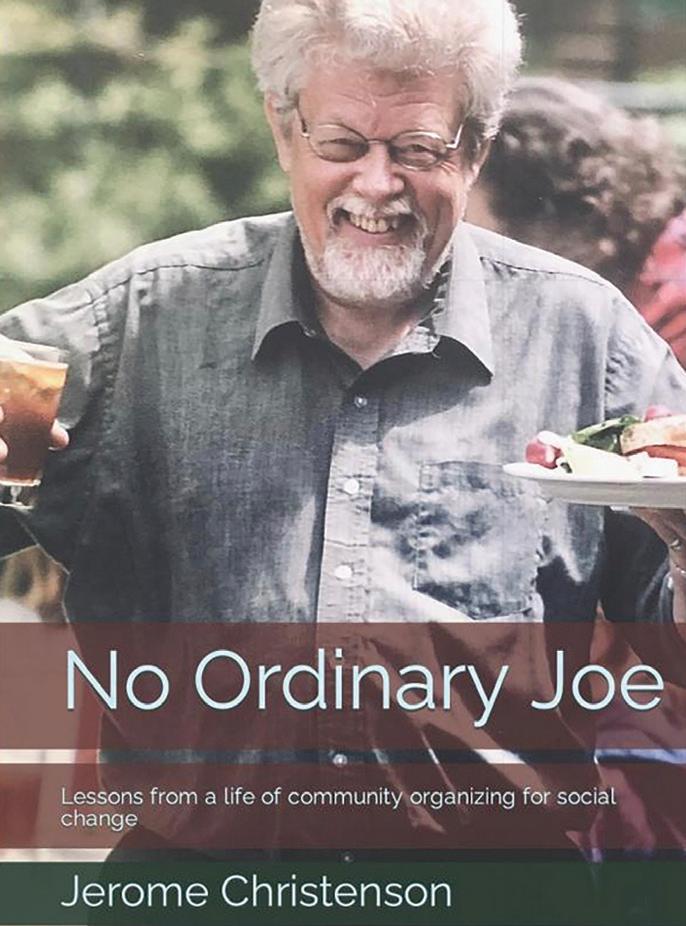
The Land Stewardship Project is grateful to have received the following gifts made to honor and remember loved ones and friends:
In Honor of Maland Farms & Harlan Maland of Faribault County
u Jane Maland Cady
In Honor of Alan & Judy Hoffman
u Margie & Buzz Birnbaum
In Honor of all CSA Farmers & Employees
u Debra Hoffman
In Honor of the LSP Staff
u Dayna Burtness
In Honor of Wally Simpson & Donald Simpson
u Anonymous
In Honor of Farm Kids
u Joan & Nick Olson
In Honor of Doug Nopar
u Joyce Belgum & John Gabb
In Honor of the Earth Who Raised Us
u Benjamin Gorman
In Honor of Steve Anthony’s Birthday
u Hope Brogunier
In Honor of Patty Wright & Michael Racette
u Erica Perl & George Socha
In Honor of Dana Jackson’s Great Contributions to the Land & LSP
u Susan & Wendell Fletcher
In Honor of Robin Moore & Her Work with Farm Transitions
u Helen & Don Berheim
In Honor of the Birthdays of Rob & Melissa Gordon
u Dale Hadler
In Honor of Nick Gardner’s Kernza Commitment
u Joan Gardner
In Honor of Jim Jarvis’s Birthday
u Clare & Sharon Jarvis
In Honor of All the Women, Lesbian & Gender Non-conforming Farmers Who Came Before Us
u Erika Thorne
In Honor of the School Sisters of Notre Dame-Mankato Campus, which is Celebrating Jubilee in 2023
u Sister Kathleen Mary Kiemen
In Memory of William Murphy
u Darlene Coffman
In Memory of Paul Drenckhanh
u Jessie & Steve Pinney
In Memory of Mariellyn Kuske
u Sister Kathleen Mary Kiemen
In Memory of Howard Hadler
u Dale Hadler
To donate to LSP in the name of someone, contact Clara Sanders at 612-400-6340 or csanders@ landstewardshipproject.org. Donations can be made online at landstewardshipproject.org/join.
The Land Stewardship Letter No. 1, 2023 35
LAND STEWARDSHIP PROJECT
821 E 35TH ST STE 200
MINNEAPOLIS, MN 55407-2102
Address Service Requested
Your timely renewal saves paper and reduces the expense of sending out renewal notices. To renew, use the envelope inside or visit landstewardshipproject.org/join.
Stewardship Calendar
➔ AUG. 1 — Early Bird Discount Registration Deadline for 20232024 LSP Farm Beginnings Class (see page 23)
➔ AUG. 5 — LSP Pasture Walk on Goat Grazing, Caledonia, Minn. Contact: landstewardshipproject.org/2023-pasture-walks
➔ AUG. 19 — LSP Pasture Walk on Custom Grazing Dairy/Beef Heifers, Rushford, Minn. Contact: landstewardshipproject.org/ 2023-pasture-walks
➔ AUG. 22 — Composting Field Day, Jordan, Minn. Contact: Maura Curry, LSP, mcurry@landstewardshipproject.org, 651-249-6308
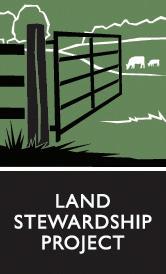
➔ SEPT. 1 — Final Registration Deadline for 2023-2024 LSP Farm Beginnings Class (see page 23)
➔ SEPT. 8-9 — Soil Health & Hemp Day with Tom Cotter, Austin, Minn. Contact: Minnesota Soil Health Coalition, mnsoilhealth.org
➔ SEPT. 21 — LSP Pasture Walk on Stockpiling Forage for Late Season Grazing, St. Charles, Minn. Contact: landstewardshipproject. org/2023-pasture-walks
➔ SEPT. 30 — Current Farm Bill Expires (see page 12)
➔ OCT. 19 — LSP Pasture Walk on Managing Pasture & Feeding Strategies, Lake City, Minn. Contact: landstewardshipproject. org/2023-pasture-walks
➔ NOV. 1 — LSP Pasture Walk on Winter Grazing of Summer Annuals, Dover, Minn. Contact: landstewardshipproject.org/ 2023-pasture-walks
➔ NOV. 10 — First Class Session of the 2023-2024 LSP Farm Beginnings Course (see page 23)
➔ WINTER — LSP Workshop Season Begins. Contact: landstewardshipproject.org/upcoming-events
➔ FEB. 12 — 2024 Session of the Minnesota Legislature Convenes (see page 7)
➔ MARCH 19 — Last Class Session of the 2023-2024 LSP Farm Beginnings Course (see page 23)
➔ SPRING — LSP Field Day Season Begins. Contact: landstewardshipproject.org/ upcoming-events
Latest LSP Events: landstewardshipproject.org/ upcoming-events
2023 Twin Cities Cookout July 27
The date has been set for LSP’s 2023 Twin Cities Cookout and Potluck. Join fellow members and supporters for an evening of fun, fellowship, and food on Thursday, July 27, from 5:30 p.m. to 9 p.m., in the yard at LSP’s Minneapolis office (821 East 35th Street). We are bringing the potluck back this year, so please bring a dish to pass. LSP will also provide grilled meats/ veggie protein, buns, condiments, and drinks. To RSVP, register at bit.ly/TwinCitiesCookout.
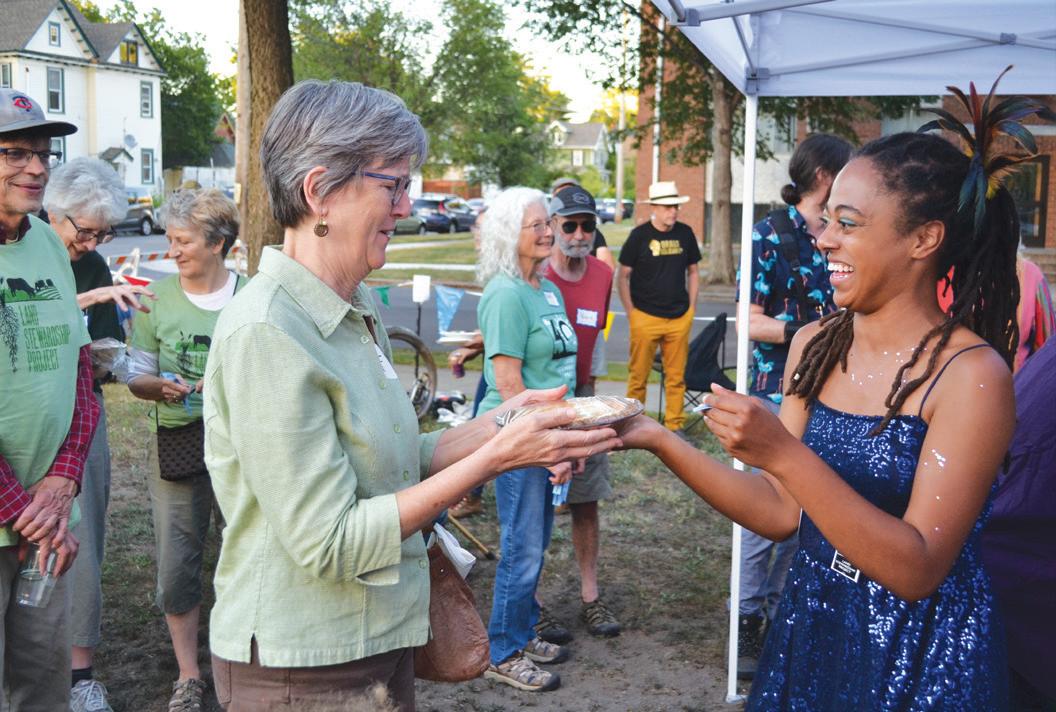
Contact LSP’s Elizabeth Makarewicz at emakarewicz@ landstewardshipproject.org with questions, to volunteer, or to donate to our silent auction or pie raffle. (LSP Photo)
Go Public With Your LSP Support
There are numerous fun ways you can show your support publicly for the Land Stewardship Project. LSP has available for purchase t-shirts ($20), caps ($20), window decals ($3), tote bags ($15), 8 x 10 metal barn signs ($20), and the classic “Let’s Stop Treating Our Soil Like Dirt” bumper stickers ($3). Order any of these items today at landstewardshipproject. org/shop or by calling LSP at 612-722-6377.

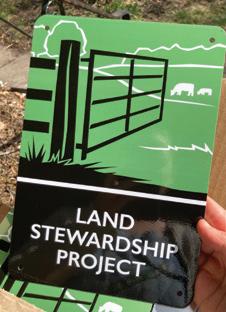

NONPROFIT ORGANIZATION U.S. POSTAGE PAID ROCHESTER, MN PERMIT NO. 289
36 No. 1, 2023 The Land Stewardship Letter
Bumper Sticker Cap Metal Barn Sign








































 Johnson
Johnson

 By Bob Quinn & Liz Carlisle 268 pages Island Press islandpress.org/books/grain-grain
Reviewed by Dana Jackson
By Bob Quinn & Liz Carlisle 268 pages Island Press islandpress.org/books/grain-grain
Reviewed by Dana Jackson








